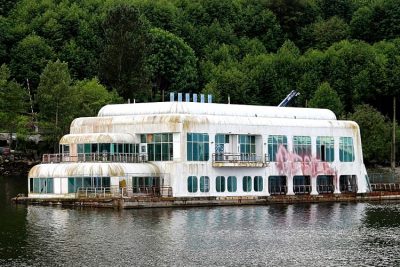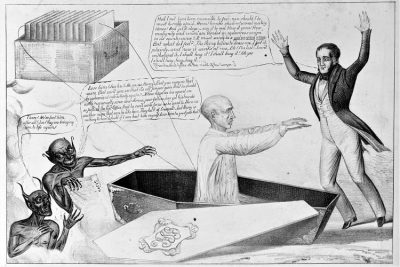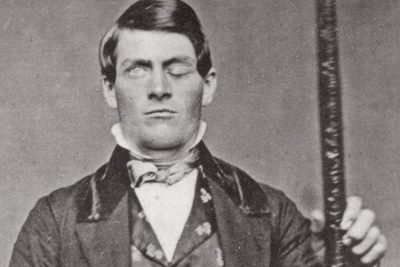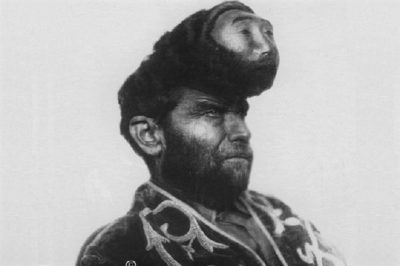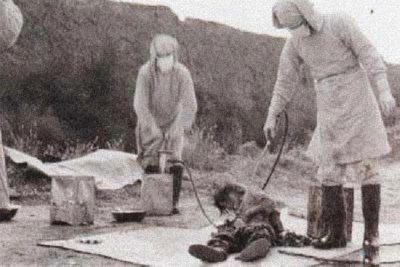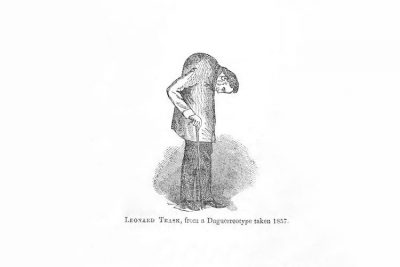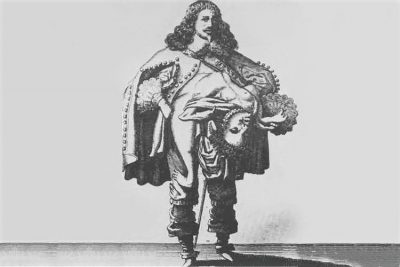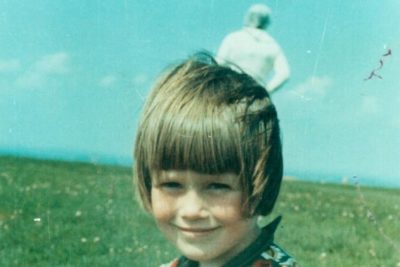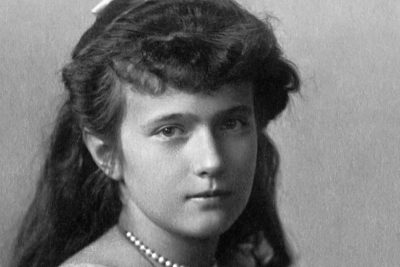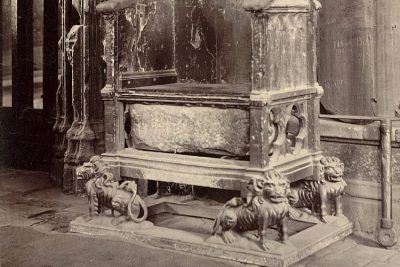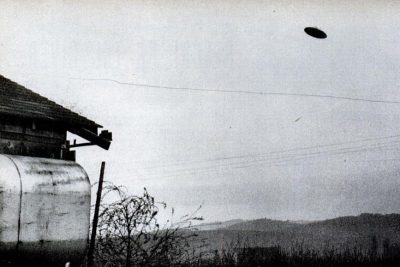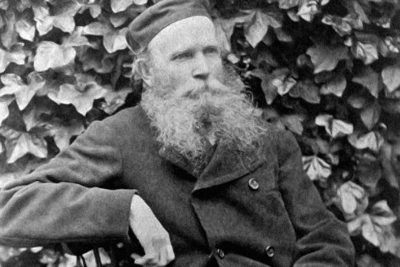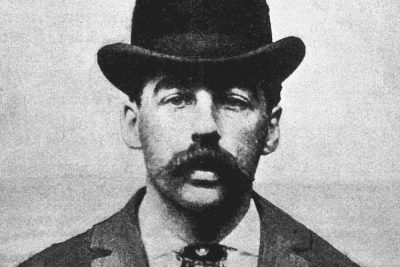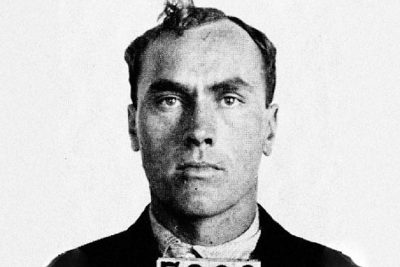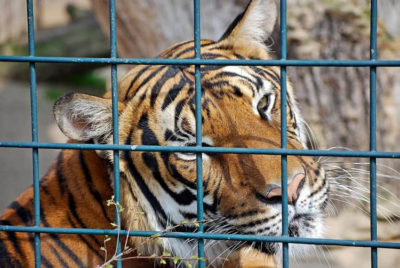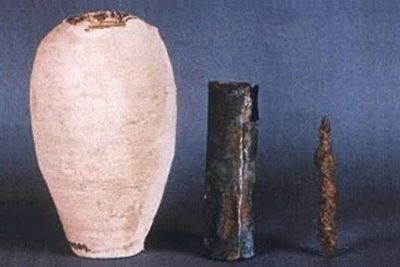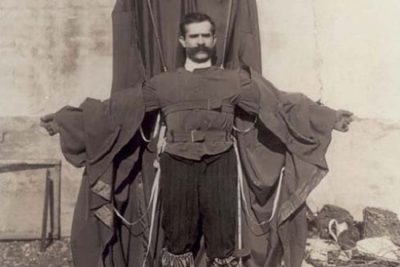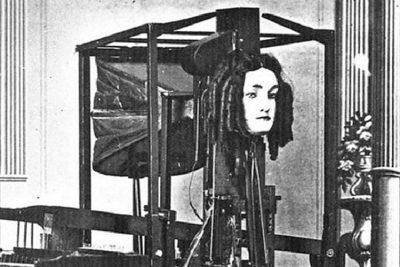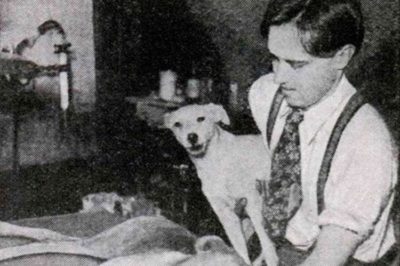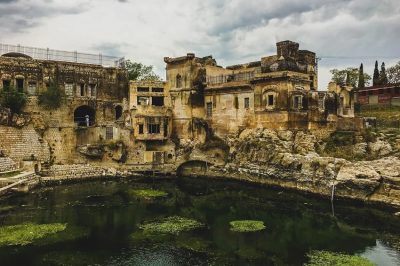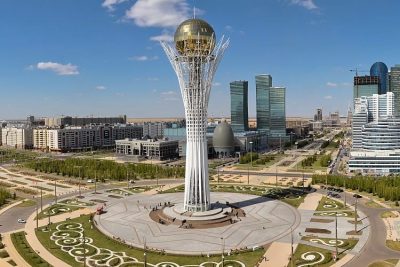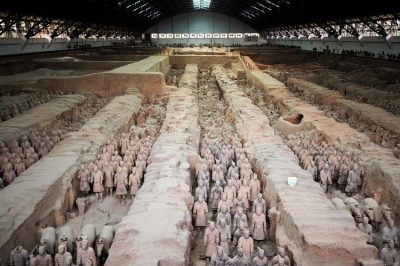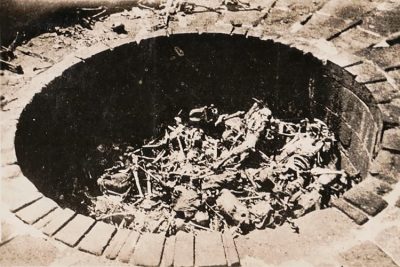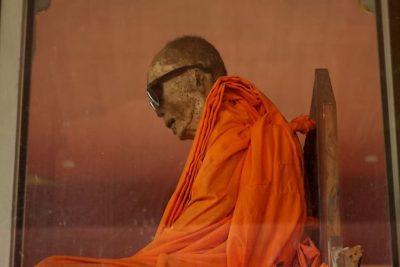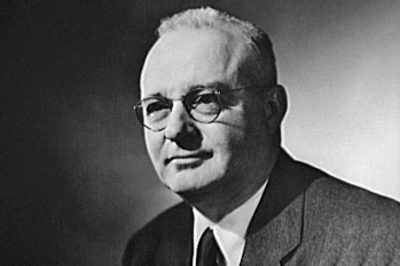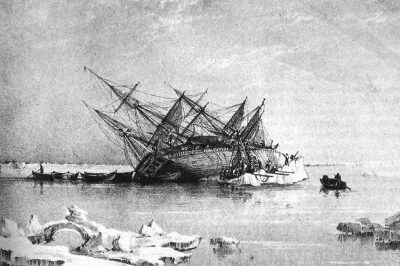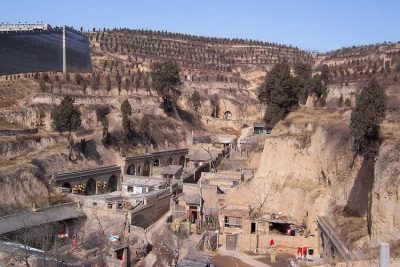The post Kardashev Scale: Measuring a Civilization’s Level of Technology and Its Potential to Advance appeared first on .
]]> Famous astronomer Carl Sagan commented we are in a period of “… technological adolescence.” At this period in time, humans have existed only 0.0015% of the total time since the universe was created. That is over 13.8 billion years and counting. It shows how young we are and also illustrates our extreme potential in that we have taken over our planet so quickly. To test and measure this human capacity, in 1964 Soviet and Russian astrophysicist Nikolai Kardashev devised a scale—Kardashev Scale. This would measure our potential and skill to go beyond the realms of our universe and build an alternative life.
Famous astronomer Carl Sagan commented we are in a period of “… technological adolescence.” At this period in time, humans have existed only 0.0015% of the total time since the universe was created. That is over 13.8 billion years and counting. It shows how young we are and also illustrates our extreme potential in that we have taken over our planet so quickly. To test and measure this human capacity, in 1964 Soviet and Russian astrophysicist Nikolai Kardashev devised a scale—Kardashev Scale. This would measure our potential and skill to go beyond the realms of our universe and build an alternative life.
It is widely accepted that this potential will increase so much so we will have the power to not only control our own planet but control other astronomical bodies in the universe, and implement and create new ones. Even to the point of creating new or parallel universes, changing reality and time and space as we know it.
Nikolai Kardashev and The Scale He Built
A troubled earlier life during the Russian Revolution–his father was killed and his mother sent to a labour camp–did not affect his ambition and aptitude for astrophysics. Originally looking for extraterrestrial life using cosmic signals, Kardashev created a scale to measure a civilisation’s level of technological advancement based on the amount of energy it can consume.
It is a logarithmic method meaning that the parameters will constantly change, in this case, the amount of energy a civilisation can produce will increase substantially. When the scale was calculated in the 60s for example, Earth was ranked at type I in the chart while now it has been demoted to type 0. Simply, because we have discovered more about the potential energy the universe holds and the amount we can extract from it.
Types of Civilisation
Originally, there were three types formulated by the Russian. Type I, II and III.
The energy level of consumption per year is as follows:
Type I – 10¹⁶W, (10,000,000,000,000,000 Watts)
Type II – 10²⁶W,
Type III – 10³⁶W.
 Type one is considered a Planetary civilisation—the smallest type like Earth. However, as mentioned, Earth has not reached this stage because we still produce most of our energy from dead matter, with renewable power still in its infancy. This is changing but in 2015, nuclear, hydro and sonar energy were only 30% of the total world’s consumption with the planet remaining heavily reliant on fossil fuels. Earth consumed only 17.35 Terawatts of energy or 17350000000000 Watts, a far cry from 10¹⁶W. For reaching Type I, we will need to harness all available energy from our nearest host star–the Sun.
Type one is considered a Planetary civilisation—the smallest type like Earth. However, as mentioned, Earth has not reached this stage because we still produce most of our energy from dead matter, with renewable power still in its infancy. This is changing but in 2015, nuclear, hydro and sonar energy were only 30% of the total world’s consumption with the planet remaining heavily reliant on fossil fuels. Earth consumed only 17.35 Terawatts of energy or 17350000000000 Watts, a far cry from 10¹⁶W. For reaching Type I, we will need to harness all available energy from our nearest host star–the Sun.
Another requisite of Type I is being able to control the geographic phenomena of one’s planet such as weather and volcanos. It sounds unbelievable, but not if you remember the old cliché of technology one hundred years ago compared with today. Famous American-Japanese physicist Michio Kaku believes we will reach Type I in less than two hundred years–barring any apocalyptic events.
Type II is a stellar civilisation, not only using the energy of one’s nearest host star but controls it too. The power achieved could transfer energy anywhere in the solar system, a proposed way of doing so via hypothetical solar-powered satellites called Dyson Sphere–the brainchild of Freeman Dyson. They are commonplace in many Sci-Fi films. Alternatively, nuclear fusion (gaining energy from the heat of reactions) is another process. If so, we could control every planet and asteroid in the galaxy. Michio Kaku believes this is possible in two thousand years max. Reaching this stage would make civilisation immune to extinction on a global scale.
Type III–the galactic civilisation does not bear thinking about. We humans today, with our limited electronic symbiosis, would be a primitive footnote if we made it there. We are talking about the potential to consume energy from our galaxy and other galaxies, harness the power from billions of stars, black holes, the ability to travel anywhere in the universe at high speeds, even in the blink of an eye and the aptitude to change and create galaxies. Simply put, the universe would become our playground. Kaku believes this will take anywhere from 100,000 to one million years.
There are now two more levels proposed, such has been the advances in technology. These are less accepted and are fairly similar to Type III.
Type IV – requires 10⁴⁶W
Type V – “the energy available to this kind of civilization would equal that of all energy available in not just our universe, but in all universes and in all timelines.”
Type IV would result in the complete manipulation of the universe to the point of manipulating space and time. Type V would be similar but not just in our observable universe but anything beyond. Ultimately, creating multiverse, parallel universes, manipulating reality as we know it.
The Future
It’s funny to think all this potential could disintegrate in a split second if our fragile civilisation becomes extinct. It has happened many times in the past, one of the most famous being the disputed Toba Catastrophe. Although it can also be argued that even if our civilisation perished, the laws of the universe would not change so surely the next civilisation be it in one thousand years or one billion could reach these points. To be honest, all of this gives more rise to simulation theory.
Either way, if Michio Kaku is correct, we have a few thousand years to protect ourselves and our planet before science can protect it for us. If our civilisation wants to achieve the impossible, then the race is well and on.
Enjoyed this article? Also, check out “Gliese 581g: A Habitable Exoplanet or Just Another Celestial Object Orbiting a Star?“.
For more unusual stories & intriguing news follow STSTW Media on Instagram and Facebook. Also, join our live chat discussion on Twitter.
Do you have a story/photo for us?
We welcome your contribution at [email protected]. Please include your name, city, state, and country.
Fact Analysis:
STSTW Media strives to deliver accurate information through careful research. However, things can go wrong. If you find the above article inaccurate or biased, please let us know at [email protected].
RELATED
The post Kardashev Scale: Measuring a Civilization’s Level of Technology and Its Potential to Advance appeared first on .
]]>The post Nixon’s Pyramid: The $6 Billion Safeguard Program Which Lasted One Day appeared first on .
]]>
The Pyramid of North Dakota. (Library of Congress)
In the United States, on the border of North Dakota, in a small village called Nekoma (a village that holds around 50 people) near Canada is a $6 Billion construction which was more or less abandoned. This an anti-ballistic missile system (ABM) in the shape of a pyramid, known as the Stanley R. Mickelsen Safeguard Complex, was built as a defence system for US missile silos to protect mainly against the Soviet Empire during the Cold War. They would protect America’s missiles by intercepting any threat which entered Earth’s orbit. There were twelve buildings planned in the 1960s all across the States, but construction did not start until the 1970s.
In 1972, however, President Nixon and Soviet leader Leonid Brezhnev signed the Anti-Ballistic Missile treaty. It meant each country could have two anti-missile centres, but by 1974 another treaty was reached for each country to only have one. This stopped construction of the other eleven before they even started laying bricks. The remaining complex in North Dakota was operational for a mere 24 hours before being the program was cut, the government citing it was too costly to run.

Part of the Stanley R. Mickelsen Safeguard Complex. (Terry Robinson/Flickr)
The workings of the Safeguard Program
Missiles are guided and powered by explosives driven by engines with fuel. They use ‘contact fuses’ to explode on impact. Missiles are classified depending on their range, anything greater than 5,500 km is an intercontinental missile. Most of these missiles are lost by the time it reaches outer space with only the ‘post-boost vehicle’ or ‘re-entry vehicle’ containing a nuclear warhead coming back to the ground.
The Safeguard Program was to protect missile silos holding missiles called LGM-30G Minuteman III. The program was evolved from Nike Zeus, Nike-X & Sentinel anti-ballistic missile systems, yet all were deemed not good enough and so Safeguard was initiated. The missiles in the Safeguard Program included thirty Spartan and sixteen Sprint missiles. There are two types of ballistic missiles–ones that follow a suborbital trajectory and those that travel a distance above the Earth. The Spartan missiles would target those incoming from outside the Earth’s atmosphere and the Sprint missiles–with a smaller range–would operate within. Out with the missiles, the system had a Perimeter Acquisition Radar and Missile Site Radar to detect any threats.
It became operational on the 1st of October 1975, only to be decommissioned the very next day by the House Appropriations Committee and Senate.
War’s an expensive game
The cost breakdown was confusing to say the least. An archived report illustrates this with breakdowns on cryptic deductions. There was $112 million spent in materials, $481 in ‘lost effort’–such as excess equipment and materials, restoration of the site – and $697 in ‘schedule changes’ – noting research and development, procurement and construction. The report makes interesting reading and automatically relates to the idiom ‘more money than sense’ however the minds running this project must have been highly intelligent. It is a staggering amount of money and leaves a lot of unanswered questions.
It is easy to say that allowing the building of this site was madness, but war–needless to say–is a difficult time for the governments involved. It would be nice to say the world is a different place now and maybe it has moved on a bit, but the money spent on fighting is still a staggeringly unjustifiable amount from a pacifist point of view. Yet, just how many programs like Safeguard have been commissioned and decommissioned over the years.
The Stanley R. Mickelsen Safeguard Complex still stands proud today, similar in look at least to the Great Pyramids of Egypt but without the lengthy history.
Enjoyed this article? Also, check out “Project MKUltra: CIA’s Cold War Conspiracy to Secretly Control Human Mind Goes Wrong“.
For more unusual stories & intriguing news follow STSTW Media on Instagram and Facebook. Also, join our live chat discussion on Twitter.
We welcome your contribution at [email protected]. Please include your name, city, state, and country.
Fact Analysis:
STSTW Media strives to deliver accurate information through careful research. However, things can go wrong. If you find the above article inaccurate or biased, please let us know at [email protected].
RELATED
The post Nixon’s Pyramid: The $6 Billion Safeguard Program Which Lasted One Day appeared first on .
]]>The post Bathing Machine: Popular Beachside Devices from the 18th Century appeared first on .
]]>
Early 20th century bathing machines in Sestroretsk, Russia. (Wikimedia Commons)
Nowadays, liberation is taken for granted in parts of the world. Places where men and women can openly bathe together on beaches, even sections exist which are permitted for both sexes to bathe nude. Take Spain, for example. In places like this, the fact that single men and women once had to be separated at the beach in the past is hard to imagine, and contractions like a bathing machine likewise. This was the case in the 18th and 19th Century in countries like the United Kingdom during a far more conservative time. For females, to be nude, half-naked, or wearing revealing clothes in public was frowned upon and even illegal in some cases, so a device was created to allow women to change clothes and bathe in complete privacy.

Horsemen moving bathing machine. (Wikimedia Commons)
How did bathing machines work?
During a trip to the beach, people with some money to their names, wishing to have a swim, would consider the use of a bathing machine. Predominantly, bathing machines were wooden cabins on large wheels which would be wheeled into shallow waters either by horses or people, some holiday resorts had rails to assist the vessels. Others could be roped in and out by steam engines. This was from a time when many people could not swim, or many people would be uncomfortable about changing clothes in public, or both. So they would venture to a place to a book a time for a bathing machine, like a doctor’s waiting room with tea and magazines.

A woman leaving the bathing machine. (Wilhelm Dreesen)
And upon their chance to swim, they would enter the cabin on the beach in their day-to-day clothes and change into their bathing attire or less. The cabin would then roll towards the water and submerge. Steps would help the person out of the cabin and into the water, and curtains further gave them privacy. People were employed, called dippers (of the same sex) – to assist the men and women in and out of the cabins or teach them how to swim. A flag would give signals to the dipper and beach. The point of the machine is to give people less chance of being seen naked or in revealing clothing by members of the opposite sex.

Bathing machines in Llandudno, Wales. (National Science and Media Museum)
History of the bathing machine
The origins of the bathing machine can be traced back to the 1750s probably due to the increase of holidaymakers to beaches. This followed many reforms conducive of the Great Bubonic Plague which started to dismantle the European Feudal System. Benjamin Beale is claimed to be the inventor of the machine in 1753. They became popular in the United Kingdom and countries of the British Empire mainly, adhering to conservative British culture with Queen Victoria was a famous user. By the 1900’s, segregation had near enough ended on beaches, people became better swimmers and did not want nor need to queue for bathing cabins. Mobile bathing machines started to simply become stationary changing rooms, some of which can still be seen today.
Enjoyed this article? Also, check out “Yellow Concrete Arrows Are the Last Reminders of Transcontinental Airway System“.
For more unusual stories & intriguing news follow STSTW Media on Instagram and Facebook. Also, join our live chat discussion on Twitter.
Do you have a story/photo for us?
We welcome your contribution at [email protected]. Please include your name, city, state, and country.
Fact Analysis:
STSTW Media strives to deliver accurate information through careful research. However, things can go wrong. If you find the above article inaccurate or biased, please let us know at [email protected].
RELATED
The post Bathing Machine: Popular Beachside Devices from the 18th Century appeared first on .
]]>The post Was Atomic Energy Kit the Most Dangerous Toy Ever Made? appeared first on .
]]>
An original Gilbert U-238 Atomic Energy Laboratory kit. The upper left section contains four jars of radioactive samples. (Webms / Wikimedia Commons)
The Atomic Energy Lab Kit or Gilbert U-238 Atomic Energy Lab was the name of the gadget released in 1950. The toy came in an enticing red box similar to the mythic board-game Jumanji but yet held actual, physical danger because the incredible fact about the Atomic Energy Lab Kit is it had actual sources of radiation including Uranium Ores inside. In this period the dangers of radiation were not yet studied, but can you believe a children’s toy held radiation? The toy was pricey at around $50, which in today’s money is over $520.
A. C. Gilbert had previous success with a metal toy construction set called ‘Erector’ which was like Lego but more like Meccano.

Advertisement for Erector Set, circa 1922. (Popular Science Magazine)

The Erector set. (Cullen328/Wikimedia Commons)
Read more: The 19th Century Mechanical Toy—The Creeping Baby Doll
Inside the box of Gilbert U-238 Atomic Energy Lab
An instruction manual, a comic book titled ‘How Dagwood Splits the Atom and a booklet Prospecting for Uranium’ outlined instructions on how to find Uranium. A Geiger counter made it possible to observe Uranium by using a gas-filled tube of inert gas to show particle collisions. A Wilson cloud chamber allowed the gamer to see vapour trails escape from particles.

An assembled Gilbert cloud chamber. (Science History Institute)
A spinthariscope was also included to show scintillation owning to alpha decay. An electroscope was another instrument to measure ionization radiation of the radioactive sources. This was found in alpha, beta or gamma sources, or Uranium ones. Ultimately, owners could source natural Uranium with the kit, for which the US government offered rewards.
The end of the Atomic Age
The toy did not sell well, but this was not due to the dangers of radiation, which were not discovered until later. Only 5,000 units of the toy were made before they discontinued it cited as being too expensive to produce. By the 1970s nuclear power had diminished after notable disasters such as the infamous Chernobyl accident in 1986. Such a toy would not be permitted today in most countries, as while the low radiation emitted would unlikely prove threatening, using it every day could cause problems.
For more unusual stories & intriguing news follow STSTW Media on Instagram and Facebook. Also, join our live chat discussion on Twitter.
Do you have a story/photo for us?
We welcome your contribution at [email protected]. Please include your name, city, state, and country.
Fact Analysis:
STSTW Media strives to deliver accurate information through careful research. However, things can go wrong. If you find the above article inaccurate or biased, please let us know at [email protected].
RELATED
The post Was Atomic Energy Kit the Most Dangerous Toy Ever Made? appeared first on .
]]>The post This is the World’s First Apple Computer and It Was Released in 1976 appeared first on .
]]>
Apple I Computer at the Smithsonian Museum. It was assembled entirely in a wooden case by the owner. (Ed Uthman/Flickr)
The Apple Computer I retroactively known as Apple I was the first Apple desktop Computer, which was released by the Apple Computer Company in 1976. Designed and built by Steve ‘Woz’ Wozniak, an electronic engineer and Co-founder of Apple Inc. (as it is now called) along with Steve Jobs. They started the company from Job’s parent’s garage. The idea by Wozniak to sell the computer was financed by Jobs selling his Volkswagen Van (his only means of transport) and Woz selling an important programming calculator for $500. Apple is now the 9th richest company in the world according to Forbes so it appears the sacrifices were warranted.

Advertisement for the Apple I computer. (Apple Computer Company, Palo Alto, CA.)
Read more: The IBM Chess Computer That Beat Chess Grand Master Garry Kasparov in 1997
Apple l: only 200 units in total were produced
After selling their prized possessions, the power of the Apple I computer was first demonstrated and sold in July 1976 at the Homebrew Computer Club in California, USA. A computer store called Byte Shop bought 50 units of the 200 total produced and sold each unit at a price of $666.66, a little over $2,800 in today’s prices.

Apple I was as a bare circuit board to be sold as a kit with no other electronic parts—that people could use to build the computer. (Narnars0/Wikimedia Commons)
Apple I was a circuit board containing over 60 chips. It was not complete with the purchase however, a case, power transformers, power switch, ASCII keyboard and composite video display was needed for it to be a working computer. It had MOS 6502 microprocessors and a primitive 4 KB RAM. Mostly designed as a video game machine, it used the BASIC programming system allowing games to be both programmed and played. The reason Apple I was a success was ease of access- a keyboard and a cheap television were all that was needed to display the functions of the machine. Competing computers would require a lot more hardware. It would be discontinued only one year later due to the success of Apple II.
Apple l today is a much sought-after collector’s item

A working Apple I computer. (Cynde Moya/Wikimedia Commons)
VICE News ran an article and video where a computer historian named Corey Cohen booted up an Apple I made 42 years ago, demonstrating that it still runs perfectly today. Less than 50 exist for Jobs and Wozniak offering trade-ins back in 1977, so only 6 are said to exist in working order. For this reason and due to the success of Apple, they have become a rare and much sought-after collector’s item. For instance, an original Apple I was sold in 1999 for $50,000 at an auction. In 2010 another machine with packaging (including a return label with Steve Jobs parents’ address and a personal letter from Jobs with trouble-shooting attached) reached $210,000. By 2012, the price had hit a staggering $374,500 and $351,276 on two separate auction listings. Then, two years later – $905,000 was bid for the latest Apple I to sell.
Read more: A WWII Era Cipher Machine was the First-Ever Programmable Computer
In today’s world, you are probably never more than 5 feet away from an Apple device with modern computers dominating the globe. It is reported that almost 50% of households in the world have access to a computer–that’s over 3.9 Billion people. This began largely with Apple Inc. and that accomplishment is absolutely incredible, especially if you consider that the work started from a garage by two Californian teenagers.
For more unusual stories & intriguing news follow STSTW Media on Instagram and Facebook. Also, join our live chat discussion on Twitter.
Do you have a story/photo for us?
We welcome your contribution at [email protected]. Please include your name, city, state, and country.
Fact Analysis:
STSTW Media strives to deliver accurate information through careful research. However, things can go wrong. If you find the above article inaccurate or biased, please let us know at [email protected].
RELATED
The post This is the World’s First Apple Computer and It Was Released in 1976 appeared first on .
]]>The post Wan Hu- The First Astronaut Propelled Into Outer Space? appeared first on .
]]>
Artistic depiction of Wan Hu launching himself into space. (NASA)
It is said the roots of this endeavour began as early as 6000 years BC when ancient cultures were trying to understand the qualities of celestial objects. In China, in an area dominated now by the Gobi desert, Wan Hu put into practice a mission to get closer to the stars. So does this mean his mission to step into outer space was successful?
Read more: Dressmaker Who Jumped off the Eiffel Tower Experimenting with Self-Designed Parachute-Suit
Seeking the stars

Wan-Hoo crater, on the far side of the moon. (NASA)
An obsession with the stars and space is not a modern concept. It has been observed and studied since ancient times in various ancient empires. For example, since the 6th Century BCE in Ancient China astronomical observations were kept. An astronomer called Gan De made a star map as early as the 4th Century BCE. A few centuries later it is reported that Wan Hu looked to get closer than any person had to the sky. Some reports state he lived as early as 2000 BCE while others place him in the Ming Dynasty around the 16th Century ACE.
Wan Hu strapped himself to a bamboo chair with forty-seven gun-powder filled rockets, and a large kite system for movement and to act like a parachute when returning to the ground. Forty-seven assistants used torches to set light to the rockets, which propelled the wannabee astronaut upwards through a cloud of smoke and a massive explosion. It was said that the rockets exploded at various times, yet no remains were found of the chair or of Wan Hu.
Fact or fiction?
Wan Hu is revered in Chinese legend but most believe the story to be fake or allegory such is the ridiculousness and recklessness of the act. If it happened, then the success of even reaching the sky seems impossible. It seems he was a well-educated man, so it is more likely his experiment was a show. A famous US television program set up a recreation of the event to test the hypothesis,
“The television series Myth busters had attempted to recreate… Wan Hu’s flight by using materials which would have been available to him in an episode aired in 2004. In the experiment, the chair naturally exploded on the launch pad, and the crash test dummy showed what would have been… critical burns.”
Whether true or untrue, it becomes part of humanity’s journey to reach outer space. The reason being is that four thousand years later the dream became a reality,
“In 2003, Yang Liwei was launched aboard Shenzhou 5, becoming the first person sent into space by the Chinese space program.”
For more unusual stories & intriguing news follow STSTW Media on Instagram and Facebook. Also, join our live chat discussion on Twitter.
Do you have a story/photo for us?
We welcome your contribution at [email protected]. Please include your name, city, state, and country.
Fact Analysis:
STSTW Media strives to deliver accurate information through careful research. However, things can go wrong. If you find the above article inaccurate or biased, please let us know at [email protected].
RELATED
The post Wan Hu- The First Astronaut Propelled Into Outer Space? appeared first on .
]]>The post The Unknown Fate of Grand Duchess Anastasia of Russia appeared first on .
]]>
Nicholas II of Russia with the family (left to right): Olga, Maria, Nicholas II, Alexandra Fyodorovna, Anastasia, Alexei, and Tatiana. Livadiya, Crimea, 1913. (Boasson and Eggler St. Petersburg Nevsky 24)
In recent years science has become proficient in the field of genetics and can dispel such claimants. However, in past years many famous people who died in peculiar circumstances would likely have people claiming to be them–seeking fortune or fame. This was the case for the Grand Duchess Anastasia Romanov, who went missing at the age of seventeen. She had at least ten women claiming to be her and therefore the beneficiary of the Tsar’s estate.
The situation in Russia
Russia began as a nation as early as 882 ACE during the foundation of the Kievan Rus Empire—a federation of Slavic tribes. A dynastic family called the Romanovs took control in the 1700s and did so until the Russian Revolution in 1917 which brought about a call for communism in the Russian Empire. The last Tsar of Russia—Nicholas II—abdicated to bring an end to the Romanov dynastic rule. This event brought about intense periods of civil war between an aspiring political party called the Bolsheviks and anti-Bolshevik factions, many of whom still favoured the Tsar. The Communist Bolsheviks won, illustrating their victory by killing the Romanov family on the orders of Vladimir Lenin–it is assumed.
The Romanov Dynasty
This family had links all over Europe and married internally to keep the bloodlines strong. Since the time of Michael–the first Romanov Tsar (1596–1645), they transformed Russia into a global power, meaning the age of prosperity for many of its citizens. Anastasia’s father and descendant of Michael–Nicholas II–had a family tree branching the length of Europe. His father was the Tsar of Russia and his mother a Danish princess.
His aunts and uncles included: King Frederick VIII of Denmark, George I of Greece and Queen Alexandra of the United Kingdom. For cousins: German Emperor Wilhelm II, King George V of the UK, the King and Queen of Norway, King Christian X of Denmark and Constantine I of Greece.
Despite this influence and power, by the time of World War One, many citizens of Russia became displeased by the Tsar’s efforts. Some of this stemmed from his wife Alexandra–granddaughter to Queen Victoria of Great Britain. She was born a princess of Hesse and Rhine–a part of Germany, but after several proposals and spouses Alexandra married the Tsar of Russia to become the Empress–or Tsarina–of Russia. She had five children: Anastasia, Olga, Tatiana and Maria, and Alexei. Like Queen Victoria, Alexandra and her son Alexei had haemophilia; an inherited blood disorder, wherein blood doesn’t clot normally. This would contribute to their downfall. And with World War One against Germany, the Russians did not trust Alexandra as Germany was her birthplace.
Tsar Nicholas II left the royal palace in St. Petersburg in 1917 (at the time Petrograd to sound less German) after the Bolshevik forces pressurized the family and regime. They sought to install a communist regime. Nicholas II and his family were arrested and exiled to the Urals by pro-Bolshevik forces under their leader Vladimir Lenin, though it was the decision of the Supreme Council of Russia. Into a town called Yekaterinburg, the Romanovs were transported towards the vast, desolate stretch of Siberia. The Bolsheviks had taken over many government buildings around Russia, as well as a residential mansion–Ipatiev and transformed it into a prison. On the night of July 16, 1918, the whole family was taken to the basement of the aforementioned mansion to be shot.

The basement of the Ipatiev house—the site of execution. (Wikimedia Commons)
The mystery of Anastasia Romanov

Photo of Princess Anastasia Nikolaevna of Russia, with her signature. (Galerie Bassenge/Wikimedia Commons)
Anastasia was born in 1901 near St. Petersburg–at the time the capital of Russia. She was said to have been murdered in the Ipatiev Mansion, but several people came forth claiming to be her years after the event. As not all bodies were found there was much speculation and many conspiracy theories that few members of the royal family escaped. A plausible theory is that because they had sewn jewels into their clothes before the assassination, it protected them. The jewels had deflected the bullets and bayonets from the would-be assassins. When World War One had finished and civil unrest had quietened, several people claimed to be Romanovs. A big reason was the unclaimed inheritance.
Anna Anderson
The most famous of these came to be known as Anna Anderson, who emerged in 1920. She had tried to commit suicide in Berlin, jumping off a bridge into a canal, but her attempt was futile. She was checked in to a mental hospital called the Dalldorf Asylum. The girl had no identity, only occasionally using the names Anderson and Tchaikovsky, yet she spoke very little. She had a foreign accent when she spoke German—presumed as Russian and was called Miss Unknown.

Anna Anderson. (Wikimedia Commons)
Rumours passed in the asylum of her being one of the lost Romanov girls–one of the biggest world stories at the time. For this reason, she was taken in by a Russian emigre called Baron Von Kleist who believed her to be of Romanov descent. After some time, she spoke more and explained that a Bolshevik soldier helped her escape after finding the bodies outside the Ipatiev Mansion. A Colonel who was acting as a communications officer in Budapest confirmed this, establishing that Anastasia had arrived with a man called Alexander Tchaikovsky. They sold her royal jewellery to stay alive in Budapest, but after Tchaikovsky was killed she fled to Berlin in fear. Many would come to visit her, some recognised her as the tsarina, and others did not. She met enough people who had faith in her to survive, the kindness of strangers, or perhaps the agenda of strangers gave her bread and board in many places. For instance, the famous Russian composer Sergei Rachmaninov paid for her hotel stay in the US during one period. The Romanovs had a family doctor who was also executed at the Ipatiev Mansion, but his son survived. His name was Gleb Botkin and he would vouch for Anna as Anastasia for all of his days. He recalled meeting her when they were both children.
It would be her behaviour which made the people who took her in lose patience, alas. She displayed many signs of madness at different times, such as throwing tantrums or running around naked.
When she ran out of supporters in Europe, she moved to the US and stayed with another Russian émigré and supposed cousin–Princess Xenia. She had similar success here as some emigres believed her enough to house her, but most eventually let her go. Her tantrums always led her back to insane asylums. Anna eventually settled with an eccentric American professor and friend of Gleb Botkin called Manahan, where she lived out her days in squalor–even though they were said to have a minor fortune. Botkin was the best man at the wedding in which Anna legally became Anastasia Manahan. It would not settle her down however as she ended up in asylum again. On one occasion Manahan helped her break out, but the police caught them and she was admitted once more. In 1984, she died of falling health.
The truth
There was little transparency during the Soviet Union, so it was not until the dissolution of the Empire neared–the falling of the Iron Curtain–which cleared up matters such as these. A DNA test in 1991 proved that Prince Philip of the UK (grandson of Queen Victoria) was not related to Anna Anderson and therefore she could not be related to the Romanovs. In 1927, a private investigation found her to be Franziska Schanzkowska of Poland, but it could not be proved until a similar DNA match in 1991.
Other imposters included Nadezhda Vasilyeva and Eugenia Smith, but none led as extraordinary life as Franziska Schanzkowska. A film was even made to showcase Schanzkowska’s exploits starring Ingrid Bergman. The life of this woman is hard to wrap one’s head around. It is more eventful than the lives of many thousands of people combined. As with the story, modern science brings the dissolution of much mystery in the world. There is a certain sadness to that, but if justice prevails, then we cannot lament.
The missing Romanovs
On 17th July 1998—the 80th anniversary of their deaths, the remains of Nicholas II, his family and entourage were reinterred in St. Catherine’s Chapel.

The final resting place of the Romanov family at Chapel of St.Catherine The Martyr in St.Petersburg. (Ninara/Flickr)
However, the remains of two Romanovs were never found. But in 2007, archaeologists discovered the remains of two individuals believed to be of Alexei Nikolaevich and the missing daughter—either Anastasia or her older sister Maria. A DNA test was carried out whose results remain inconclusive.
Enjoyed this article? Also, check out “Ivan the Terrible: The First Tsar of Russia and His Reign of Terror“.
For more unusual stories & intriguing news follow STSTW Media on Instagram and Facebook. Also, join our live chat discussion on Twitter.
Do you have a story for us?
We welcome your contribution at [email protected]. Please include your name, city, state, and country.
Fact Analysis:
STSTW Media strives to deliver accurate information through careful research. However, things can go wrong. If you find the above article inaccurate or biased, please let us know at [email protected].
RELATED
The post The Unknown Fate of Grand Duchess Anastasia of Russia appeared first on .
]]>The post World War 2– Direct and Indirect Intervention in World War Two by the United States of America appeared first on .
]]>The United States of America was a major force in the war but did not join until late in proceedings following a strong non-aggression pact after the devastation of World War I. Their citizens did not want to meddle in European affairs. Expansionism from Japan and Germany changed this however bringing about a need to act but it wasn’t until the Japanese attacked the US Naval fleet on home soil (Pearl Harbour) that the President retaliated. Germany – allies of Japan – declared on the US which meant American soldiers would directly join the fight in Europe also.
Land lease
Before the US even joined the fighting, they intervened. Having strong ties with the Allied Forces (UK, France and Russia) they passed an act which stated,
“… that the U.S. government could lend or lease (rather than sell) war supplies to any nation deemed “vital to the defense of the United States.” Under this policy, the United States was able to supply military aid to its foreign allies during World War II while still remaining officially neutral in the conflict.”
They gave much of this to one of their allies in World War One. At a time when Nazi Germany had overthrown much of France and had almost surrounded the British Isles the US kept the British people fighting. It meant they could keep competing against Germany until the Americans joined the fight.
The Logistics of War
Here are a selection of public domain photographs which show the aid which the US was able to send to the Allied Forces and of course use themselves. The 40’s brought about an economic boom with a wealth of manpower, natural resources and industrial strength.

Assembling the North American B-25 Mitchell at Kansas City, Kansas (USA). (LOC)

Part of the cowling for one of the motors for a B-25 bomber being assembled. (LOC)
The B-25 Bomber (The North American B-25 Mitchel) became one of the most famous aircraft of World War II due to its effectiveness and flexibility. Most notably it was used by the US in retaliation for the Pearl Harbour attacks by Japan but they were also sold to the British and Soviet Air Forces. It was the precursor to the B-29 which would transport and drop the Atom Bombs on Nagasaki and Hiroshima which would effectively signal the end of World War Two.
“It [the B-25] required 8,500 original drawings and 195,000 engineering man-hours to produce the first one, but nearly 10,000 were produced from late 1939, when the contract was awarded to North American Aviation, through 1945.”

Gunnery practice on USS Biloxi (CL-80). (U.S. Navy)
As important as aircraft in World War Two were naval craft. The USS Biloxi – named after a city in Mississippi – was a light cruiser type of battleship. It was built in Virginia by Newport News Shipbuilding and Dry Dock Company. Biloxi was awarded nine Battle Stars for services in the Pacific Campaign during World War II (Between the US and Japan) including the famous battle of Iwo Jima – a small yet important atoll near the Japanese mainland. Despite all of its service, Biloxi never lost a single crew member and only received small damages during a Japanese kamikaze bombardment towards the end of the war. The kamikaze fighter actually hit the deck of the ship but the bomb on board failed to explode.

Launch of USS Lexington (CV-16), 1942. (U.S. Navy)
The USS Lexington was one of the first-ever aircraft carriers built. During the attack on Pearl Harbour the Lexington was further away in the Pacific which was a major mistake on the part of the Japanese army. Lexington would go on to have success in the war including sinking a famous Japanese aircraft carrier called Shoho and raiding several others. After being hit by torpedoes and aircraft bombs the USS Lexington was scuttled – sunk deliberately by its own crew. Its remains are still on the ocean floor not far off the coast of Australia.

Halftrack infantryman with Garand rifle. (Alfred T. Palmer / LOC)
Half-Tracks – as the name suggests – are hybrid tanks with tank tracks at the back and wheels at the front. They make it possible to traverse various terrains at high speeds yet unlike tanks, they provided easier accessibility for transporting troops, if having to make a quick disembarkation for instance.
Alfred Palmer was a famous American photographer, most notably active during the Second World War. While rightly so, the allied soldiers, generals and world leaders gain most of the plaudits for their contributions to the war effort, photographers and videographers played an important role in making sure that the time was chronicled and while never be forgotten.
 Here is a staged photograph of an infantry man with an M1 Garand, a famous semi-automatic rifle at the time of the Second World War. It is immortalised in many video games such as Call of Duty and historic movies. Its bolt-action sound is instantly recognisable and brilliant for dramatic cinematography. The US Army started using it in 1936 after being developed in Springfield, Massachusetts.
Here is a staged photograph of an infantry man with an M1 Garand, a famous semi-automatic rifle at the time of the Second World War. It is immortalised in many video games such as Call of Duty and historic movies. Its bolt-action sound is instantly recognisable and brilliant for dramatic cinematography. The US Army started using it in 1936 after being developed in Springfield, Massachusetts.

Woman workers at the Douglas Aircraft Company Long Beach plant, California. (Alfred T. Palmer / LOC)
While most of the acclaim goes to males in World War Two, the massive contribution made by females largely goes unnoticed. However, 350,000 women served in the Armed Forces alone including pilots, navy and medics. By the end of World War Two, the percentage of female workers in the US rose to 37% and provided a great jump towards equality.

“We Can Do It!” by J. Howard Miller was made as an inspirational image. (National Archives)
For constructing planes alone (a massive factor in winning the war) women took up 65% of these positions compared to 1% before WW2. First Lady at the time, Eleanor Roosevelt encouraged women to sign up, largely inspired by British women doing the same in previous years. Propaganda such as a character called ‘Rosie the Riveter’ illustrated the effect a women could have in the war effort, not just on the front lines. A female Uncle Sam if you will.

An African American mechanic working on motor maintenance section, Ft. Knox, KY. (LOC)
African Americans also had a vital part to play in World War 2. Similar to women, in previous years they were deemed by many sections of society as second-class-citizens but by the 1940s their positions had improved. Again, the war broke more segregation barriers, at least internally. 2.5 million African Americans registered for the war draft and achieved tremendous acclaim for their efforts. For example, Private Ernest A. Jenkins who was awarded the Silver Star for his part in the Liberation of Chateaudun in France. The star was awarded by famous General George S. Patton.

This photo in New Orleans shows an Aviation Machinist, Signalman and two pharmacists at the finale of the Second World War. (U.S. Navy)
Author’s Opinion
These photographs show the incredible logistics behind a war as huge as World War Two. The amount of time, resources and manpower needed as a starting point is absolutely massive in order to keep the armed forces stocked and ready to fight. Even before the US enters World War Two the fact they were supplying the allies such as Britain, France and Russia was an essential assistance. If they did not, perhaps Germany would have broken British resistance and been able to concentrate on the Soviet Union. Similarly, if they did not go to war with Japan, perhaps Japan would have gave the Soviets a bigger fight, which would in turn help Germany.
What these photos do not show is the abhorrent suffering which comes with war. It is a horrible thing. There are a few silver linings however such as the progression in terms of Racial and Sexual equality due to the war effort. This happened in many countries involved. And of course, the many unions created after the war in order to stop the same thing happening again. But it must be repeated that war is a crippling thing.
These photos, but more so photographs which show the sufferings of the war must be displayed to all. Such as the Nazi death camps, the starvation, separation and animalistic instinct which fighting brings. For as writer George Santayana states,
“Those who cannot remember the past are deemed to repeat it.”
Enjoyed this article? Also, check out “Dazzle Camouflage: The Wonder That Worked in World War I“.
Fact Analysis:
STSTW Media strives to deliver accurate information through careful research. However, things can go wrong. If you find the above article inaccurate or biased, please let us know at [email protected].
RELATED
The post World War 2– Direct and Indirect Intervention in World War Two by the United States of America appeared first on .
]]>The post Sergei Krikalev: The Time Travelling Cosmonaut appeared first on .
]]>
Sergei Krikalev. (NASA)
We have all read or watched movies about time-travellers; people who travel back in time or into the future by some unexplainable medium or device. For example, various types of ‘Time Machines’ as famous, generic mechanisms which are present in many of these stories. These are either fiction or conspiracy theories of course, but there is another type of time travelling which is very much real. Although it happens in a very much shorter space of time.

A famous time travelling conspiracy photo from the 1940’s (Note the man on the right with futuristic sunglasses, camera and attire.) (www.virtualmuseum.ca)
Time dilation
The factual type of time travel is through the concept of time dilation – a difference of elapsed time between two events. It is an extremely hard thing for us mortals to get our head around – that is, people who are not well versed in the fields of physics and astronomy for instance. This is because Einstein’s theory of relativity plays a part.
In short, when astronauts orbit Earth they are noticeably further from the planet than those who reside on the surface. This means their gravitational time dilation is less because gravity is less and that everything they do is faster (even the clocks run slower on space stations). When they return to Earth they are literally travelling back in time. It is by no means a large number because the time dilation is caused by gravity which is a weak force. (As forces of attraction in the Universe goes). It has been calculated that Russian astronaut Sergei Konstantinovich Krikalev has time travelled the most. Here is a brief summary of how he did so.
Early life of Sergei Krikalev
Sergei Konstantinovich Krikalev was born in Leningrad (what is now St. Petersburg) during the USSR in 1958. He graduated with a mechanical engineering degree and gained employment for a company called NPO Energia who organized manned space flights. Part of his primary work was testing equipment and developing operations. This included a rescue operation when the Salyut 7 Space station had problems in 1985. He would later achieve his dream of becoming a cosmonaut in 1985 and joined the Buran program however it was later cancelled. It would not be long until he would take part in a successful mission.
Missions
In 1988 he was selected for a long-duration flight to join the Mir space station. Soyuz TM-7 launched on November 26 with Krikalev as flight engineer. The team carried out maintenance and also added new equipment to Mir in what is known as an EVA (Extravehicular activity) – moving outside a spacecraft. They also played a Pink Floyd cassette they brought along which is said to be the first music played in space. Soyuz successfully returned to Earth 27, 1989. This would be Krikalev’s first successful mission. In 1991 he returned to Mir and then again in 1992.
His defining mission would come in April 1993 when he was named a Prime Mission Specialist for the STS-60 Discovery. It would be the first joint US/Russian mission and he would partake in many more after this, travelling regularly to the Johnson Space Center in Houston, Texas.
To keep himself amused on his missions Sergei spoke to many amateur radio broadcasters (AKA Ham Radios) as he was something of an enthusiast himself. One such relationship was with Margaret Iaquinto who was a graduate of Boston University in Russian Language. Later in life she moved to Australia becoming a teacher and operated a Ham Radio from her back garden. At one stage they communicated with each other every day for one year, Iaquinto let her children and students speak to Krikalev and other astronauts on board. From Australia they would see the light in the sky from the MIR Space Station. They would later meet in Houston in 1994 at the bequest of Sergei.
She kept him abreast of the situation during the collapse of the Soviet Union as he was in space during the dissolution in 1991. For that reason, he is known by many Russians as the last citizen of the Soviet Union.
Another famous mission was the STS-88 Endeavour launched in 1998. It would be the maiden mission to the ISS (International Space Station) where Krikalev would later live as part of Expedition-1 Crew. They were the first crew to occupy the ISS station.
Record-breaking
2005 would be a record breaking year. Aboard a Soyuz rocket, Krikalev would overtake the record for the total time spent in space. It was formerly held by fellow Russian Sergei Avdeyev with 747.5 days but Krikalev made it to over 803. This is why Sergei Krikalev also holds the record for time-travelling.
“If you add up the accumulated speed cosmonaut Sergei Krikalev has traveled in space – the most of any human with a total time spent in orbit of 803 days 9 hours and 39 minutes – he has actually time-traveled into his own future by 0.02 seconds.”
He would return to Earth with many accolades including: Hero of the Soviet Union, the Order of Lenin, L’Officier de la Legion d’Honneur, Hero of Russia and Space Flight Medals. Moreover, he has an Asteroid 7469 Krikalev named after him.
Although having the record for time dilation, the Russian is third in the list of most time travelled in space behind Gennady Padalka and Yuri Malenchenko. (At STSTW Media we are still researching why their time dilation is not higher but we believe it is to do with speed travelled. If you know please leave a comment or send us an e-mail.)
Life after space
After he retired from space missions Sergei Krikalev decided to pass on his wisdom to younger astronauts becoming the administrator of the Yuri Gagarin Cosmonauts Training Center at RSC Energia, a spacecraft manufacturer. He was made an honourary citizen of Saint Petersburg to add to his many accolades and was selected to be one of the Russian flag carriers at the 2014 Sochi Winter Olympics. He looks back on his career and life with fondness as well as togetherness for the human race as a whole.
“The further you travel, the more you feel part of a big group of people. Travelling outside of Earth, I get this feeling of being part of mankind. So we do not represent only our countries in space; it’s an international adventure. It’s similar to what sailors feel when they are out at sea – if they meet another ship, they probably feel some kind of brotherhood; it doesn’t matter what flag if on the ship. The sea is a hostile environment, so people help each other to fight with nature.”
The future of time travel
While 0.02 seems inconsequential, remember that we are at the very beginning of space travel. In the future this effect will surely enlarge as technology increases and spacecraft can travel faster. This has been proven on space stations and satellites.
“…after 6 months on the ISS, an astronaut has aged less than those on Earth, but only by about 0.007 seconds“. The effects would be greater if we could get the ISS to orbit Earth at near the speed of light (approximately 300,000 km/s), instead of the actual speed of about 7.7 km/s.
There is still much to be achieved in this field and cosmonauts like Sergei Krikalev are pioneers, paving the way for future developments. Dr. J. Richard Gott, a Princeton astrophysicist makes an excellent comparison by stating that,“The astronauts are the Lindberghs of time travel”.
Enjoyed this article? You would also love “The Philadelphia Experiment: When an American Navy ship Supposedly Teleported“.
Fact Analysis:
STSTW Media strives to deliver accurate information through careful research. However, things can go wrong. If you find the above article inaccurate or biased, please let us know at [email protected].
RELATED
The post Sergei Krikalev: The Time Travelling Cosmonaut appeared first on .
]]>The post Under ‘Under’, an Underwater Restaurant in Lindesnes, Norway appeared first on .
]]>
Inside ‘under’ restaurant in Lindesnes, Norway. (© Ivar Kvaal)
“semi-submerged beneath the icy waters of the North Atlantic in Lindesnes, guests are invited to dine five and a half meters below the surface – the panoramic view of the ocean floor providing the dramatic backdrop.” – Under
Lindesnes is a municipality, within a county, within a district, on the southern coast of Norway. It faces inwards, towards mainland Europe and Great Britain. The name comes from an Old Norse word meaning the end to perfectly illustrate its location on the most southerly tip of the Scandinavian Peninsula. For sure, Vikings would have inhabited the area in times gone by. In English, this translates to Ness or Naze which describes a series of headlands, or geographical formations jutting out further than the rest of feature. Looking closer, there is nothing truly remarkable about Lindesnes. The geography is spectacular of course but not uncommon in the lands on Scandinavia. The most notable facts would perhaps be that the Noble Peace Prize was designed by a sculptor – Gustav Vigeland – who was once a resident of said municipality. Or maybe, Lindesnes Lighthouse which is the oldest in Norway.
Now a new attraction has opened up, and while at first glance it does not seem so noteworthy, looking closer shows a very thought-provoking concept and design. Eyes will turn to the Norwegian coast predominantly of terms of cuisine but also for architecture and an innovative tourism concept. It is a restaurant constructed under the surface of the ocean with the intention of underwater views. Yet much more than that it looks to integrate and conserve the environment around it. In the current climate, this is especially important.

Top view of the restaurant. (© Andre Martinsen)

From the side. (© Marie Grini / Bo Bedre Norge)

Entrance of the luxury restaurant. (© Ivar Kvaal)
Under is laying claim to being the world’s largest underwater restaurant and the first in Europe. While most similar standing restaurants will have an aquarium within, Under looks out into the actual ocean. The nearest large town is slightly over an hour’s drive away in Kristiansand.
The Chthonic Cuisine
“Fresh ingredients and pure, naked flavors are of utmost importance to us. At the same time, we want to provide a unique dining experience that ushers our guests beyond their comfort zone.”
– Head Chef Nicolai Ellitsgaard
Ellitsgaard utilises local wildlife for the restaurant’s dishes and not just those who dwell underwater. It will mostly include creatures from the ocean but also mammals from the surrounding landscapes inland. At the moment there is but one set menu with the aim of maximising every visitor’s experience. Needless to say, it is not a budget menu due to its location and standards. A typical meal is around 250 Euros with Juice for an extra 80 and Wine for an extra 160. Again, it is not a cheap bottle of wine. They have a head sommelier who carefully selects the wine, based on complementing the servings. Under, can hold a capacity of 100 but usually, 40 people will dine there at a time.

The dining experience at the restaurant. (© Stian Broch)
“We are so fortunate! Not only is the sea filled with a vast amount of delicious fish and countless types of shells, but the beaches here also offer plenty of exciting ingredients such as sea arrow grass, sea rocket and salty sea kale. Furthermore, the local area is known for its bountiful varieties of wild mushrooms and succulent berries…”
This will include local sheep and seabirds that graze nearby.
The Eclectic Experience
“Under aims to provide a journey into the unknown. By welcoming guests to immerse themselves in the Norwegian marine ecosystem, Under provides a new niche for underwater tourism. Each guest will be given a unique opportunity to experience a submerged universe, exploring marine life in ways they otherwise may never see.”

The interior of the restaurant. (© Ivar Kvaal)
Under takes you 5 meters below sea level. Large windows in the dining area mean that no scuba suits or submersibles are required to experience a plethora of organisms interacting underwater. As mentioned, Under is as much a restaurant as a concept, striving to operate as a marine research facility, as well as an ambitious architecture project also. There are imperative when trying to co-exist with the ocean. For instance, the concrete shell of the structure is strong enough and shock-absorbent enough to act as a barrier reef, which will last lifetimes to come and provide a habitat for creatures like limpets. An award-winning architectural company called Snohetta designed the work-of-art. They have made every structure except the shell biodegradable so that the building immediately fuses with the ocean, and does not harm the environment if and when abandoned in the future.

A jellyfish swimming near the window of the restaurant. (© Ivar Kvaal)
“Normal fish species in this area is pollack and cod, colourful wrasses, urchins, crabs, lobsters in gladiator battles, spiny dogfish (i.e. mini sharks) and distinctive seaweed and kelp in the changing seasons.”
The odd seal has also been spotted but this can be detrimental to the viewers as it wards off many smaller organisms. Over time the restaurant is looking to create even more of a show outside the vista. This will be achieved by implementing lights at systematic intervals to attract prey and therefore predators.
The Conscious Concept
Under is an incredible feat of engineering not only in terms of a tourist attraction but for its responsible way of thinking in terms of eco-friendly architecture and local produce. Many restaurants of the past and even today only care about profit margins and not their global footprint. This can be down to the materials and ingredients they use, which are harmful to the environment and even to its consumers. With Under using only products from the surrounding area and with a bio-degradable structure to sell them it is doing little harm to the wider world around it. For those lucky enough to afford a meal in Under they are sure to enjoy a unique experience and can feel no guilt in enjoying it. For the team behind Under they deserve a lot of credit for thinking of the world around them and not only about the money they can potentially make.
For bookings click here.
Enjoyed this article? Also, check out “Dinner in the Sky: The Thrill of Partying in a Crane Lift“
Fact Analysis:
STSTW Media strives to deliver accurate information through careful research. However, things can go wrong. If you find the above article inaccurate or biased, please let us know at [email protected].
RELATED
The post Under ‘Under’, an Underwater Restaurant in Lindesnes, Norway appeared first on .
]]>The post After the Discovery of X-Rays Came N-Rays – But Do They Actually Exist? appeared first on .
]]>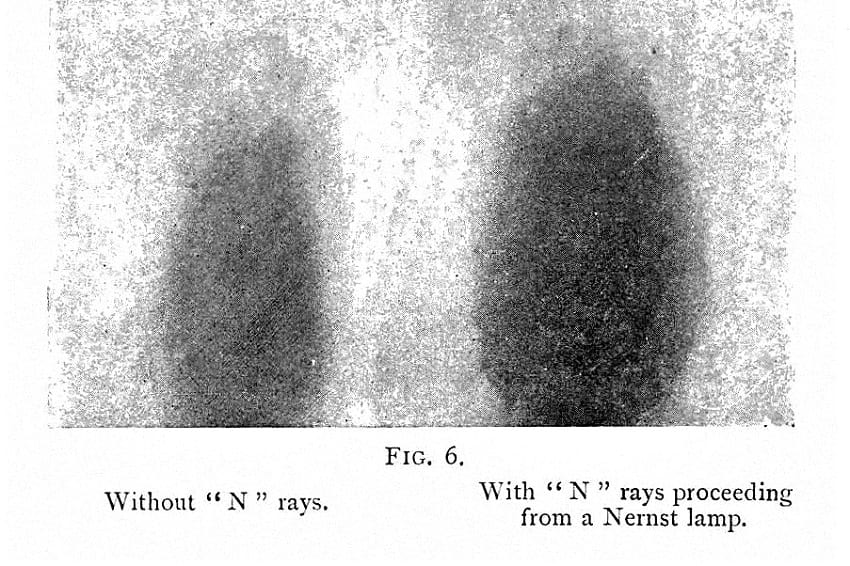 N-Ray or No Rays
N-Ray or No Rays
The Parrot and the Carrot we may easily confound,
They’re very much alike in looks and similar in sound.
We recognize the Parrot by his clear articulation,
For Carrots are unable to engage in conversation
–Robert W. Wood
This rhyme was written by a very talented American scientist called Robert W. Wood– a pioneer or optics, infrared and ultraviolet photography. In 1904 he travelled to Nancy, France, after hearing reports relating to the discovery of a new form of electromagnetic radiation – similar to the X-Ray – call the N-Ray. He wanted to see the new rays for himself as he could not create them in his own laboratory.

Prosper-René Blondlot, circa 1910. (Wikimedia Commons)
Intro
In 1895, X-Rays were a momentous discovery in the field of medical science. Their aptitude in radiation therapy, security, as well as the discovery of broken bones and other anomalies created many breakthroughs. Their ability to pass through soft elements to characterise more solid forms was something extremely useful especially in the modern world. Wilhelm Conrad Rontgen was the German who discovered the X-Ray and many scientists tried to replicate his success by studying their conditions and uses. A neighboring Frenchman Prosper-Rene Blondlot believed that he had found a similar type of radiation in 1903 with the self-named N-Ray after his birthplace of Nancy in France.
Biography
Blondlot worked at the University of Nancy in north-east France his whole life. After being inducted into the French Academy of Sciences, his piece de resistance would during the unearthing of X-Rays in which he attempted to polarise – meaning he looked to change or focus the direction of their energy beams. Instead he came across what he thought was a new type of radiation.
Many more types of radiation were being discovered at the beginning of the 20th century such as Alpha, Beta and Gamma rays so another was not disputed especially from a respected scientist. Other students of science were trying to find more properties for the X-Rays themselves but Blondlot went one further by supposedly finding the new ray. Because of his previous accomplishments the scientific community was quick to believe him. The university was a hierarchal system which worked on good relations meaning younger students were quick to agree with their lecturer and mentor.
Discovery of N-Rays and dispute
Blondlot realised that when the N-Rays shone through a prism – a transparent optical element with flat sides refracting lights – they cut out visible light. In this case, he used an aluminium prism. Morever, electrical sparks would grow brighter when exposed to the radition and heat increased the volume of the rays. The Frenchman published his work in Nature – one of the world’s most respected scientific journals. He also reported his findings to the French Academy of Sciences. Hundreds of scientists purported to see the rays also, but the strange thing was that hundreds claimed they could not. The scientific world was in a schism. Blondlot’s response to this was that their eyes were simply not sensitive enough to pick up the mysterious rays.
Blondlot used various techniques to pick out the rays of light. These included variations within electrical sparks and phosphorescent screens. They were reported to go through most substances but not water. Saltwater would naturally emit them however, so the lengths and breadths of the oceans could transmit N-Rays according to Blondlot. He deemed that they could be emitted by elements like fire and the sun. A colleague of his at the University of Nancy, Augustin Charpentier, added to the importance and potential of the rays stating that they could be emitted by animals such as humans, from our nerves and muscles.

Robert Williams Wood. (Wikimedia Commons)
Investigation
It was the afore-mentioned publication Nature who sent the afore-mentioned scientist – Robert W. Wood – to investigate the discovery. Wood was a respected physicist but also an eccentric character. It was said he would go to his local park and confuse strangers by spitting into ponds with a sodium solution meaning the water would burst into yellow flames. But he was one such person who could not detect said N-Rays nor even a whiff of them in private studies. He worked and taught in Baltimore, Maryland in the US yet he flew to France as soon as possible to examine the rays first hand.
Wood and Blondlot met and although being fluent in French as well as German (German being the global language of physics) Wood did not admit he spoke French. This was so he could eavesdrop on the conversations between Blondlot and his assistants. The Frenchman’s main method of observing the N-Ray spectrum was through an aluminum prism. Wood could not see any deviations so when the room went dark for a test the American removed the prism. Blondlot’s readings were exactly the same– as if revised – and so he was caught to be lying.
Public Response
Wood immediately sent a letter to Nature mentioning that the N-Rays were all in the imagination of Blondlot – perhaps being generous as to not call him a fraud straight away. Soon, the scientific community went against Blondlot and his scientific career never recovered. He continued to believe in and promote the existence of N-Rays but allowed no more tests from outsiders. His excuse was that Wood’s imperfect German meant that there were several issues with understanding. It was said he continued to lecture at the University of Nancy and study the N-Rays until his death. Others say he went mad.
Wood did not mention Blondlot’s name in the article but it was clear to those familiar with science who the article was about.
“After spending three hours or more in witnessing various experiments, I am not only unable to report a single observation which appeared to indicate the existence of the rays, but left with a very firm conviction that the few experimenters who have obtained positive results have been in some way deluded,”
No-one will know whether Blondlot was mad, a fraud, or simply mistaken with his findings. Here is a case however which shows the immense strength in having a scientific community who can detect real science or counterfeits. N-Rays were a myth that was put to bed very quickly as opposed to the past, when several fake sciences could be believed for centuries before being debunked. We live in more enlightened times now, thankfully.
Enjoyed this article? Also, check out “Thomas Midgley Jr. – The Scientist Who Almost Destroyed the Planet without Knowing“.
Fact Analysis:
STSTW Media strives to deliver accurate information through careful research. However, things can go wrong. If you find the above article inaccurate or biased, please let us know at [email protected].
RELATED
The post After the Discovery of X-Rays Came N-Rays – But Do They Actually Exist? appeared first on .
]]>The post Vulturine Parrot: Preserving the Plumes of Pesquet’s Parrots appeared first on .
]]>
Pesquet’s Parrot (Psittrichas fulgidus). (Peter Tan / Flickr)
Much of the modern industrial world can be blamed for unbalancing our delicate ecosystem and driving many species to extinction. Less maligned (and rightly so) are the more traditional cultures, living off the land and leaving it as they found it. If largely undisturbed, it will retain the high probability of returning to its original state of Gaia. Yet, there are a few exceptions to this notion, notably in Asia and the central belt of Africa, where poaching has made several species of Pangolin endangered (their scales are said to improve ailments in humans). A similar tragedy is erupting in Papua New Guinea also. One such species that is under threat here is the Vulturine Parrot, another moniker for Pesquet’s Parrot, a fig-eating species who dwells in the nooks and crannies of trees.
The Bird’s Habitat and Diet
Pesquet’s parrots are indigenous to the island of New Guinea, living in hills and mountains at elevations of over 600 meters. Being frugivorous, their favourite food is figs, especially the ones found on Ficus trees but they will consume softer items such as fruits like mangos and bananas. As well as flower blossoms and nectars if necessary. Breeding takes place in the nooks and crannies of hollow trees, where nesting eggs will typically have a maximum incubation time of 30 days.
Traditional garments
Some feathers of these birds are so naturally eye-catching that many natives of the volcanic island will adorn them as part of their attire for special occasions – mostly as a form of hat. They are almost exclusively made of plumage from the bodies of Pesquet’s Parrots among others. The headdresses are called Bilas and are essentially extravagant plumes emanating from the top of a wearer’s head.

A performer from Papua New Guinea wearing a Bilas. (Afrikit / Pixabay)
While the Pesquet’s parrots have mostly black features on most of its body, it is the striking red feathers on its underbelly which is the most sought after. The demand for said feathers is causing an issue. So much so, that the birds in question have been forced onto a path of extinction. Three birds need to be killed in order to make one headdress alone. The animals are selling for a high price.
Conservation of Pesquet’s parrot
Efforts to save the Pesquet’s parrot have fallen on deaf ears, especially in a country where communication is difficult. The flight-path and habitats of the species stretch all across the island which adds to the difficulty. For this reason, instead of saving them, scientists are now proposing that they protect – or rather the wearers – protect the headdresses, so they don’t need to be replaced so frequently. They are seldom adorned – sometimes only once a year for wedding ceremonies – so they should be maintained better is the voice of many activists. Owners are encouraged to wrap them in bamboo sheets or to keep them in sealed storage containers. A conservation-NGO called WCS has even created protection kits which they send out for free to anyone who wants them.

The Pesquet’s Parrot has a featherless face, which was most likely adapted to avoid a sticky face from the fruit’s pulp. (Doug Janson / Wikimedia Commons)
Their ethos remains,
“The PNG [Papua New Guinea] country vision fits within the global vision of WCS [Wildlife Conservationist Society], which “envisions a world where wildlife thrives in healthy lands and seas, valued by societies that embrace and benefit from the diversity and integrity of life on earth.
PNG retains large areas of intact rainforest and globally important wildlife such as the iconic and spectacular Birds of Paradise and the giant flightless Cassowarys, unusual mammals such as Tree Kangaroos and the egg-laying Long-beaked Echidna, and the world’s most diverse coral seas”.”
Substitute feathers are also an option, as is borrowing from relatives and friends. But these techniques are vastly unpopular as it goes against tradition and the mindless momentum of fashion.
A former Miss Papua New Guinea, Grace Nugi’ is now one of the most prominent protesters. She states that these particular feathers were not used until the 1960’s (with any feather being used in the past) therefore it is not a long-held tradition to use the Pesquet anyway. More so, the frequency of festivity has changed, as the younger generations will wear the Bilas at more events than just weddings, such as at graduations.

Pesquet’s parrot perching on a branch. (Greg Hume / Wikimedia Commons)
Author’s opinion
If you handed an image to people, showing the carcasses of Pangolins and Pesquet’s Parrot, most would feel an element of sadness. And this would be heightened, if you explained that these species are being hunted to the edge of extinction for fancy clothes and scientifically-unproved medicines. And yet not many people would change their ways if they were directly involved in the culling of these animals. We see it every day, in every corner of the world, where our indifference towards the suffering of these creatures and our world is staggering. To those who commit the acts, the only explanation for the majority can be that money breeds malice in mankind. The Neanderthals who do not see it a problem should be castigated less as they have no control over their education or DNA. As should those who were born into the world without hope, and desperately need the money.
It seems that NGOs and protesters can only do so much, and in Papua New Guinea – as with the rest of the world – extreme measures will have to be made by governments if we are to have any chance of saving species, saving our world and saving ourselves in the process.
Enjoyed this article? Also, check out “Hoatzin Reptile Bird: A Dinosaur-Like Bird with the Digestive System of a Cow“.
Fact Analysis:
STSTW Media strives to deliver accurate information through careful research. However, things can go wrong. If you find the above article inaccurate or biased, please let us know at [email protected].
RELATED
The post Vulturine Parrot: Preserving the Plumes of Pesquet’s Parrots appeared first on .
]]>The post Can a Spider Spin Webs on Acid and Other Drugs? appeared first on .
]]>
Spider on drugs: A spiders ability to build web under the influence of various substances. (NASA)
Spiders are the largest group in the arachnid class. All spiders have eight legs, six to eight eyes, spin silk and can be found in six of the seven continents. It is only Antarctica where they are not native but you can guarantee that some scientist has one in a terrarium either for experimentation, or to cover all seven continents. Or both. These organisms have successfully adapted to a wide range of habitats. Those who study them have been trying to gain a deeper understanding and their newly mapped genomes may be the key to unlocking many of the spider’s secrets. A major reason why animals are studied is to find out what would happen if humans were exposed to the same circumstances. Spiders and insects are becoming a gateway for this as testing on larger animals such as mice is being prohibited more and more due to law restrictions based on cruelty.
Webbing information
In order to see how the creatures would react to the narcotics, the spiders were covered in the chemicals to see how their behavior would change and their webs would form. Spider silk is an incredible material made of super-strong protein chains. Millions of years of fierce evolution has unearthed a ruthless animal let alone killing-machine since their genetic emergence from crabs. Their silk is stronger than steel and incredibly tensile beginning internally as a soluble liquid-like form before leaving the spider as a hardened fiber. Scientists are continually trying to source the material in the hope of replicating it. The spun material from the spidery spinnerets would be an extreme money-spinner for companies also.
Spider on drugs: The experiment and results
Hans Peters – A Germany scientist – created a system to record Spiders spinning webs on various substances via their sugar water, most of which illicit. It was more to see how the spiders would react as to any scientific predisposition. These photos became famous none-the-less which gained the attention of some in the scientific sphere. However, it was Peter’s pharmacologist Peter Witt who did most of the practical elements as Peters himself, could ill afford to stay up late and perhaps lost hope in the investigation. Witt hoped the drugs would make the spiders lose track of time anyway as they normally only build webs at night. Hans Peters grew disillusioned with the experiment but Witt was fascinated, making it his primary work.
Science has come on leaps and bounds since this experiment in 1948. Back then they gave spiders samples of urine from people suffering from schizophrenia thinking it would have an effect, which it ultimately did not. In terms of the drugs sprayed, the results are not as obvious as they look as scientific knowledge now denotes that what chemicals do to an arachnid’s brain is likely not the same as humans. LSD, marijuana, benzedrine, sleeping pills and caffeine were tested, and while the webs show that caffeine is the most dangerous of the drugs tested, it may not be the same for humans. It is possibly just an alteration to a spider’s muscle memory as opposed to changes in the brain. Although it is now widely accepted, the dangers of over-caffeinating.
“For instance, naturally occurring amounts of caffeine can kill animals that need a hormone called Octopamine—a category that includes spiders, but not humans. That might help explain why caffeine devastates spider web production.”
One thing the findings definitely show is that for all animals, and for all chemicals, moderation is key.
Enjoyed this article? Also, check out “Luigi Galvani: The Man Who Fuelled the Idea of Re-Animating Human Corpses“.
Fact Analysis:
STSTW Media strives to deliver accurate information through careful research. However, things can go wrong. If you find the above article inaccurate or biased, please let us know at [email protected].
RELATED
The post Can a Spider Spin Webs on Acid and Other Drugs? appeared first on .
]]>The post Trepanation: Unusual Medical Procedure of Drilling Hole in the Skull appeared first on .
]]>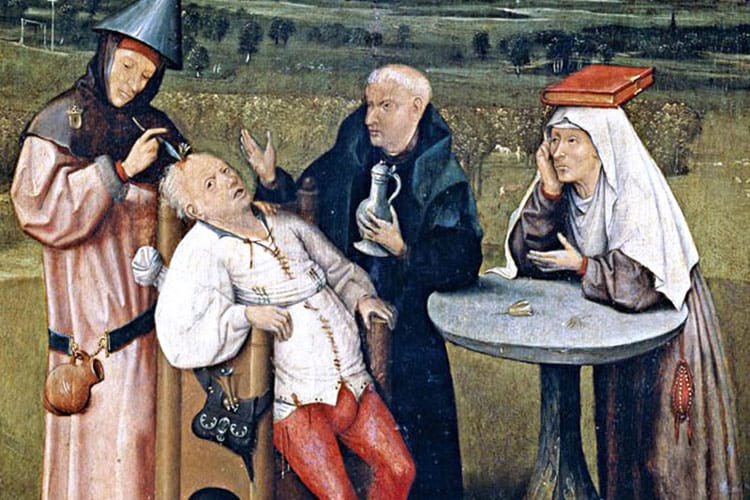
A painting by Hieronymus Bosch depicting trepanation. (Hieronymus Bosch / Wikimedia Commons)
The world is a bizarre place at times. And that is a severe understatement. For many, they cannot envisage some of the extreme things people do alas people will resort to extreme things when in desperate need. Some of the most pioneering events in the world have come from this precedent after all. Perhaps that was the case for Amanda Feilding, an English woman with a penchant for LSD who drilled a hole into her skull. This procedure is called Trepanation where a hole is made into the top of the head. It is meant to be a way to heal naturally from a variety of different neurological problems. That being said, even with no problems people have ‘Trepanned’ to achieve a heightened mood and state, or to open the mind so to speak.
Popular publication and now TV Channel VICE met Amanda Feilding, the one to have tried Trepanation. She carried out research with her directorship called the Beckley Foundation who experiment with psychedelics such as narcotics. She would later turn to Trepanation, influenced by a Dutch scientist called Bart Huges.
History and benefits of trepanation
An individual preaching something as extrovert as this would need to experience it first hand to be taken seriously. After being unable to find a doctor willing to help, Feilding did so, using an electric drill which required, according to Amanda meticulous planning. She claims that her natural state improved but not massively.
Furthermore, she noticed a great change in one of her friends who had the operation. When once prone to weekly migraines he hasn’t suffered one in thirty years since. It must be mentioned that there is a medical reasoning behind the practice. The skull does not give the brain enough room to fully pulsate which puts a lot of strain on the individual and creates pressure points.
Feilding’s goal is to make the practice legal which began with an attempt to make it available on the NHS – the UK’s National Health Service. However, she later claimed that was more of a publicity stunt. She is looking for more volunteers to experiment on, which would make it more accepted in the medical fields.
Amanda Feilding is far from one of the first humans to try this. The more we learn about history and prehistory the more we uncover what is an ancient practice. It emerged that it dates back to 10,000 BC. Thousands of skulls have been unearthed from a burial site in France dating from 6500 BCE with 40 out of the 120 total recovered skulls there having trepanation holes. The motives then are less known but it seems – as today – the aim was to cure pain as many show injuries or diseases around the holes. Religiously speaking it was also used to cast out the devil or let in light. African tribes today show us a vision of the past in these aspects.

A skull found in Edinburgh showing trepanation. (Wellcome Images)
Modern application of trepanation
In more modern times trepanation spread to the Orient with Tibetan monks and Shivu, the Hindu God who are considered as early practitioners of it. It then continued to Ancient Greece – a cornerstone of civilization where Hippocrates (Greek physician) used it to drain the blood of patients. Also in Rome – another ancient powerhouse – and Greek physical Galen who lived in the Roman Empire. He implemented it in his medical tests to release pressure. It was there it got its name from the Latin verb ‘Borer’ – to bore. That is the most likely reason however an instrument designed to aid Trepanation called ‘Tre Fines’ is another theory, meaning three ends.
Recently with advancements in technology and medicine, the popularity of Trepanning decreased as the high mortality rate put people off the idea. Craniotomy is a similar practice but the part of the bone removed from the skull is replaced once the surgery is complete.
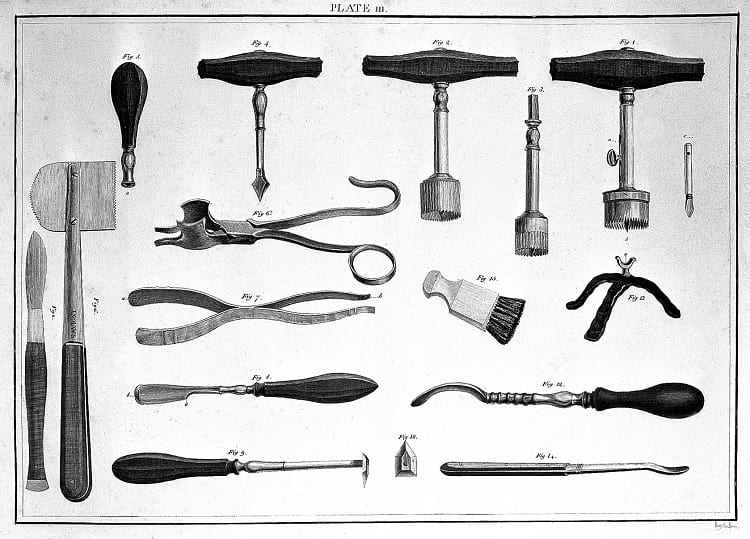
Trepanation tools from the 18th century. (Wellcome Images)
Trepanation is one of the first, if not the first surgical procedure in history. Its success is apparent in several cases but its failures are crucially debilitating to the overall acceptance of the practice. None the less, pioneers like Feilding continue to fight to have it respected. Perhaps this is a case of what was left in the past should remain in the past. On the other side, if you don’t try then you’ll never know as the saying goes. Any volunteers?
Enjoyed this article? Also, check out “Phineas Gage: The Miracle Man with a Hole in his Skull who became a Major Breakthrough for Neuroscience“.
Recommended Read:
1. The Mechanisms of Brainbloodvolume (1964) | By Bart Huges
2. Holes in the Head: The Art and Archaeology of Trepanation in Ancient Peru | By John W. Verano
Recommended Watch:
A Hole in the Head (1998)
Recommended Visit:
International Museum of Surgical Science | Chicago, USA
Fact Analysis:
STSTW Media strives to deliver accurate information through careful research. However, things can go wrong. If you find the above article inaccurate or biased, please let us know at [email protected].
RELATED
The post Trepanation: Unusual Medical Procedure of Drilling Hole in the Skull appeared first on .
]]>The post Japan’s Declining Population: A Wonderful Country with a Problematic Future appeared first on .
]]>
Crowd in Tokyo, Japan. (Max Pixel)
Japan is a simply wonderful country. Although being there for only a short time there is no doubt in my mind that this opinion would be echoed by anyone who visits any of Japan’s 6,852 islands. It is a sprawling mountainous state, with rich traditions that integrate with everyday life, respected by a population who pride themselves on courtesy and service, functioning in a uniquely efficient manner. There is unmatched religious harmony from the integration of Shintoism and Buddhism, the third-lowest crime rate in the world as well as spotlessly clean streets (mostly kept that way by the public).
Alas, do people residing in Japan feel the same sentiments about their homeland? And is life there as spotless to locals as it appears to an outsider? Will tourists who visit in another five or ten years have the same experience as today? Does something darker lie beneath the surface of the Land of the Rising Sun, and all that glitters is not gold.
Historically speaking
We are talking about a nation many times isolated from the world in regards to foreign policy. In literal terms also, isolated, due to its geographical location. One who has switched between various socio-political and geo-economical standpoints in relatively recent years – sometimes willingly, other times, forced. From isolationism to modernism and now to consumerism, Japan boasts the 3rd largest GDP (Gross Domestic Product) in the world. This began after World War II when a population boom was encouraged for economic and military development. 8 million babies were born between the years of 1947-49 alone. An economic upsurge developed during the Korean War (1950-53) when Japan was used by competing nations for resources. Industrialisation flourished which brought millions of jobs yet not enough bodies to fill the void,resulting in the government promoting family planning and legalising abortions. The want for technology skyrocketed to help with the modern system and also to export as goods.
Lamentably, Japan is a land left scarred by the Atomic Bomb attacks of World War II. At least 226,000 innocent people died in the four months following and an uncountable number more in the aftermath. This no doubt contributed more to an already homogenous society in which immigration is extremely low. 98.5% of the ethnic population are Japanese and, “Only 2% of the workforce is foreign compared with 17% in America.”
A large majority of this population is elderly and/or retired as the Japanese people boast the second-highest life expectancy in the world (behind Hong-Kong) due to clean living (notably a healthy diet) and health-care. The average life expectancy of a Japanese woman is 87 years old which is of course a positive and impressive statistic in today’s world but one which has created challenges.
Check out the article on Ubasute, a legacy of Japan’s folklore, which literally means ‘abandoning a parent’.
The problem – a demographic time bomb – and how did it happen?
As Business Insider states, ‘Demographic time bombs are hard to diffuse.’ This is the case in the state of Japan where a Demographic Time Bomb has been ticking since the conclusion of World War II. Damning statistics have arisen in which a population of 126 million is set to plummet to 83 million by the end of the century if the current trend does not subdue. It is a precedent that is unmatched in history.
“Population decline is hitting especially hard in rural and regional Japan, due to a high pace of migration to Japan’s cities, as well as rapid ageing. In northern prefectures such as Aomori and Akita the population is falling by more than 1 per cent a year. In some villages almost nobody is under the age of 70….”
Today, the Global Economic Forum reports the birth rate to stand at 1.4.
There is a shortage of births, therefore a shortage of young people and a shortage of workers. Last year, there were 161 jobs for every 100 job-seekers. Contributing to this is a lack of desire to work as well as the amount of robot workers. How did this come to be?
A guide in Japan remarked on Japan being a politically right-wing dream. In this sense the inhabitants are pushing and pulling in the same direction, growing up with the same values. It is extremely difficult to understand why these features – when done so well – cause problems (especially from an outsider) but in one sense it has.The qualities present in the majority of Japanese people are something that is drilled into them from an early age with hard work and long hours. This is transferred from the school to the work place creating a country with one of the longest working days in the developed world. Steps have been taken to stop workers from working too much for instance. It has created somewhat of a dejected workforce in the sense that economic problems have resulted. Such a homogenous and loyal citizenship are perhaps too subservient to demand a change.
One argument is that the people have an extremely proud and responsible mindset, giving the island nation an extremely low crime rate for instance. This responsibility has led to the country having the lowest fertility rate in the world as people are not prepared to risk poverty with children or risk the stress it could present. With long hours in work coupled with a low salary, many couples are not prepared to suffer. Essentially, society became somewhat disillusioned. It contributes to the problem as the population spends less money, primarily due to not having enough expendable income. The possibility to support a family disappears and domestic consumption sinks even further.
“The daily constraints have made for a worrisome trend. Japan has entered a vicious cycle of low fertility and low spending that has led to trillions in lost GDP and a population decline of 1 million people, all within just the past five years. If left unabated, experts forecast severe economic downturn and a breakdown in the fabric of social life.”
It is a frustrating thing, that this has befallen Japan. That the Japanese government and their civilians have done everything to create an almost utopian civilisation with a staggeringly low amount of crime, incredible cleanliness and one of the highest rates of employment. Yet now they have found themselves in a crisis, after maybe asking too much of their beleaguered citizens. So what solution does the Prime Minister Shinzo Abe and his advisors have instore to save Japan?
Solving Japan’s declining population crisis
The Japanese government is discussing a number of methods to improve the birth rate but to do this they first have to tackle the low-employment rate. The first and obvious solution is immigration which would threaten traditional Japanese values. These would be low-skilled immigrants in which, “… Japan’s parliament is debating a bill to allow thousands of… into the country, to work on farms, on building sites and in nursing homes.”
A reverse would be promoting more of the elderly to work by increasing the pension age. Other policies would be directed at women, making it easier for women to work and have children. More woman than ever have chosen the career route in Japan but it still remains a male-dominated society. Free education, day-care and increased maternity leave are some of the projected implementations.These labor and child-care in tandem policies have worked in a town called Nagareyama where,
“As the city’s mayor, Yoshiharu Izaki’s first strategy was to provide an innovative solution to young families’ childcare needs, by setting up a nursery transit service near the main train station.”
That will not be enough for everyone however.
Ultimately, creating a more appealing workplace for both sexes is the key, something which has deterred workers in the past. Automation will be increased even more with robots a constantly willing workforce. These options would mean that the anti-immigration state of mind would persist and remain closed to workers coming into the country. Initially, this would produce a smaller, welfare state forcing Japan to be weaker as a geopolitical force as they lack internal resources, relying on mineral export from abroad. In the long term however, they would use this along with family planning to free up more resources and policies for young couples, in an attempt to stimulate families.
The future
The future of Japan is uncertain due to these alarming demographics and much change will need to take place in a country that has changed in the past – but a long time ago. The government has a big task on their hands and many eyes will focus on Japan to see the outcome of a modern population problem, one which is unparalleled in known history. The focus seems to be on increasing the number of births as opposed to learning to deal with fewer people. For this reason, for the foreseeable future, Japan will hope to be known as the Land of the Rising Sons… and daughters.
Fact Analysis:
STSTW Media strives to deliver accurate information through careful research. However, things can go wrong. If you find the above article inaccurate or biased, please let us know at [email protected].
RELATED
The post Japan’s Declining Population: A Wonderful Country with a Problematic Future appeared first on .
]]>The post Remembering the Bone-Chilling Story of the Missing Sodder Children appeared first on .
]]>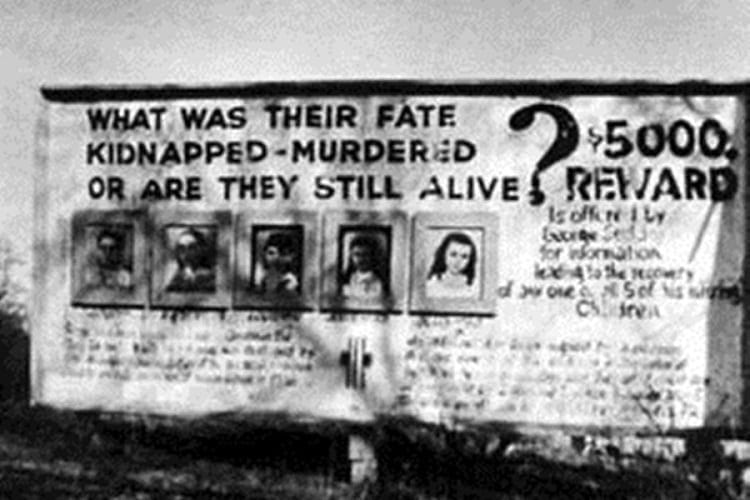
The famous billboard seeking information about the missing Sodder children. (Wikimedia)
There is nothing more chilling than a murder mystery. The reason being, that when a crime is unsolved then automatically the worst case scenarios will reel through a person’s mind. This would have been the torturous case for parents George and Jennie Sodder after five of their children seemed to have miraculously survived a house fire, their remains were never found.
A billboard was erected offering a generous reward for information leading to their recovery. Many people came forward with rumours, some relating to the Sicilian Mafia.
History of Sodder family
The location and background are both essential to the mystery. It occurred on Christmas Eve, 1945 in Fayetteville, West Virginia. Nicknamed ‘The Mountain State’, it is predominantly covered by the Appalachian mountain range. Much of the state was rural with many villages separated from the major towns and cities, located to harvest coal and other fuels.
The father George Sodder, moved to the US from Sicily at 13 years old with his brother. An exact reason was never specified but it was common for Italians to make the move for economic reasons. Eventually launching his own trucking company, George married Jennie and had 10 children settling in Fayetteville, a village with a strong Italian community. It was a community in dispute, however political tensions during World War II and the reign of Benito Mussolini caused division. George Sodder openly criticized the Italian government which made him enemies around town.
Sodder Children disappearance
In the run-up to the fire, some weird things happened. Two months previous, a stranger appeared at the house inquiring about work. He claimed the fuse boxes were unsafe even though George had them checked regularly. Around the same time, another man came to sell insurance. He threatened the family after they declined and quoted George’s dislike for Mussolini in his insults.
Weeks before, the older boys noticed a man in a vehicle parked along the nearest highway, watching them as they walked home from school. Christmas day was hours away – under normal circumstances the happiest time of year for families. 10 PM was the usual bedtime for the kids but they were allowed to stay up late with some early Christmas gifts. So Maurice (14), Martha (12), Louis (9), Jennie (8) and Betty (5) played upstairs while the others went to sleep.
Later, the mother Jennie awoke to a call coming from the office. An unfamiliar female voice asked for an unknown name with much laughter in the background – it was a wrong number. Jennie noticed that the living room lights were still glowing and the curtains were left open. On checking the main door, she found it unlocked – things that the children were meant to take care of. She saw Marion (17) sleeping on the couch in the living room and presumed other kids to be asleep too. She went back to sleep after locking the door, closing the curtains and turning off the lights. Moments later, again she awoke, after hearing a loud bang on the roof.
Shortly after, smoke began to bellow. Instinctively, four of the nine children present escaped to the garden with their parents. The two eldest brothers made it down from the attic but the younger kids a floor below were nowhere to be seen (although their voices were apparently heard). George attempted to get upstairs but the staircase was now alight. He ran for his ladder but it was not in its usual place. He tried to drive either of his two coal trucks to the house to climb atop but neither started, having worked perfectly during the day. One daughter ran to their neighbours to call the Fire Department but none of their phones were working. So a neighbour drove into town to find Fire Chief F.J Morris who set off the alarm.
The house had been completely destroyed in 45 minutes with F.J Morris not arriving until 8 AM (claiming he had to wait for a driver first). By then it was assumed that the five children had died. No remains were found with Morris suggesting the blaze consumed everything and the police deemed it faulty wiring. George and Jennie made the site into a memorial soon after, covering it with dirt and five graves.

The five missing Sodder Children. From left: Maurice, Louis, Martha, Jennie, Betty.
Investigation and leads
As the weeks passed the family began to doubt what happened. They kept wondering how the bodies of five children left no remains behind. A crematorium employee stated that even after bodies are burned for two hours at 2,000 degrees, the bones would still remain. More evidence came to the fore: A telephone repairman told the Sodders that their electricity lines appeared to have been cut, not burned.
An eye-witness came forward and said they saw a man with some car engine removing tools walking through town. They later found a napalm bomb called a ‘Pineapple Bomb’ in the garden area.
Then emerged reports of sightings. A resident of Fayetteville claimed to have seen the missing children exiting the village in a car while the fire was in progress. A woman operating a restaurant in a nearby city served them breakfast the morning after. Another woman met them in a hotel with adults of Italian extraction who kept the kids quiet.
Investigating further, in 1947, George and Jennie the Sodder couple sent a letter to the FBI director J. Edgar Hoover. He agreed to help the family after taking permission from the local authorities but unfortunately, they were declined by the Fayetteville Police and fire department. So they hired a private investigator named C.C. Tinsley.
His investigations revealed that the insurance salesman who threatened George was a member of the jury who declared the Sodder house fire to be accidental. In 1949, the Sodders hired a pathologist to excavate the site. He found human vertebrae but on examination, it showed greater skeletal maturation than the oldest child of 14. He also found an organ but it was tested to be beef liver and untouched by fire. A bizarre rumour was heard about the Fire Chief – Morris. The investigator told that Morris buried it himself hoping that the family would find it and cease their investigation.
A ray of hope
The famous billboard was then put up on Route 16 offering $5,000, later hiked to $10,000, for information. Over the next few years, many people took the opportunity. A letter arrived from a nearby state St. Louis stating that Martha, the eldest girl, was living there in a convent. Another news came from Florida claiming that the children were staying at a relative’s house known to Jennie.
George saw a newspaper photo of school children in New York City, he believed was Betty. Few mentioned incriminating conversations across the US about a Christmas Eve fire in West Virginia. George spent his life travelling the country to investigate but never found anything concrete.
In 1968, more than 20 years after the fire, Jennie received the most compelling piece of evidence that her children were still alive; a letter containing the photo of a man. The cryptic note with it read “Louis Sodder. I love brother Frankie. Ilil Boys. A90132 or 35.” Both zip codes were from Palermo, a city in Sicily, Italy. Once again they hired a private detective and sent him to Italy for further investigations.

Louis Sodder as a child (Left) and the photo that was sent to the Sodder family years later claiming it to be Louis (Right). (Wikimedia Commons)
They never heard from him again. In 1989, 44 years after the incident the billboard was finally put down. The Sodder parents have since died but their children and grandchildren continue the investigation as do many members of the public fascinated by the story. It is the very definition of a mystery because there are no strong theories on why the children were never discovered. Or if they died, why their remains were not found.
Enjoyed this article? Also, check out “Greenbrier Crime: When Trial Court was Forced to Record Version of Ghost from Netherworld”.
Recommended Read:
Sodder Family Tragedy: The Mystery of Five Missing Children | By Douglas MacGowan
Facebook Group:
Sodder Children. What Happened to Them?
Fact Analysis:
STSTW Media strives to deliver accurate information through careful research. However, things can go wrong. If you find the above article inaccurate or biased, please let us know at [email protected].
RELATED
The post Remembering the Bone-Chilling Story of the Missing Sodder Children appeared first on .
]]>The post The Great Fire of London: The Blaze That Destroyed 80% of England’s Capital appeared first on .
]]>
A lithographic print of the great fire of London. (Museum of London)
The infamous Black Death or Bubonic Plague of 1346 transformed the social outlook in England so much that by 1665 more and more people inhabited towns and cities, fueled by the industrial revolution sweeping their nations. When another strain of the plague – the Great Plague – struck London in 1665 it did not kill the millions that the plague of 1346 did due to advances in medicine and hygiene, but estimates conclude that at least 100,000 Londoners perished from the disease. Another tragedy would strike only a year later. The Great Fire of London ravaged the city, feeding on vastly wooden constructs which acted as a tinderbox of destruction within a panicking city. A country at war with the Dutch, the French and the Catholics, several theories and conspiracies arose on who was to blame.
Flammable abodes
Safety standards in England at that time were nowhere near as stringent as they are now. In a society so reliant on fire for industry, lighting and insulation among others, cramped wooden houses were a massive safety issue even though most fires were extinguished quickly before spreading. This was warned by many leading figures alas, there were few alternatives as cheap. These mostly residential buildings were primarily made of oak, separated by straw floors and thatched roofs. There was not much open space between buildings in most parts of the city; narrow streets meant that some roofs even touched across streets.
Sunday, 2nd September 1666
September 1666 was an especially warm, dry month. In the east of the city, near London Tower was a bakery which supplied the Royal Navy biscuits. It was located in Fish Yard, just off Pudding Lane. Shortly after midnight on the 2nd of September, the blaze started and spread quickly due to the warm weather making the wood and straw extremely dry.

Samuel Pepys. (National Portrait Gallery)
One of the best accounts of the terror came from famous writer Samuel Pepys, a Member of Parliament and British Navy administrator. His diary is one of the most famous works in English literature, totalling over 1 million words. Pepys climbed to the top of the Tower of London to which he saw his city burning. He spent much of the next week sailing on the River Thames detailing the path of the fire. The Lord Mayor Thomas Bloodworth was called to the district where the fire started. He would not allow the experience firefighters to destroy buildings in the path of the conflagration because he could not find the owners. He feared reparations from the landlords no doubt.
The fire spread with thousands of people trying to escape the vicinity including via the river Thames. Stores of oil and gunpowder on the banks of the river meant this could be perilous also, and when the blaze hit them it turned into chaos.
People lost hope of putting out the fire as gale-force winds gave oxygen to the blaze. Refugees lined the streets making it difficult for fire-fighting carriages to get through. The destruction was so intense that King Charles II sailed into the city and demanded that buildings be torn down to create a fire break.
Monday, 3rd September 1666
The financial district was hit on Monday, destroying the homes of bankers and the Royal Exchange – the city’s center of commerce. Paranoia and blame set in by this point and with the wind starting setting seemingly random buildings alight, foul-play was suspected. Reports came of foreigners whose nations were at war with England feeding the fire. Eyewitness accounts of grenades thrown into buildings. Many French and Dutch nationals living in England were lynched or their stores looted by the blood-hungry mob. In an effort to stop the xenophobic mobs and quench the fire, King Charles gave the command to his experienced brother the Duke of York. He took the army as well as teams of mercenaries to destroy more buildings – creating a break way. They were said to have rescued many foreigners from the mobs.
Tuesday to Sunday
These methods continued on Tuesday but it was also the day of greatest devastation raising the likes of St. Paul’s Cathedral to the ground. Decreased winds and more fire-breaks meant that finally the blaze looked set to quell. By Wednesday the majority of the damage had been done and the blaze was controlled although it took until rainfall on Sunday before the fire was extinguished and until March the following year until no embers reignited.

Model of a 17th-century fire engine. (Steven G. Johnson / Wikimedia Commons)

Illustration of the 17th-century fire engine in use. (Wikipedia Commons)
Great Fire of London: Arson or accident?
Most believe Thomas Farriner, a local baker accidentally started the blaze, or rather, his maid who cleaned the kitchen. He always denied this, stating that the embers in his bakery were safely cleared from the oven as always. Everyone in the house escaped except for the maid who was the first victim. While Thomas Farriner’s household is believed to be behind the accidental fire there have also been a number of theories, some labelled conspiracy theories for their extremity. Not only after the fire but during it did these theories come to light. The main motives being that England was at war with the Dutch and the French.

A plaque in Pudding Lane commemorating the Great Fire. (Ivory / Wikimedia Commons)
A French watchmaker actually admitted to the crime but it was later found out that he wasn’t even in London at the time. The man was considered mentally handicapped but he was hanged before he could be cleared. Nostradamus, a French soothsayer, predicted that a fire would kill many in London in the year 66.
“The blood of the just will be lacking in London,
Burnt up in the fire of ’66:
The ancient Lady will topple from her high place,
Many of the same sect will be killed.”
The Dutch had a reason for revenge also as the English navy burned a Dutch town to the ground in recent years.
More far-fetched beliefs exist such as a group called the Freemasons – a fraternal organisation–wanting to create a new city. Christopher Wren– a highly acclaimed architect -who rebuilt London was a Freemason after all. Others feel it was a strategy from those in high powers to finally rid London of the bubonic plague. The general belief in London at that period was religious of course, with God punishing Londoners for their greed. The church promoted this reasoning by highlighting that the blaze started in Pudding Lane and ended in Pye corner.
The aftermath
Whoever caused the catastrophe, the end of the destruction claimed no less than 13,000 houses. Less than ten deaths were recorded but experts believe thousands perished as the fire reached temperatures as hot as 1,250 degrees Celsius, enough to burn skeletons. Samuel Pepys described a local park called Moorfield, a site where many of the survivors had gathered (80% of London had been made homeless). It was a heartbreaking sight with swathes of suffering and now homeless people. Temporary accommodations were built but many were not adequate meaning even more would perish in the winter. 25% who left the city for new lives would never return.

This painting shows survivors with their cattle near the Old London Bridge. (Museum of London / Wikimedia Commons)
Christopher Wren was in charge of the city’s permanent restoration which provided the blueprints for the foundations of modern London including a new and improved St. Paul’s Cathedral.
If there is a silver lining to be taken from this tragedy is that although the Great Fire was a catastrophe, it did cleanse the city somewhat. A safer London would be built on the ashes and improvements to the squalor living conditions were made. The remnants of the bubonic plague were wiped out but would return – albeit in lesser numbers – in the not-too-distant future. A cure has since been found. A monument to the Great Fire of London still stands near Pudding Lane, close to where the blaze started.

Monument to the Great Fire of London. (Eluveitie / Wikimedia Commons)
While safety standards have improved considerably, a recent blaze in London (2017) killed 72 people in Grenfell Tower, West London, warning that constant precautions have to be taken when constructing and maintaining buildings. Even then, fires can still spark and spread.

Grenfell Tower fire, 14 June 2017. (Natalie Oxford / Wikimedia Commons)
For more detailed information the Telegraph has a timeline of events on the Great Fire of London.
Enjoyed this article? Also, check out “The Black Death: When Tens of Millions of Europe’s Population Was Killed by the Bubonic Plague“.
Fact Analysis:
STSTW Media strives to deliver accurate information through careful research. However, things can go wrong. If you find the above article inaccurate or biased, please let us know at [email protected].
 Recommended Read:
Recommended Read:
The Ghost Map: The Story of London’s Most Terrifying Epidemic – and How It Changed Science, Cities, and the Modern World | By Steven Johnson
Genre:
Non-fiction > History
RELATED
The post The Great Fire of London: The Blaze That Destroyed 80% of England’s Capital appeared first on .
]]>The post The Black Death: When Tens of Millions of Europe’s Population Was Killed by the Bubonic Plague appeared first on .
]]>
Artwork of black death. (Kupferstichkabinett / Wikimedia Commons)
A cruel fact about life is that diseases exist. Especially infectious, life-threatening variants that once spread can kill millions of people in a short space of time, in very painful circumstances. An example is smallpox which is estimated to have killed between 300-500 million people in the last 12,000 years. Still, no cure exists, but vaccinations are very effective at stemming the development of the disease. Another is bubonic plague, a bacterium-based disease which wreaked havoc in Europe and Asia, most infamously in the year 1346. The devastation was so serious that it became known as the Black Death, with the Latin word for terrible, mistranslated to black. Although for many, both terrible and black perfectly explains the dark situation throughout the Old World at this time.

Plaque in Weymouth, England. (Les Haines / Flickr)
No-one knows for sure how many people the plague killed, even estimates vary from source to source. Some say as high as 60% of Europe at the time which would have been around 50 million victims. The only thing for sure is the Black Death was one of the biggest catastrophes in human history.
The old word and England in 1346
This strain of the bubonic plague began in the year 1346, a period now known as the Late Middle Ages in Europe. To give an idea of what life was like, another name for this time is the Dark Ages – starting after the fall of the Roman Empire. By 1345 however, Europe was beginning to come out of the dark. Inventions came from the ‘Golden Age’ of the Islamic world including clocks, from China – rockets and eyeglasses. Even the ancestors of toilets and factory machines were developed. Important buildings had their foundations in concrete while most were made by wood.
At the period where the Mongols ruled much of Asia, they had four Khanates (a political zone) established after the decline of the Mongol Empire. The infamous Golden Horde Khanate was galloping into European lands set on conquering as far as the eye could see. Revolts were happening in China against the Yuan dynasty, and wars between India’s Vijayanagara Empire and the Muslim Sultanates were taking place. In the center of Eurasia, the Byzantines and the Ottomans struck an alliance after Emir Orhan married a Byzantine princess called Theodora.
In Europe, as with the rest of the world, and as it had been for millennia before, wars and territory changes continued to happen. England was at war with the Dutch, and with the French, during the Hundred Years War campaign over a territory dispute in a region called Guienne.
To have an image of what Europe was like in the 14th Century we can take a look at standard living conditions in England. This was before the outbreak of the bubonic plague, as this changed society in many ways. Much of the European population lived in rural communities. England was a feudal empire meaning the King or Queen gave power to landowners who had serfs – who lived on their land – worked for them. Life for a peasant had not changed much and had been the same for centuries, millennia arguably. Living was tough and sustenance relied on crop rotation. Not a lot of the population lived in towns and cities, only 40,000 people inhabited London compared to over eight million today. Conditions in both settings would have been in a state of squalor, especially by today’s standards. Cramped, dirty, low-light, noisy and living in close quarters with animals, many of which, unwanted pests. As the Church was central in governing much of Europe they took taxes from the peasants, even though because of high illiteracy most of the population could not read the bible. Even books were expensive and were seen as a status symbol. The Islamic and Asian world was more advanced in terms of science and medicine.
Black Death arrives
Europe’s reliance on religion was why when the Black Death came it was considered divine intervention by the majority of England and Christian Europe. In scientific terms however it is called bubonic plague. It is a bacterium called Yersinia pestis which is contracted and spread by rodents predominantly the black rat, an animal that likes to live close to humans as opposed to many other species of rodents and rats. When the plague hits, a contaminated colony of rats dies within two weeks. When the flies have finished eating this colony they move to humans and spread the disease – the biggest killer being the Oriental rat flea. The bite becomes a lymph node around the bite area, which swells, usually in the hip area or neck. There is a short incubation period before the symptoms arise. Within a week of contracting the disease around 80% of victims die.

A hand displaying acral gangrene of the fingers caused by bubonic plague. (Centers for Disease Control and Prevention)
Timeline
The spread of the plague to Europe is illustrated in many writings such as Danse Macabre – a series of allegories representing death and the Middle Ages. This among other sources has allowed historians to trace the route of the bubonic plague.
Many deduct that it began in the Russian Steppe, with others believing, China. Either way, it made it to the Mongols who owned lands around the Crimean Sea at the crossroads of Europe and Asia. This was a major hub where the Mongol Khanates would trade with Europeans. It is said that an attack on an Italian trading post here transferred the plague to mainland Europe when the Italian traders retreated home. Large scale trading routes were already in place by then linking all the powers of Europe and unfortunately spreading diseases also. It came to Constantinople, a busy city, which in turn distributed it around the Middle East and North Africa via Alexandria, another sprawling, metropolitan conurbation. Inland to Europe spread from Marseilles, up through France and down the Iberian Peninsula. It reached England by ship, and Scandinavia by the same means. Down through Germany and Prussia it would even reach Russia, in Novgorod – one of the earliest Russian towns – before infecting Moscow. The plague penetrated the lands of Asia through the notorious Silk Road. It greatly affected China, Persia, Korea, India and the Mongol Empire. Winter and longer distances between tribes would finally end the spread of the almost pandemic – as the conditions were hard conditions for the rats and flies to survive.
Life after the plague in England
Returning to England, the Black Death was estimated to have killed as much as ½ of the population. For this reason it is said to be the beginning of the end to feudalism, which would begin a system more akin to capitalism. Because of the extreme decrease in the rural population, workers gained a rise in power, and had leverage to make demands of the lords. Although the powers-that-be tried to end this wave, by passing laws to limit peasants, including capping wages at rates from before the Plague and making it illegal to refuse work. This did not sit well however, culminating in the Peasant’s Revolt of 1381. Whilst the revolt was quelled and nothing would change too quickly, by the 15th century it is clear to see that the seeds had been planted for revolutions to rise in the future.
The devastating numbers

Mass grave of bubonic plague victims discovered in France. (S. Tzortzis / Wikimedia Commons)
Original research brought the number of deaths at around 20-30% of Europe. However, this mainly came from statistics recording cities and towns. When rural areas were looked at the number was said to have doubled even tripled due to various factors including poverty, and more contact with animals. Some put the number at 50 million which would have been around 60% of Europe.
In Asia, an account from China’s Hebei Province writes that five million died. In total, China’s overall census in 1393 was 65 million – almost half the number from two hundred years previous. The Black Death is believed to have had a massive contribution to this along with famines and wars of course. Particularly affected, were the Mongols, who were said to have first contracted the disease. The Black Death contributed massively to the fall of the Mongol Empire – the second-largest empire the world has ever seen. It is hard for many of us to imagine a world like this but the truth is, over 600 cases of bubonic plague are reported every year. Luckily now, there is a cure to this particular disease.
Enjoyed this article? Also, check out “Dancing Plague of 1518: When People Nearly Danced to Their Deaths“.
Fact Analysis:
STSTW Media strives to deliver accurate information through careful research. However, things can go wrong. If you find the above article inaccurate or biased, please let us know at [email protected].
 Recommended Read:
Recommended Read:
The Great Mortality: An Intimate History of the Black Death, the Most Devastating Plague of All Time | John Kelly
Genre:
Non-fiction > History
RELATED
The post The Black Death: When Tens of Millions of Europe’s Population Was Killed by the Bubonic Plague appeared first on .
]]>The post Everything You Need to Know About Spontaneous Human Combustion appeared first on .
]]>
Victim (Helen Conway) of Spontaneous Human Combustion. (Folsomnatural / Flickr)
The phenomenon of Spontaneous Human Combustion (SHC) has been reported as early as 1470 when an Italian knight burst into flames after enjoying some wine. It was completely unexplained then and it seems that over 500 years later we are no more enlightened on the subject. It is so strange in nature that it has never been scientifically proven or unproven but many theories exist.
A victim to SHC is usually found turned to ashes with only limbs such as their feet left behind. Generally, a human body requires a temperature of 1600 Celsius to disintegrate bone – for example during cremation – but the improbable aspect of these cases is that furniture in close proximity to them is usually unaffected, and in some instances, the victim’s clothes. SHC, in essence, is where a person bursts into flames without an external source.
Notable Spontaneous Human Combustion cases
Here are some famous cases within the peculiar history of SHC. The earliest accounts are from a Danish Anatomy expert Thomas Bartholin in his work Historiarum Anatomicarum Rariorum (1641). However, if all fire needs is a human body then its origins can surely trace back to prehistoric times. The works of Bartholin looks into strange occurrences unexplained by medicine which human combustion certainly falls into.
A tale comes from 1470 when he describes an Italian Knight named Polonius Vorstius who was drinking wine with his family. Witnesses saw him burping and then fatally exploding into flames. The author, Bartholin was told of the account from a descendant of Vorstius.
Another comes from the works of a French writer Jonas Dupont – De Incendiis Corporis Humani Spontaneis (1763). He wrote that a resident of Paris – an innkeeper called Nicole Millet – turned to ashes during her sleep. Her husband was actually accused of the murder. Such is the unfathomable scene left when a person combusts. What made the anatomist Dupont conclude that it was neither murder nor accident was the straw mattress – It remained completely unaffected. The Surgeon thought on the same lines of Dupont and stated that it did not have the look of manslaughter. A guest at the public-house also helped with this alibi, luckily for the husband.
Accounts which have followed generally have the same characteristics. Furniture will remain intact as well as the hands and feet of many cadavers. In others, strange remains will be left such as organs, pieces of bone or shrunken skulls. This may well be down to the torso containing the most heat and in many cases, the deceased has been left in a sedentary position. Not every victim will be killed however and some people have survived. Many of these will not have been engulfed in flames but rather have received internal burns. Their internal organs are usually not damaged.
More modern examples include one as recent as 2010 in Galway, Ireland, where only the cinders were found of Michael Flaherty, a 76-year-old man. His entire living room was untouched apart from the ceiling and floor below him which had a sticky, sooty residue. The coroner did not blame his locality to the fireplace but rather to the first official case of SHC. If this has been considered in such a modern, secular society as Ireland it certainly gives more credence to the unexplained phenomenon.
Again in the 1960’s, the death of Dr. John Irving Bentley – a renowned retired physician – drew attention from the media. He was discovered in his Pennsylvania bathroom with only his left leg and foot at the scene next to a pile of ash and his walking cane. Mary Reeser is another famous example. In 1951 the only parts of her found was a foot, a liver attached to a piece of vertebrae and a skull the size of a teacup.
Not all will occur solely in the homestead and some are reported with eye-witnesses who actually saw the incident. Those of which are very scarce in detail, however. All of which do coincide to mention people giving off flames – often blue – from their stomachs and mouths. Many of these have been sensationally fabricated or added to along the lines of Chinese Whispers.
Take the story of Maybelle Andrews which with a simple internet search will describe her turning into flames at a Soho nightclub in front of dozens of party-goers. This seems to have now been debunked. It is from an earlier newspaper article where a lady named Phyllis Newcombe had her arm burned after a fire in an English club. Septicemia later killed her and the myth grew into Maybelle Andrews.
A very recent account with more information comes from Flensburg, Germany in 2015 where a woman burst into flames within a local park. An eyewitness put out the flames with his jacket to save her life. Authorities were quick to point the blame in the direction of two men who were seen to quickly exit the park. Otherwise, to a suicide attempt. With no clear answers however the non-explanation of SHC again rears its mysterious head.
What causes Spontaneous Human Combustion?
It was once thought that human bodies had no flammable substances so only a mass amount of a combustible substance such as ethanol i.e in alcohol could make a person ignite. But scientists have begun to unearth other theories. One of which involves a gas present in all of us known as methane. Once enough of it builds up it can be ignited by certain proteins also present called enzymes.
Another theory goes the way of a static electricity build-up – there are plenty of items after all which can catch fire without any help. If inside a bucket, oily fabrics can capture oxygen which will raise the temperature. Also, bales of hay where bacteria can build up to cause a chemical reaction.
A more popular hypothesis is labelled the “Wick Effect”. As many of the deceased are alcoholics – and many alcoholics are smokers (in past times more so) – if a lit cigarette strikes the skin it can ignite the whole body using fat as a flammable substance but keeping clothing protected. Many of whom also have debilitating diseases or are elderly which makes it harder to move or find help. This also makes the bones burn quicker in terms of diseases such as Osteoporosis. Others who are less believing of spirituality will point to cover-ups due to criminal activities for the main reason behind SHC.
We are still in the dark in terms of Spontaneous Human Combustion (SHC). As even scientists and coroners cannot give definitive answers for any of the deceased. All that can be said is that the human body is an incredible thing with an insurmountable amount of reactions happening every nanosecond. For this reason, it is not beyond the realms of possibility that an internal reaction could cause some widespread damage.
Hopefully, with more research, we can find out more about this peculiar act and save people from future disintegration.
Enjoyed this article? Also, check out “Luigi Galvani: The Man Who Fuelled The Idea Of Re-Animating Human Corpses“.
Recommended Read:
Faith, Madness, and Spontaneous Human Combustion: What Immunology Can Teach Us About Self-Perception | by Gerald N. Callahan
Fact Analysis:
STSTW Media strives to deliver accurate information through careful research. However, things can go wrong. If you find the above article inaccurate or biased, please let us know at [email protected].
RELATED
The post Everything You Need to Know About Spontaneous Human Combustion appeared first on .
]]>The post Ivan the Terrible: The First Tsar of Russia and His Reign of Terror appeared first on .
]]>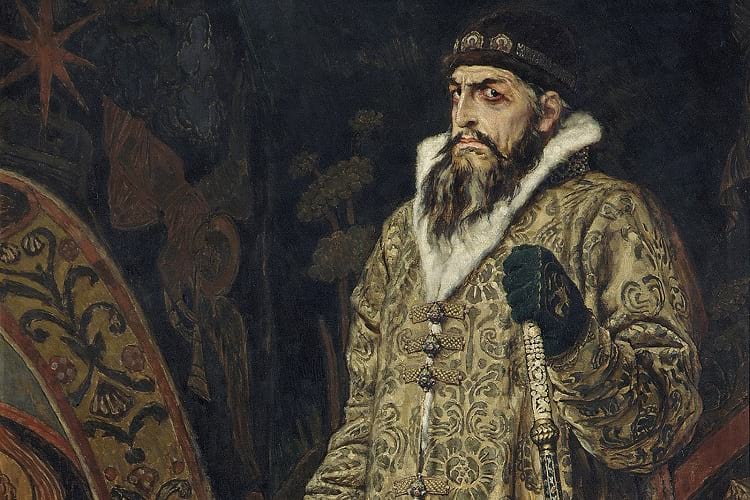
Painting of Ivan IV Vasilyevich more commonly known as Ivan the Terrible. (Tretyakov Gallery / Wikimedia Commons)
Russia has a fascinating history, akin to the likes of book and television series Game of Thrones in terms of many ruthless families vying for power and promoting their right to rule. One such family was that of Tsar Ivan IV, more commonly known as Ivan the Terrible. To continue the Game of Thrones comparison, he would represent the Mad King, or rather vice versa. Needless to say, it would not be a surprise if Ivan inspired the Mad King character. It must be noted that the moniker Terrible follows a more archaic meaning, as in to evoke terror. As opposed to the more modern meaning, of defective or bad. For Ivan the Terrible evoked terror in many people.
Background
By many accounts, Russian history began in 882 ACE, with the historical state of Kievan Rus initiated in Kiev – the capital of Ukraine – as it still stands today. This is a major reason why political and civil unrest persists between Ukraine and Russia. The Ukrainian governments have even insisted recently that the capital be Latinized and known worldwide as Kyiv (the Ukrainian way) as opposed to Kiev (the Russian translation.) Border disputes and protests still persevere with some Ukrainians wanting to be part of Russia, and some wanting to stay. Not to mention the matter of being a member state of the European Union.
The most accepted theory today is that Rus was created by Vikings, or the Varangians as the Slavic people call them. Widely recognized to be tribes from Sweden were commissioned to sail down the countless rivers snaking from the Baltic Sea into Rus. With the Slavic lands in disarray a Viking king called Oleg came to restore order, taking over and uniting many Slavic and Finnish tribes under one banner. He became ruler of Novgorod (a nearby city) in 879 ACE, succeeding a prince called Rurik, another Viking who had already established control of many regions including Novgorod which he ruled since 862. Oleg seized Kiev three years later in 882 ACE. The seeds had been planted for the Rurik Dynasty to dominate by this point which would last until 1598, compromising Kievan Rus and Muscovy (later named Moscow). It would have many famous and infamous rulers such as Alexander Nevsky, Ivan the Great alongside his cursed grandson Ivan the Terrible.
The early life of Ivan the terrible
Ivan Vasilyevich had a tumultuous early life which could be common for royal children of that time if they did not have strong family connections or if disaster struck. This was the case for young Ivan whose father died of an infected abscess when Ivan was three, and his mother died when he reached eight (many believe she was poisoned by ambitious family members).
Here began accounts and hearsay of Ivan as a disturbed and torturous individual. There are many sources for these but none are confirmed meaning much of it is still conjecture. Alas, based on his future acts there is perhaps a hint of truth in these horrors. He was said to torture animals, throwing them out the windows of the Kremlin. Later in life, there are reports that he used to beat, rape and hunt people. Even gouge out the eyes of talented architects who made beautiful structures for him so they would not be repeated again.
When his father passed Ivan was made the Grand Prince of Moscow yet his mother acted as regent during this time, controlling the nation on behalf of young Ivan. After her death, many Boyars (an elite class of families in high positions) strived for power, reportedly with many of their own interests at heart. At sixteen, in January 1547, Ivan was crowned the Tsar of Russia. He would be the first to hold this position as he created it. Taking the word from the Roman Caesar, the ambitious Ivan IV maintained that Russia would be the Third Rome.
To find a suitor for the young Tsar, at this time it was common to conduct a bride show, with up to 1500 daughters of noble families brought to court for the ruler to choose. Ivan IV chose Anastasia Romanovna – a famous name (Romanov) which would become more famous as it brought an already wealthy and powerful family, into more power and wealth. She held the title of the first Tsarina.
Early tests
In the summer of 1547, months after his coronation a fire would spread through the Russian Capital of Muscovy. In those times most buildings were made from wood which proved highly flammable when such an accident or arson attack occurred. The cause was never established but a political rival of the Tsar’s family – Yuri Glinsky – was accused of starting the blaze to cause upheaval in the Tsar’s kingdom. He was stoned to death. His family would later be removed from the government three years later by the spiritual leader of Russia – St. Macarius Metropolitan, further strengthening the position of Ivan. The Metropolitan is the head bishop, having authority over all bishops of an area such as Muscovy (mostly in Christian, and Orthodox churches) – he was very close to Ivan IV. The church and state continue to operate closely in many countries nowadays, arguably none more so than the Russian Federation.
Ivan set up his own council of advisors from the high-class families of Moscow. His advisors would consort with him regarding policy changes, the main ones being self-government in rural regions, improvements to tax collections and reforms in church and state. He improved the Sudebnik in 1550, a code of nationwide laws first founded by his grandfather. He also enlisted the first Streltsy – a permanent, standing army – who are still employed in the present day. The Moscow Print Yard was set up by Ivan in 1553 which seems an incredible endeavour and advancement. But tell that to the scribes of Moscow who were losing work fast. They tried to burn down the building and extort Russian printers, forcing some to flee the capital.
In terms of Foreign Policy, the Mongol Hordes were the biggest threat to Russia and Europe, made famous by the likes of Attila the Hun. Even after the decline and break-up of the Golden Horse their former lands were split into Khanates which proved rivalrous to Russia. They ruled the lands of Kazan and Astrakhan until Ivan defeated them in battle. One of the most famous structures in the world, let alone Russian, was commissioned with St. Basils Cathedral, to signal these victories and the conquering of the city of Kazan. He would not have the same success against another main rival in Lithuania to the west. Access to the Baltic Sea was demanded but they could not break through the federation of nations protecting it. In terms of trade, Ivan was happy to do business with England, opening up the White Sea port of Arkhangelsk to them. They would persistently maintain a close relationship with Great Britain in the centuries to come.
Ivan’s thirst to conquer the lands of Siberia turned successful when a rich family called the Stroganovs funded the expedition. They hired Yermak Timofeyevich – a Cossack (Eastern Slav) – who brought the stretching steppe under the red of Russia. Of course, much of Siberia was and still is uninhabited; the imperialism was simply in name, with tribes such as the Nogai Horde (a Turkic and Mongol diaspora) pledging allegiance.
Ivan’s secret police
When things started to go wrong for Ivan politically he abdicated in 1564. This was after several pitfalls which when combined plunged Russia into economic disparity. Drought and famine ensued because of defeats in war, invasions by the revenge-seeking Mongols, not to mention sea blockades by rival nations. Even the Ottoman Empire in the south became another thorn in the wilting rose, who would raid Russia for slaves as did the Crimean Khanate. The boyars pleaded for the Tsar to return to Moscow and he did so only after being granted absolute power of the Moscow region, the right to do so becoming known as the Oprichnina. This allowed him to create a secret police-come-bodyguard division known as the Oprichniki to keep the peace and protect his family.
Dressed in all black, riding jet-black horses they terrified the residents of Russia particularly when Ivan started to exhibit signs of madness. His dear wife, Anastasia Romanova was presumed poisoned in 1560 which is said to have been a driving force in the degeneration of the Tsar. Forensic autopsy uncovered a high level of Mercury in her bones (more so than common cures of the time would leave) to possibly prove this. Defection to Lithuania by many of his advisors led to more paranoia and distrust.
A thousand strong at its onset the Opichniki were based in Novgorod. They were headed by a ruthless character called Malyuta Skuratov who even killed a Metropolitan named Phillip on orders from his Tsar. Their wages were more than handsome as they looked to battle corruption and treason among the elite families which Ivan suspected of usurping him. He deliberately picked members from the low classes of Russia and even from other nations meaning they had no links to the Boyars and were loyal to him only. Their banners displayed a severed dog’s head.
A famous text written in Old Russian (used between the 15-20th Century) describes the massacre of Novgorod on orders from Ivan IV who led the battalions with his heir apparent Ivan. He believed conspirators to be rotting the core of the historic city. A plague had already struck the land with hundreds dying daily but more tragedy would arrive. Theorists blame the Oprichniki for taking too much from the peasants, as well as Russia’s doomed wars, including the Livonian War with their old enemy Lithuania among others.
Up to 60,000 people were executed in Novgorod; many tied to carts and wheeled into the Volkhov River for alleging to conspire against the Tsar. Many others were deported. With more research, it seems the numbers were significantly lower but the extermination and even pogroms did occur meaning Ivan’s madness was spiralling out of control.
Ivan the terrible and his son Ivan
By the end of Ivan’s reign, Russia was struggling economically. It would be a prelude to the Time of Troubles which plunged the Rurik Dynasty into disarray by the time Ivan’s son Feodor ascended the throne. Ivan started having vicious outbursts in court. He would imprison and torture countless people he believed to be traitorous, mostly Boyars. This sustained in his private life as accounts tell that he beat-up his daughter-in-law, due to a clothing disagreement. He then killed his son and heir Ivan when confronted about the attack, hitting him with as sceptre yet showing remorse immediately after. But these accounts may be exaggerated again, possibly lies from the elite looking to displace the Tsar. On the other side, Ivan was a devout follower of Orthodoxy, a representative of God – to the point that the punishments he administered were considered just to him if his victims had sinned.

Ivan after he killed his son; painting by Ilya Repin. (Tretyakov Gallery)
Whether true or not, it plunged Russia into uncertainty and jeopardised the Rurik Dynasty. It was said Ivan’s namesake Ivan Ivanovich was the only viable heir as his other son Feodor had mental and physical problems. A regent ruled for Feodor until he passed childless to finally end the Rurik Dynasty in 1598.
The death of the Tsar
On March 18, 1584, Tsar Ivan IV met his end due to a stroke while playing chess. Rumours heightened that a murder was behind it but Soviet scientists who excavated the grave found that Ivan IV died of natural causes.
While Ivan IV had obvious success with political reform and transformed Russia in many ways his psychotic methods (however exaggerated)– even for the time – is why he will never shed the moniker of Ivan the Terrible.
Enjoyed this article? Also, check out “Rasputin, Faith Healer? Or Lustful Charlatan?“.
Fact Analysis:
STSTW Media strives to deliver accurate information through careful research. However, things can go wrong. If you find the above article inaccurate or biased, please let us know at [email protected].
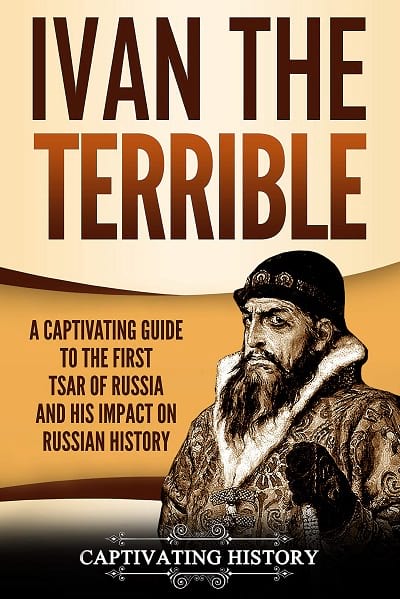 Recommended Read:
Recommended Read:
Ivan the Terrible: A Captivating Guide to the First Tsar of Russia and His Impact on Russian History | By Captivating History
Genre:
Non-fiction > History
RELATED
The post Ivan the Terrible: The First Tsar of Russia and His Reign of Terror appeared first on .
]]>The post Ancient Pyramids of Sudan from the Nubian Empire appeared first on .
]]>
Nubian pyramids, Meroë. (Christopher Michel / Flickr)
In modern Sudan, Africa lies the remnants of a powerful, ancient civilisation known as Nubia or the Nubian Empire. They are still represented in a series of pyramids known as the Nubian Pyramids of Sudan. Nubia is the oldest known civilization in Africa dating as far back as 2500 BC, home to several empires, the most famous of which being that of the Kingdom of Kush.
Another dominant civilisation in Africa – the Egyptian Empire – lasted for a longer time however and this is a major reason why less is known about the Nubians. There are not as many artefacts nor archaeological sites which have been uncovered. An example of this is in the famous pyramids in Egypt, for example the Great Pyramid of Giza. While Nubia have their own monuments they are not as famous nor as well visited as their neighbours.

The pyramids from a distant. (Valerian Guillot / Flickr)
The Kingdom of Kush
Not to be mistaken with the mountains of Pakistan or Afghanistan, these pyramids are in the ancient city of Meroe, 200km from Khartoum, Sudan. Meroe was the capital of Kush at the time of the construction of the pyramids. They were able to flourish as a civilization especially in times when they were independent from Egypt’s rule and living in relative peace. Economy boomed when this was the case as the Nubians lived off the land and mined many different types of ore, most notably gold. It allowed them to oversee over 200 pyramids alongside palaces with grand, exuberant designs. A prominent feature of the Nubian way of life was their legendary female rulers. This was different to many male-driven, patriarchal societies of the time. It was common for these female rulers to be buried with their bow and arrows, along with intricate stone rings which helped when drawing back the bow.
Kush became so strong that it eventually turned the tables and conquered Egypt under a king called Piye, around 730 BCE. This would start Egypt’s 25th Dynasty of rulers and unlock the mystery of there being Black Pharaohs – as in the colour of their skin – which was shown in many artefacts and writings. This dynasty lasted between c. 770 – 656 BCE and King Piye would be entombed within one of the Nubian Pyramids as tradition dictated. Yet the dynasty was put to an end when assaulted by Assyrians and later Kush was driven into the southern lands to a city called Napata by the time the 26th Dynasty of Egypt occured.
The Pyramids of Sudan

Aerial photo of the pyramids of Sudan. (B N Chagny / Wikimedia Commons)
Over 8,000 miles from the pyramids of Giza in Egypt stands another masterpiece of construction and architecture. Although a UNESCO World Heritage Site they are not so well known compared to other wonders of the world due to their geographical location mainly. The biggest pyramid of Giza is 756 feet while the tallest in Sudan are no more than 90 feet. There are over 350 pyramids in Sudan and most were built anywhere from 720-300 BCE to 350 ACE, over 2,000 years after the miracles in Egypt. The Nubians adopted many aspects of Egyptian life such as language and religion as well as the style of pyramids.
Nubia’s pyramids are different to the iconic ones of Egypt. They more resemble those built in the New Kingdom Period of Egypt (1539-1075 BCE) which was when the Nubians began to strongly assimilate Egyptian culture. The most famous ones are present at the ancient site of Meroe. Every pyramid has steps to the east which lead to the sealed entrances. This is different to the Egyptian temples where the doors face north but the reason why is still to be ascertained.
Egypt’s temples are almost perfectly aligned to the four cardinal points – North, South, East and West. There are several theories existing which believe the Egyptians used the sun and moon to do so, based on the Fall Equinox. This is where the sun lines with the Equator, with the length of day and night being the same for one day. It is not known the reasoning for the positioning of Nubia’s monuments but it is likely something more than meets the eye. Website Live Science explains the theory behind Giza’s positioning.
“The builders of the Great Pyramid of Khufu aligned the great monument to the cardinal points with an accuracy of better than four minutes of arc, or one-fifteenth of one degree,”
But as explained by Live Science, there are not any concrete explanations.
“The Egyptians, unfortunately, left us few clues. No engineering documents or architectural plans have been found that give technical explanations demonstrating how the ancient Egyptians aligned any of their temples or pyramids,”
Inside the sealed entrances are the riches of the deceased as well as the deceased themselves. They rest beneath the pyramids in sepulchral chambers some of which in mummified forms. Many have a wooden coffin with their face painted upon to let visitors in this realm or the next know who lies beneath. Sacrificed animals and slaves lay nearby to assist them in their passage to the afterlife as stated in Egyptian and Nubian religion. Their belongings such as the stone rings mentioned before are with them, many items from trade with the Greek Empire also exist showing that interspersion with Empires outside Africa was flourishing even at this time. Many quotes and images from a famous Egyptian funerary text called The Book of the Dead decorate the insides. Statues have been unearthed, most commonly that of Ba – a human head with the body of the bird who represents the human soul’s mobility after death. Outside, the exterior stones would be set in plaster and painted bright colours, plaster which has since worn away.

The ruins of Temple of Amun in Nubia. (Christopher Michel / Flickr)
The decline of Nubia
The Nubian Empire remained prevalent with the Kingdom of Kush until the infamous Queen Cleopatra’s death in 30 BC – the Queen who had dalliances with Emperors Julius Caesar and Mark Antony – as the Roman Empire took over. This mighty empire would suppress the Nubians as far south as Aswan, in southern Egypt. Meroe would become uninhabited by the 4th century AD but was brought to the attention of archaeologists when an Italian grave robber called Giuseppe Ferlini brought back some artefacts from his missions to steal gold from the tombs. During these raids, he inflicted a massive amount of damage in setting off explosives in 40 of the tombs to gain access. He believed it would not have a lasting effect on the potential historical data or perhaps he did it regardless. Much of his lout was sold to King Ludwig I of Bavaria, Germany; a procurer of riches.
Despite this destruction there is still a massive amount of history buried within the magnificent Nubian Pyramids of Sudan. While many of which are considered too dangerous to examine due to flood waters and fragile foundations, some organisations such as National Geographic have donated money to learn more, and continue to do so.
Below is a brief timeline by National Geographic on the Nubian culture from the period of the Meroe Pyramids.
8th Century B.C.
Construction of the south and west cemeteries [pyramids] begins in Meroë, then the second city of the Kingdom of Kush, whose capital was at Napata.
3rd Century B.C.
As space in Meroë’s south cemetery runs out, expansion begins in the north cemetery of the city’s growing necropolis.
250 B.C.
King Arakamani relocates the royal necropolis from near Napata to Meroë, which becomes the kingdom’s spiritual and political capital.
1st Century A.D.
Queen Amanirenas leads her troops against the Romans. Her successor, Amanishakheto, is buried with costly grave goods.
2nd Century A.D.
Building methods change. The Meroë pyramids are faced with brick instead of stone, and then a layer of plaster, which is painted.
A.D. 350
An invasion by the kingdom of Axum brings Meroë’s dominance to an end. The city and royal necropolis are eventually abandoned.
Enjoyed this article? Also, check out “Important New Discovery May Provide Insights into the Construction of the Pyramid of Giza“.
Fact Analysis:
STSTW Media strives to deliver accurate information through careful research. However, things can go wrong. If you find the above article inaccurate or biased, please let us know at [email protected].
RELATED
The post Ancient Pyramids of Sudan from the Nubian Empire appeared first on .
]]>The post Rosalia Lombardo: The 8,000 Skeletons, 1,252 Mummies and a Fallen Angel Who Rest Within the Catacombs of Capuchin appeared first on .
]]>
Rosalia Lombardo in her glass coffin. (Sibeaster / Wikimedia Commons)
On the historical island of Sicily sits the Sicilian capital of Palermo, resting on the toe of Italy’s boot-based geographical shape. It is a location rich in history – between Europe and Africa – on the banks of the Tyrrhenian Sea. It was founded in 734 BC by the Phoenician Empire who we have spoken about many times on STSTW Media as one of the defining civilisations of our time. Later it became part of the Roman and Arab Empires before unifying with the modern-day Kingdom of Italy in 1861. A city steeped in religious history; it was also home to a Catholic sect called the Capuchins (An order of friars and one of the main offshoots of the Franciscan order –created by famous religious devout Francis of Assisi). Much of their rules involved living in as much austerity that was practical.
Friars live their lives in servitude to society and the Capuchin friars created a monastery which in due course had the crypts below it excavated in 1599 when the graveyards filled – henceforth known as the Catacombs of the Capuchins. They began to mummify dead friars and before long this technique of preservation after death became a sought after practice for the high classes of Sicily. Their families would continue to fund the monks who cared for the deceased for example with new clothes.
Into the crypts
Palermo is a city with amazing architecture which much of its designs remaining from the Norman and Arab invasions. The Normans were a group from France unified by a famous Viking called Rollo who took over much of Europe. They were famed for their Romanesque architecture, characterized by semi-circular arches.
“The impact of a new culture of Nordic tradition on Sicily in the 11th-12th century led to a new architectural style: Palermo’s Arab-Norman architecture introduced innovative elements from the north of Europe, such as…towers at the sides of façades, within Byzantine layouts, such as the greek-cross plan inscribed in a square, and structural or decorative details of Islamic origin, such as pointed arches…”
Another writer speaks of the temptation and sights that Palermo offers to some famous people of history past,
“A unique cultural heritage that in many centuries has attracted and fascinated onlookers from all over the world, including many intellectuals, poets and writers such as Alexandre Dumas, Mario Praz, Guy de Maupassant, Fanny Lewald and Carlo Levi.”
Its stunning streets and crossroads run to the Capuchin Monastery, another building of fine intricate beauty. However, once down the stairs the scene begins to change to a more basic overlay. For after all, the dead have no need for grand decorations in this realm they leave behind. A multitude of skeletons line the walls in these catacombs to give a more than eerie vibe, and having experienced it for myself a strange sensation runs through as one enters the cold surroundings. Many find it too overwhelming to be underground with what looks like an army of the dead from a horror film, including an Argentinian companion of mine who had to surface for air and rejoin the mortal beings above.
Amazingly, 8000 skeletons (although a more accurate number is said to be closer to 2,000) and around 1250 mummies inhabit the catacombs. All of which would have had a unique story to tell. They are arranged in sections such as religious figures, professions, women, virgins and children.

A corridor of mummies inside the catacombs. (Sibeaster / Wikimedia Commons)
Rosalia Lombardo – The sleeping beauty
One resident was not famous in her short life but became infamous in death. Her name is Rosalia Lombardo who died on November 6th, 1920 with only two summers to her name and remains the youngest on show. (The oldest is a friar from 1599 called Silvestro da Gubbio). Rosalia died due to pneumonia in a region which becomes extremely cold in the winter months. Her father Mario Lombardo was understandably so beset with heartache that he sought out a renowned local embalmer by the name of Alfredo Salafia. He used many modern and original techniques to mummify young Rosalia to perfection.

Rosalia Lombardo. (Sibeaster / Wikimedia Commons)
Concoction of conservation
When reports of Rosalia Lombardo’s eyes opening shocked the local community an Anthropologist called Dario Piombino-Mascali investigated the catacombs. He has worked on many projects in the past including Ötzi – the Tyrolean Iceman from Italy and the Kabayan Mummies also known as the fire mummies of the Philippines. The mystery was soon solved when he observed that a filtration of light from the windows was catching her eye-lens to cause the illusion of life. He also sought the embalmer’s elixir of preservation which has kept her form so perfect even until this day. The embalmer’s relatives gave him several of Alfredo Salafia’s documents.
“Salafia recorded the chemicals he injected into Rosalia’s body: formalin, zinc salts, alcohol, salicylic acid, and glycerin.”
They act as such:
Formalin (formaldehyde and water) – eliminates bacteria
Alcohol – dries the body
Glycerin – keeping the body from becoming too dry
Salicylic acid – to stop the growth of fungi
Zinc salts – to keep a state of preservation
Zinc – to petrify the body
This added to an intricate system of drying rooms within the catacombs which implement pipes to drain any excess water and ultimately keep the bodies of the deceased dry. After which, they were bathed in vinegar and stuffed with hay. Many of the bodies who hang on the walls were protected in cages because some tourists had a kleptomaniacal penchant for taking bones as souvenirs.
In regards to the prized and most adored attraction – Roaslia -a glass case has been added with Nitrogen gas to further stop the process of decay after signs of decomposition began to show in 2009. It is so amazingly well-maintained that even X-rays show the internal organs to be intact.
A memento mori
Life is full of constant reminders that we will one day die. The older we get, the more constant they appear. A visit to the Catacombs of Capuchin is the ultimate reminder – or Memento Mori (in Latin) – that we too will join the endless ranks of the dead alas perhaps in not such a spectacular setting. The beautifully peaceful yet pallid face of the fallen angel Rosalia Lombardo is a chilling aide-mémoire that death can come anytime and to anyone.
Enjoyed this article? Also, check out “Children of Llullaillaco: Where Young Children Were Sacrificed to the Gods“.
Recommended Visit:
Catacombe dei Cappuccini | Palermo, Italy
Fact Analysis:
STSTW Media strives to deliver accurate information through careful research. However, things can go wrong. If you find the above article inaccurate or biased, please let us know at [email protected].
RELATED
The post Rosalia Lombardo: The 8,000 Skeletons, 1,252 Mummies and a Fallen Angel Who Rest Within the Catacombs of Capuchin appeared first on .
]]>The post Hetty Green: The Richest American Woman Who Was Known for Her Extreme Miserliness appeared first on .
]]>
Portrait of Hetty Green. (Library of Congress)
At the age of thirteen, Henrietta ‘Hetty’ Howland Robinson was acting as an accountant for her family’s business interests. This was fueled by her Grandfather Gideon Howland becoming blind and having her read the financial newspapers to him, however this was no ordinary family to begin with. It was one who made a great deal of money – modern day millions – primarily in the shipping and whaling industries. They were a well-known Quaker family – a Christian Sect, who were based in Massachusetts, one of the thirteen founding colonies on the North-West US coast.
She was born in 1834, a common time for girls to marry into wealthy families but Hetty was opposed to this tradition as she had a thirst for entrepreneurship, even selling many of the clothes her father had purchased for her to help in finding a suitor.
A head start
Giving her grandfather updates on the financial world is a helpful hand many youngsters would receive but few would have the opportunities Hetty had in terms of education – especially for that time. For instance, she enrolled in a prestigious boarding school called Eliza Wing. This was funded by her family, and her father – who became president of the family whaling company – took her to meet many stockbrokers with him to further her tutoring. Outside of this, her extra-curricular activities involved business-based developments, mainly learning from her father’s everyday life. She would move to New York after attending finishing schools in Massachusetts, seeking a more independent life.
During this time in the city called the Big Apple Hetty would inherit fortunes from her family members including a $8,000 house from her mother and $20,000 from her aunt. (This combined would be almost $800,000 in today’s money). Her father’s death would leave her the equivalent of almost $100,000,000 ($5 million for their time).
Furthermore, she would add to her fortune in winning legal battles from other family wills. She finally found a suitor (on her own time) when she was married to Edward Henry Green, another millionaire, taking his name and having two children called Edward and Sylvia. Albeit she forced him to denounce all rights to her money and inheritance. Edward was happy with this and they would move to London together. Legal trouble with Hetty’s cousins contributed to them leaving America also with several arguments emerging concerning the court battles.
Simple strategies and wearing the ‘pants’ in the relationship
Hetty had a self-confessed simple strategy of buying when prices are low and the items not sought after, storing them, and then selling them when the prices rose.
“I buy when things are low and nobody wants them… I keep them until they go up and people are crazy to get them. That is, I believe, the secret of all successful business.”
This meant she would keep unwanted items in her warehouses until they were wanted again. A seemingly easy algorithm but one which requires a great deal of storage space, which not everyone has. She made $1.25 million profit in her first fiscal year in London mainly on railroad stocks and mortgage bonds.
The Greens moved back to the US after being successful in London but after financial trouble, Hetty bailed out her husband who was $700,000 in debt. She amassed so much money that she became known as the Queen of Wall Street – the famous financial district of New York.

Hetty Green’s residence in Vermont, United States. (Library of Congress)
Miserliness
It is common to hear stories of multi-millionaires who cut corners and are very frugal, leading very simple lives but Hetty Green went far beyond this, if reports are to be believed. Rumours go that she never used hot water or gas heaters. She would eat extremely cheap food, only wear clothes until they were completely worn out and rarely washed to save on soap. She would travel thousands of miles to chase up small debts. Her view would be however that,
“Just because I dress plainly…. They say I am… insane.”
For these reasons, her moniker was changed from the Queen to the Witch of Wall Street. Maybe this affront can be attributed to a male-dominated society at the time alas, in an attempt to scupper competition. As well as the typical media sensationalism.
Possibly these techniques of hers were not just down to money saving. She mentioned that it was boring going out in high society and staying in a fancy, big house all day. That she liked to mingle with other peoples.
“I should get very tired of living in one of the great houses in New York… They don’t have any real pleasure… It’s intercourse with people that I like.”
This can be believed because it was found out that she gave much to charity over the years, all the while in secret. Green was reported to have even bailed out the city of New York on occasions such as the Panic of 1907 where riots occurred because of a crash in the stock exchange.
All of this seems relatively harmless except for the next rumour. Green was spotted in a free clinic when her son suffered a broken leg. Newspapers reported that she was so frugal as to not treat her son’s broken leg privately. His leg did not heal and was amputated later in life. Another reason for this miserliness could be from her religious affiliation.
“I am a Quaker, and I am trying to live up to the tenets of that faith.”
Hetty Green’s legacy
Her son, Edward, spent his life managing several of his mother’s properties in Texas and Chicago then spent time with his mother in her final months. The daughter, Sylvia, took a more traditional route of finding a suitor but her mother deemed them unacceptable thinking they were all gold-diggers. She would accept a man named Wilks who had a small fortune but only after he agreed to sign out of the inheritance as Hetty’s own husband once did. During her later years, Hetty spent time in basic apartments in New York, self-treating a hernia problem before passing away at 81 in her son’s home. The cause of death was apoplexy resulting from a stroke. It was said she suffered several of these in the run up to her death.
Buried in Beaver Falls, Vermont, next to her husband, Hetty Green’s final fortune was between 2.3 and 4.6 billion in today’s worth. It was split between her two children. They were nowhere near as miserly as their mother though as they were more extravagant whilst still being successful, even getting through the Great Depression unscathed financially. On their deaths, Sylvia donated most of her wealth to charities and hospitals. Edward – a collector and innovator – had his estate donated to MIT (the Massachusetts Institute of Technology). Both were buried in Beaver Falls with their parents.
Writer’s opinion
We study many characters on STSTW Media who fall between the fine line of genius and madness. It seems Hetty Green was of the same ilk. An eccentric persona but one with undeniable talent, fortitude and ruthlessness. Different from the classic entrepreneurs of the time who were mainly industrialists, Green moved more in real estate and loaning. More than an entrepreneur she was a feminist who provided a massive leap for females in the business world.
“It is the duty of every woman, I believe, to learn to take care of her own business affairs.” She would remark, “A girl should be brought up as to be able to make her own living…”
Now, in many parts of the world – included where Hetty lived – it is commonplace.
A final note is from Hetty Green’s favourite poem. It is called My Symphony by William Henry Channing and gifts further belief that she wanted to experience segments of a working class life. Perhaps this will illustrate her character more than anything,
To live content with small means; to seek elegance rather than luxury, and refinement rather than fashion; to be worthy, not respectable, and wealthy, not rich; to listen to stars and birds, babes and sages, with open heart; to study hard; to think quietly, act frankly, talk gently, await occasions, hurry never; in a word, to let the spiritual, unbidden and unconscious, grow up through the common — this is my symphony.
Fact Analysis:
STSTW Media strives to deliver accurate information through careful research. However, things can go wrong. If you find the above article inaccurate or biased, please let us know at [email protected].
RELATED
The post Hetty Green: The Richest American Woman Who Was Known for Her Extreme Miserliness appeared first on .
]]>The post Byblos, Lebanon: A World Heritage Site and the Oldest Continuously Inhabited City in the World appeared first on .
]]>
Byblos, Lebanon. (Selbst fotografiert / Wikimedia Commons)
Formed in the Levant (Western Asia), the ancient Phoenician civilisation – known internally as Canaan – is one of the foundations of modern civilisation. Despite being extinct, their innovative influence resonates today in all corners of the world. Lisbon and Barcelona are among some of the major cities said to have begun as Phonetician settlements but most certainly they created a civilisation in Carthage, North Africa who would become their descendants.
The Carthaginian Empire expanded across Northern Africa into the Iberian Peninsula of modern Spain. They ventured as far north as the island of Corsica, which brought them into direct contact with the Greek and Roman Empires. Naturally, the diffusion of cultures occurred. The Carthaginians most famously fought a series of wars with the sprawling Roman Empire. These conflicts were called the Punic wars, a Latin term which derived from their word for Phoenician. Carthage and Phoenicia will be familiar to hear but perhaps their history will be less known.
Phoenicians lived in a Thalassocracy – a nation dependent on sea-power – meaning they had a vast navy and very seldom inhabited land areas. For this reason, they brought about huge developments in boat building, nomadic lifestyle and sea warfare. They rose in the Levant, near modern-day Lebanon when the Fertile Crescent was still lush yet soon stretched to Turkey, Israel and Syria. They spoke an ancient Semitic language which became one of the basses for many modern languages today. Basically, they invented the alphabet system used now in most Indo-European countries. In actual fact, the font was first discovered in Byblos, inscribed on a tomb of a Phoenician King called Ahiram. It is called Cuneiform and consisted of 22 letters, which greatly influenced the Greek alphabet that in turn developed Latin and Cyrillic (used in Russia and many Slavic countries).
An example; Christ in Greek, Russian, English script.
Χριστός, Христос, Christ
Prehistory of Byblos
Byblos is located 42km north of Beirut, the capital of Lebanon. There is enough archaeological evidence to suggest that it has been continuously inhabited since early in the Neolithic Age, 7-9,000 years ago depending on which source one draws from. This ranks as one of the highest in the known world. And while other towns are thought to have been continuously inhabited for longer – such as Annaba in Algeria (occupied since the 14th century BCE) – none are historically as important as Byblos. To emphasize this, Byblos has been found in Hieroglyphics within Egyptian writings (notably in the myth of Gods Isis and Osiris) meaning it was a key region during the time of the Pharaohs and the Nile River Valley civilisations. An Egyptian Goddess – Baalat (the Mistress) – is also immortalized in a temple which has stood the test of time. In terms of Phoenician Gods, Baal and Yamm – the gods of the Sky and Sea – played out an epic battle in Byblos. The Akkadian Empire from Mesopotamia also had one of its dialects found in the town, that of Assyrian Cuneiform (the other being Babylonian).
Alexander’s Hellenism, the reach of Rome and the decline of Phoenicia
The Akkadian Empire split into two factions: Assyria and Babylon believed to be due to changing climates and the decay of rain-fed agriculture. It forced the Assyrians to become the dominant force in Phoenicia however they favoured another famous city named Tyre – residents of Tyre would begin the Carthaginian colonies by creating Carthage in modern Tunisia. A number of great Emperors have influenced the control of Byblos including Alexander the Great in his campaign with the Macedon Empire – a Greek state. In the 4th Century BCE, he implemented a Hellenistic period, promoting Greek culture and language after taking over the city. Alexander was notorious as a leader who allowed cultures, languages and religions of the former civilisations to remain and flourish also. Alas, he had an untameable ruthless side also, and that side destroyed much of the city of Tyre and its people in 332 BCE.
Another empire and war general would approach in the Roman conquest during the afore-mentioned Punic Wars. This was in the form of Pompey the Great. By 64 BCE all of Byblos, Tyre and Carthage had been conquered by the Romans. Many historians now agree that the Romans completely wiped out the Carthaginian civilisation after their victory. So extremely so that it has been labelled the Roman Holocaust with tens of thousands being exterminated.
“After sacking the city, the Romans burned it to the ground, leaving not one stone on top of another.”
The Phoenician Empire slowly disintegrated after having so many of its prized assets imperialised. Its remaining lands were given to the legendary Cleopatra of Egypt. To make this even more confusing, even though Cleopatra ruled an Egyptian Empire it was the Ptolemaic Dynasty she inherited which was a Hellenistic (Greek) state. Long after the time of the Pharaohs. This state was set up by a follower of Alexander the Great, a commander called Ptolemy who Cleopatra was a descendant of. Furthermore, Cleopatra had relationships with the Roman Emperors Julius Caesar and Mark Anthony. With her death, Egypt became a province of Rome.
A revolving door of legends
They would do as Romans do following these events to everywhere they ruled, creating straight roads, baths and aqueduct systems among others. When the Roman Empire split into two, the Byzantine Empire (Eastern Roman Empire) controlled the region until the Early Muslim Conquests under another legendary prophet Muhammad, took back Byblos in the 7th Century ACE. During the Crusades, Byblos bounced between the Christians and Muslims. The European Christians built one of the most famous structures – St. John the Baptist Church in the 12th Century to command dominance which still stands today. Another famous leader captured Byblos in 1189. Saladin or An-Nasir Salah ad-Din Yusuf ibn Ayyub to give his full name was part of the Ayyubid dynasty of Egypt (once the Arabs took it back from Rome). An-Nasir Salah ad-Din was gifted to him meaning ‘Mighty defender, the righteousness of faith’. Again Byblos was not used as a major hub mainly because Saladin’s dynasty, as with other Arab factions preferred to use cities more inland.

Saint John Church, Byblos. (Serge Melki / Flickr)

Obelisk Temple, one of the earliest temple in Byblos. (Heretiq / Wikimedia Commons)
There were no more events as significant as these when Byblos passed through the Ottoman Empire, and then the French Mandate following World War I. Its people finally lived in relative peace which was briefly disturbed by the Lebanon War in 2006. French Archaeologists and Egyptologists discovered the site in 1921.
From these waves of occupation, the history of Byblos can be seen from its archaeology: Crusader forts, Roman ruins, Phoenician temples and a Greek necropolis to name a few. Even Neolithic settlement evidence remains. Byblos understandably became a UNESCO World Heritage site in 1984 continues to thrive as a tourist town.

Byblos Port, the oldest port in the world. (Elias zaghrini / Wikimedia Commons)
When was the first civilisation?
There is the famous maxim that the more we find out the less we know. As soon as we believe we have uncovered the roots of civilisation more are exposed. It is commonly agreed that the oldest civilisations began as early as 7,000 BCE (Neolithic) but theories of organised societies have been argued as much as 200,000 years ago. Evidence of this was discovered in Annaba (present-day Algeria), another once Phoenician town.

Byblos Castle. (Peripitus / Wikimedia Commons)
With the timeline of modern human evolution as far back as 1.7 million years ago (at this point in time) is it possible that there were empires as far back as that. Many argue that they had the same brain power so why not? Some even argue that our ancestors, the various genera before modern humans such as the Denisovans had similar brain power so who is to say that before the Homo genus (or outside the Homo genus) there were no civilisations?
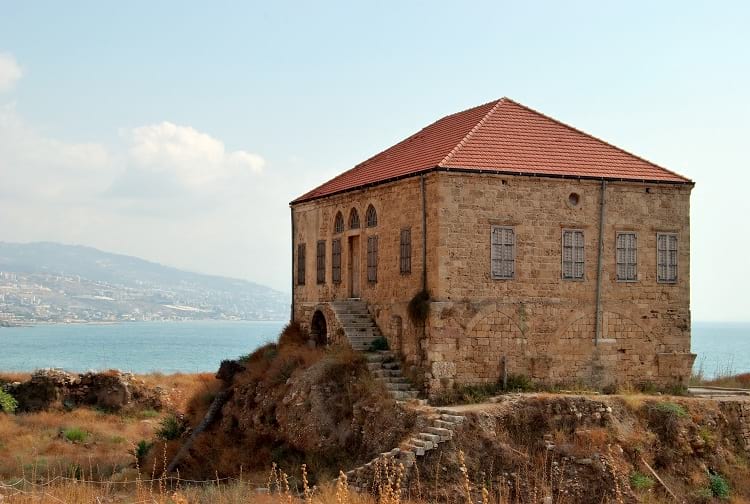
A traditional Lebanese house from the 19th century. (Peripitus / Wikimedia Commons)
It is very much possible that those empires have disappeared after time much in the same way that the Phoenician Empire almost did. Or the Indus Valley, Jiahu or Mayans to name a few others. How far are we into the timeline of human civilisation? How long will our empires last? Will evidence remain after we are gone? And for how long?
Enjoyed this article? Also, check out “Yemen’s Ancient Town of Shibam is Also Known As ‘Chicago of the Desert’“.
Fact Analysis:
STSTW Media strives to deliver accurate information through careful research. However, things can go wrong. If you find the above article inaccurate or biased, please let us know at [email protected].
RELATED
The post Byblos, Lebanon: A World Heritage Site and the Oldest Continuously Inhabited City in the World appeared first on .
]]>The post Burke and Hare: Two Body Snatching Serial Killers Who Sold Corpses for Anatomical Science appeared first on .
]]>
William Burke (left) and William Hare (right). (Wikimedia Commons)
As hideous a thought it is; corpses can be a lucrative business. And we are not just talking about animal carcasses. The human cadaver trade was more common in the past of course, when medical science was in its infancy but it still transpires today for many reasons, depending on the part of the world. One of the most famous cases of corpse-snatching came from Scotland in the year 1828. Not only were the corpses stolen, but the perpetrators actually killed their victims in order to make money from the remains. Their names are infamous but how did Burke and Hare manage to commit sixteen murders while making a small fortune of cash before they were noticed?
The Setting
In this era, much internal anatomical research was resigned to taking a blade to a dead body. For this reason bodies were sought after by universities and hospitals alike but this could usually be provided in a legal way. For example, the deaths of prisoners, orphans or those who committed suicide was considered just within the Scottish Law system. It became such a successful endeavour in terms of medical enlightenment that there became a shortage of corpses. This eventually led to the term of body-snatching being coined much of which came from grave-digging. It was popular in the capital of Scotland, Edinburgh as it was one of the leading centres of anatomic study at said time. It was also known as ‘Auld Reekie’ [Old Smokey] to illustrate the amount of smoke plumes from the factories propped up by the ongoing industrial revolution. As a leading exponent of the British Empire, Edinburgh was a thriving city in this aspect. A rise of medical studies meant that more corpses were required than were readily available. In turn, this gave rise to some ill-willed people who were tempted by the prices these bodies could fetch – as much as ten pounds in the winter months – a decent sum for that time (a decent weekly wage was one pound). It became such a demand that citizens of Edinburgh started to take measures to stop the bodies of their relatives from being disturbed. Such tactics included protests, employing watchmen at graves and installing protective equipment like grave-cages or stone slabs to cover a mound. It meant that stealing corpses became so difficult that some extremely ill-willed people decided to target the living instead.

Grave cages in a churchyard, Logierait, Scotland. (Judy Willson / Wikimedia Commons)
The resurrection men
Burke and Hare were both called William but they led very different early lives and had very different characters according to reports. William Burke had a middle-class upbringing in Ireland and joined the army in his teens. He moved to Scotland where he took up employment at the Union Canal – a Scottish canal system primarily constructed to bring coal to Edinburgh. His character was judged by many to be jovial but hard working as well as religiously devout too. In 1827 he decided to go north to earn some money during the harvest. This is where he met William Hare, a fellow Irishman who had a clouded yet seemingly dark past. It was said he worked as a labourer and also spent some time on the Union Canal like Burke. Eyewitness reports stated that Hare had a lot of scars and was considered a very temperamental person – especially after a few drinks. When they returned to Edinburgh, Burke took a room at Hare’s lodging house in a street called Tanner’s Close and the pair developed a bad reputation fuelled by a love for the bottle.
A cursed lodging house
Causation paved the way for a truly horrific act. One of the lodgers at the Tanner’s Close Lodging House passed away whilst owning four pounds of rent. He was due to receive some of his army pension when this happened. William Hare decided to sell the body to an anatomist to retrieve the amount owed. They reported the death to the local authorities and while a local church donated a coffin for the burial, the two men hid the body and instead filled the coffin with tree bark. When darkness fell, they took the body to Edinburgh University and found a most willing Dr. Robert Knox, who negotiated the price with other doctors. They apparently hinted at wanting to receive more bodies.

Depiction of Dr. Robert Knox in Surgeons’ Hall Museums, Edinburgh, Scotland. (Kim Traynor / Wikimedia Commons)
The bad doctor
There is the famous epitome of a fine line existing between genius and madman. It seems a touch of this was inherent within an obvious talented doctor who was happy to accept corpses from far from obvious legal circumstances. This was a man who contracted smallpox when young, to the point of disfigurement and blindness in one eye. He served as a physician in the Battle of Waterloo between the British and Napoleon’s French as well as the Cape Frontier War in South Africa, in which the Xhosa Kingdom defended against European forces. After settling in Edinburgh, Knox gained employment at the Royal College of Surgeons and gave lectures using fresh cadavers which drew crowds of fascinated students. With at least two dissections a day he had a pressing need for the dead.
Doing anything for money
Burke and Hare soon turned to murder. Sources differ but it seems they decided to suffocate a lodger who had grown sick with fever. His name was Joseph and another woman tenant Abigail Simpson was killed with a similar method – she came to Edinburgh at times from her local village to sell salt. At that time, asphyxiation was impossible to detect in terms of a post-mortem examination. The next prey was an English seller who contracted jaundice. They used the same method of Hare suffocating while Burke – as the bigger man – lay on the chest to stop the struggle.
People would later call the practice burking. Dr Robert Knox would pay ten pounds for many of these bodies, complimenting them on their freshness according to Burke and Hare’s confession. Yet he never asked any other questions. Some of his colleagues would however, drawing no confessions from the killers. Another – Mary Paterson –had been befriended by the men and spent a day drinking together. They killed her in her sleep. An old lady named Mrs Haldane met the same fate, as did her daughter who spent a night at the lodging house. However, this time it was only Hare who killed her and kept the fee for himself. The relationship of the two men became strained because of this, Dr Knox admitted buying a body from Hare alone – something Hare denied. Burke and Hare ended up in a drunken brawl but continued their illicit business. There were sixteen victims who met their end this way, plied with alcohol and when in the confines of the lodging house they were executed. An old woman and a possibly mentally disabled boy were two murders which truly disturbed Burke he would later say. They used a fish barrel to take the bodies to Knox.
Another chilling story is that when Hare’s horse could not transport the barrel far enough so he shot it dead in their garden. This shows the ruthless, unbalanced side to his nature – if true. Next up would be a lady who came to do laundry. Burke and Hare did the usual of getting their victim drunk and then suffocating them once both parties were inebriated enough. A relative of Burke’s wife came after, then a mentally disable eighteen year old boy called James Wilson. Wilson was well-known among the community because of his handicap. This meant that people noticed he went missing, and some students of Dr Knox believed the cadaver to be his. Knox denied it and began dissecting the body as soon as possible according to reports. The last murder was in October 1828 and the thread began to truly unravel from the most wicked of wool.
An Irish lady named Margaret Docherty was lured to the house. Two other guests saw Burke, Hare and both their wives drinking in high spirits within the common room with Docherty – singing, dancing and all. They had all become extremely careless. Later, they executed Docherty. The next day, the couple called the Grays – who had seen the festivities the day before – felt something wrong in the air. They found Docherty’s body in a bed of straw after surveying the house. The wife of Burke (both wives knew what their husbands were doing) tried to bribe them to keep quiet but they refused and bravely sought the Police. By this time Burke and Hare had taken the body to Knox, but the Police found enough blood in the lodging house to arrest them. Burke would admit to the murders. He confessed to sixteen kills all while being drunk or on opium. He stated that he could not sleep without a bottle of Whiskey next to him.
The Lord Advocate of Edinburgh decided that due to lack of evidence they would need another tactic. He would force a confession from only one man by offering immunity from prison. William Hare sang like a bird against Burke. Knox would not face any charges, as although what he did was abhorrent he did not encourage any murders, nor did he break the law.
The trial of Burke and Hare
The trial would take place on Christmas Eve, 1828. On Christmas day, William Burke was sentenced to death and the judge demanded he be publicly dissected and his skeleton to be displayed. An ironic case of an eye-for-an-eye. Both wives were acquitted for not having anything to do with the murders. After being hounded viciously by angry mobs the Police gave Hare’s wife safe passage back to Ireland, while McDougal (Burke’s spouse) escaped Edinburgh. Nothing was heard of the two women ever again. William Hare escaped to England through hordes of people wanting him trialled or dead. Dr Knox was never charged but he was harassed by the public, although not to the extent of the wives of the killers. Even though the Police told the public that he did not know the bodies had been murdered he lost his job and would struggle to find more work in Scotland. He then so, took a position at a surgery in England.

Death mask of Burke (left) and life mask of Hare (right). (kim traynor / geograph.org.uk)
Aftermath
A new year brought the end to the chaos but not the justice with William Hare walking free. William Burke was hanged in front of a crowd of over 25,000 people. His corpse was dissected in Edinburgh University shortly after and his skeleton remains to this day in the Edinburgh Medical School. New laws were passed to stop corpse-snatching from happening again. Especially after two men from London – known as the London Burkers – attempted the same thing. The Anatomy Act of 1832 meant that bodies could only be dissected if unclaimed after 48 hours. A truly, horrible story it is impossible to fathom the lives these men lead. To kill in the way they did takes a very wicked or disturbed person – even under the influence of narcotics and alcohol. The tale has been immortalised in multiple films, books and theatre shows. It will never be forgotten.
Enjoyed this article? Also, check out “H. H. Holmes: Life of America’s First Known Deadliest Serial Killer“.
Recommended Read:
Burke and Hare: The Year of the Ghouls By Bailey, Brian (2002) | Edinburgh: Mainstream Publishing. ISBN 978-1-84018-575-1.
Fact Analysis:
STSTW Media strives to deliver accurate information through careful research. However, things can go wrong. If you find the above article inaccurate or biased, please let us know at [email protected].
RELATED
The post Burke and Hare: Two Body Snatching Serial Killers Who Sold Corpses for Anatomical Science appeared first on .
]]>The post Voyager Golden Records: A Package for the Extraterrestrial from Planet Earth appeared first on .
]]>
Scientist mounting Golden Records on Voyager spacecraft. (JPL / NASA)
It would be a Red Letter Day if alien life is contacted. Motions have been set in place to make this happen but at the very dawn of space exploration it is thought to be hundreds of thousands of years from happening… if at all.

Carl Sagan. (JPL / NASA)
One such motion took place in 1977 when the Voyager Golden Records were launched into the cosmos, two vinyl records which are aboard two spacecraft which launched under the same name. Within the records is a variety of media based on the history of civilization including sounds and images. It is considered a Time Capsule in the sense that it is more likely that humans from the future rather than aliens will find them. Like a message in a bottle, Astronomer Carl Sagan explains it as sending a “…bottle into the cosmic ocean.”
The two spaceships are not destined for anywhere in particular but the most notable of stars – a Goldilocks zone – known as Gliese 445 will be passed in 40,000 years. Needless to say, it is a mission for the future.
Each record is encased in an aluminium casing with a cartridge to play it and a needle. Also, there are instructions on how to use it.
The two sides of the disc

The Sounds of Earth Record Cover. (NASA on The Commons / Flickr)
Illustrations
• The two circles on the top left show states of the Hydrogen atom and the movement of the proton and electron.
• The Square below is to do with rendering. If the record is correctly rendered then this should match the first image.
• An image frame with vertical lines.
• Vertically staggered lines.
• A diagram illustrating how pictures are made. Showing video signals and binary codes.
• Binary arithmetic explaining how the record should be played.
• Overall play time of record.
• Pulsar map showing the location of our Sun and the frequency of some pulsars.
The information is very technical, related to the actual playing of the record which holds the majority of the content.
There is also a clock – in a sense – electroplated onto the cover of the record. An extremely clever clock built to last billions of years. It is the element Uranium-238 which has a radioactivity of 0.00026 microcuries to be precise. The Uranium will decay to half of its original radioactivity value in 4.5 billion years meaning this can show the time since launch. Because scientifically speaking, Uranium-238 has a half-life of 4.468 billion years.
However, the pulsar map should also be able to show this.
Within the record are images selected by a NASA committee. The aforementioned Carl Sagan chose 115 images in Analog form.
There are some beautiful and bizarre photos on the vinyl. All 116 are in this link.
Also, there are many sounds, music and greetings from fifty-five languages including 5 archaic languages. There is Akkadian, a dead language spoken in the Middle East about six thousand years ago and Wu, a modern Chinese dialect. Here is a translation to English of every greeting:
- Akkadian– “May all be very well”
- Amoy (Min dialect)– “Friends of space, how are you all? Have you eaten yet? Come visit us if you have time.”
- Arabic – “Greetings to our friends in the stars. We wish that we will meet you someday.”
- Aramaic– “Peace”
- Armenian – “To all those who exist in the universe, greetings.”
- Bengali – “Hello! Let there be peace everywhere.”
- Burmese – “Are you well.”
- Cantonese – “Hi. How are you? Wish you peace, health and happiness.”
- Czech – “Dear Friends, we wish you the best.”
- Dutch – “Heartfelt greetings to everyone.”
- English – “Hello from the children of planet Earth.”
- French – “Hello everybody.”
- German – “Heartfelt greetings to all.”
- Greek – “Greetings to you, whoever you are. We come in friendship to those who are friends.”
- Gujarati – “Greetings from a human being of the Earth. Please contact.”
- Hebrew – “Peace.”
- Hindi – “Greetings from the inhabitants of this world.”
- Hittite– “Hail.”
- Hungarian (Magyar) – “We are sending greetings in the Hungarian language to all peace-loving beings in the Universe.”
- Ila (Zambia)
“We wish all of you well.” - Indonesian
“Good night ladies and gentlemen. Goodbye(,) and see you next time.” - Italian – “Many greetings and wishes.”
- Japanese– “Hello? How are you?”
- Kannada (Kanarese)
“Greetings. On behalf of Kannada-speaking people, ‘good wishes.'” - Kechua (Quechua) – “Hello to everybody from this Earth, in Kechua language.”
- Korean– “How are you?”
- Latin– “Greetings to you, whoever you are; we have good will towards you and bring peace across space.”
- Luganda (Ganda) – “Greetings to all peoples of the universe. God give you peace always.”
- Mandarin Chinese– “Hope everyone’s well. We are thinking about you all. Please come here to visit when you have time.”
- Marathi– “Greetings. The people of the Earth send their good wishes.”
- Nepali– “Wishing you a peaceful future from the earthlings.”
- Nguni (Zulu)– “We greet you, great ones. We wish you longevity”
- Nyanja– “How are all you people of other planets?”
- Oriya– “Greetings to the inhabitants of the universe from the third planet Earth of the star Sun.”
- Persian– “Hello to the residents of far skies.”
- Polish– “Welcome, creatures from beyond the outer world.”
- Portuguese– “Peace and happiness to all.”
- Punjabi– “Welcome home. It is a pleasure to receive you.”
- Rajasthani– “Hello to everyone. We are happy here and you be happy there.”
- Romanian – “Greetings to everybody.”
- Russian – “Greetings! I Welcome You!”
- Serbian – “We wish you everything good from our planet.”
- Sinhalese – “Wish You a Long Life.”
- Sotho (Sesotho)– “We greet you, O great ones.”
- Spanish– “Hello and greetings to all.”
- Sumerian – “May all be well.”
- Swedish – “Greetings from a computer programmer in the little university town of Ithaca on the planet Earth”
- Telugu – “Greetings. Best wishes from Telugu-speaking people.”
- Thai – “We in this world send you our goodwill”
- Turkish – “Dear Turkish-speaking friends, may the honors of the morning be upon your heads.”
- Ukrainian – “We are sending greetings from our world, wishing you happiness, goodness, good health and many years.”
- Urdu– “Peace on you. We the inhabitants of this earth send our greetings to you.”
- Vietnamese – “Sincerely send you our friendly greetings.”
- Welsh– “Good health to you now and forever.”
- Wu – “Best wishes to you all.”
There are 90 minutes of music, Eastern and Western classics, as well as traditional songs from all corners of the world, are included. Here is a list of all of the music on the record:
- Bach, Brandenburg Concerto No. 2 in F. First Movement, Munich Bach Orchestra, Karl Richter, conductor. 4:40
- Java, court gamelan, “Kinds of Flowers,” recorded by Robert Brown. 4:43
- Senegal, percussion, recorded by Charles Duvelle. 2:08
- Zaire, Pygmy girls’ initiation song, recorded by Colin Turnbull. 0:56
- Australia, Aborigine songs, “Morning Star” and “Devil Bird,” recorded by Sandra LeBrun Holmes. 1:26
- Mexico, “El Cascabel,” performed by Lorenzo Barcelata and the Mariachi México. 3:14
- “Johnny B. Goode,” written and performed by Chuck Berry. 2:38
- New Guinea, men’s house song, recorded by Robert MacLennan. 1:20
- Japan, shakuhachi, “Tsuru No Sugomori” (“Crane’s Nest,”) performed by Goro Yamaguchi. 4:51
- Bach, “Gavotte en rondeaux” from the Partita No. 3 in E major for Violin, performed by Arthur Grumiaux. 2:55
- Mozart, The Magic Flute, Queen of the Night aria, no. 14. Edda Moser, soprano. Bavarian State Opera, Munich, Wolfgang Sawallisch, conductor. 2:55
- Georgian S.S.R., chorus, “Tchakrulo,” collected by Radio Moscow. 2:18
- Peru, panpipes and drum, collected by Casa de la Cultura, Lima. 0:52
- “Melancholy Blues,” performed by Louis Armstrong and his Hot Seven. 3:05
- Azerbaijan S.S.R., bagpipes, recorded by Radio Moscow. 2:30
- Stravinsky, Rite of Spring, Sacrificial Dance, Columbia Symphony Orchestra, Igor Stravinsky, conductor. 4:35
- Bach, The Well-Tempered Clavier, Book 2, Prelude and Fugue in C, No.1. Glenn Gould, piano. 4:48
- Beethoven, Fifth Symphony, First Movement, the Philharmonia Orchestra, Otto Klemperer, conductor. 7:20
- Bulgaria, “Izlel je Delyo Hagdutin,” sung by Valya Balkanska. 4:59
- Navajo Indians, Night Chant, recorded by Willard Rhodes. 0:57
- Holborne, Paueans, Galliards, Almains and Other Short Aeirs, “The Fairie Round,” performed by David Munrow and the Early Music Consort of London. 1:17
- (The) Solomon Islands, panpipes, collected by the Solomon Islands Broadcasting Service. 1:12
- Peru, wedding song, recorded by John Cohen. 0:38
- China, Ch’in, “Flowing Streams,” performed by Kuan P’ing-hu. 7:37
- India, raga, “Jaat Kahan Ho,” sung by Surshri Kesar Bai Kerkar. 3:30
- “Dark Was the Night,” written and performed by Blind Willie Johnson. 3:15
- Beethoven, String Quartet No. 13 in B flat, Opus 130, Cavatina, performed by Budapest String Quartet. 6:37
A message from the US President at the time Jimmy Carter and UN Secretary are also included. The former President reads:
“This Voyager spacecraft was constructed by the United States of America. We are a community of 240 million human beings among the more than 4 billion who inhabit the planet Earth. We human beings are still divided into nation states, but these states are rapidly becoming a single global civilization.
We cast this message into the cosmos. It is likely to survive a billion years into our future, when our civilization is profoundly altered and the surface of the Earth may be vastly changed. Of the 200 billion stars in the Milky Way galaxy, some–perhaps many–may have inhabited planets and spacefaring civilizations. If one such civilization intercepts Voyager and can understand these recorded contents, here is our message:
This is a present from a small distant world, a token of our sounds, our science, our images, our music, our thoughts, and our feelings. We are attempting to survive our time so we may live into yours. We hope someday, having solved the problems we face, to join a community of galactic civilizations. This record represents our hope and our determination, and our good will in a vast and awesome universe.”
Already by 1990 the Voyagers had gone further than Pluto and ultimately outside our solar system. The mission is extremely romantic and symbolic in the sense that it is extremely hopeful that aliens will be able to decipher it. Even for them to even have the correct anatomy and perceptions to operate the device. At this stage it is perhaps better to view the Golden Records as a Time Capsule rather than an attempt of contacting (the) other life. The director of the project Carl Sagan admits that also. But who knows how the future will pan out.
Enjoyed this article? Also, check out “The Mysterious Wow! Signal: Aliens? A Comet? Or Just a Glitch?“.
Fact Analysis:
STSTW Media strives to deliver accurate information through careful research. However, things can go wrong. If you find the above article inaccurate or biased, please let us know at [email protected].
RELATED
The post Voyager Golden Records: A Package for the Extraterrestrial from Planet Earth appeared first on .
]]>The post Optical Telegraph: Communication Before the Internet appeared first on .
]]>
A reproduction of an optical telegraph in Stockholm, Sweden. (CBX / Wikimedia Commons)
These days, long distance communication is so simple for those living in technologically developed countries. So simple, that us fortunate enough to have it cease to even think about it anymore – until there are connection problems or the battery runs out. Usually, it won’t take long until it returns, but if a pressing matter then we can visit a cafe for a charger or even go to a public library to use a computer. A possible backup will remain with the telephone line in case of emergency – many options are available in that aspect.
Imagine those in the past or those in developing countries who become lost, with no conduits for contacting anyone. They have to rely on the kindness of strangers but many still run the risk of being lost forever in foreign environments or in serious situations, with no way of contacting help. That is why the invention of the telegraph was so important, and even more so in terms of industry, business, politics and war. It was the first step towards the invention of the telephone and internet. From smoke, fire and drums at various points of the past to messages through the air at the speed of light. And with them, the world changed completely.
History of communication – ancient techniques
It is said that modern humans evolved around 1.7 million years ago. Small knit communities were the normality then, pressed by a lack of communication which brought about anxieties about the outside world. Any long distance messages were limited to the speed of a person’s foot or animal’s hooves. Tamed birds would increase this to the speed and directness of wings; however, it was less reliable to send carriers such as pigeons. Humans can travel around 6 KPH and horses 21 KPH if swapped regularly so it was a painstakingly slow transfer of information. Across large stretches of water, the time of arrival would rely on the velocity of boats and ships which would be slightly quicker. Otherwise, smoke signals and fire beacons have been used to send information for millennia but it can only be extremely basic data.
Invention of Optical Telegraph
Millions of years of surviving with primitive methods would begin to change in 1791 with the optical telegraph invented by Claude Chappe named Le systeme Chappe. Before this, he worked on prototype designs with his brother such as a pendulum system and a panel system. In regards to the maiden syncronised pendulum device, Claude Chappe explains,
“The first telegraphic correspondence… was done with two pendulum clocks that were kept in perfect synchrony; the face of the clocks was divided into ten parts, each part designating a different numeral …When the pointer of one clock passed over the number one wanted to indicate, a sound was made…. By representing the words in a dictionary with successive numbers one could thus transmit any thought. …”
The semaphore system would be preferred.
“… next consisted of a large horizontal beam, called a regulator, with two smaller wings, called indicators, mounted at the ends, seemingly mimicking a person with wide-outstretched arms, holding a signal flag in each hand. The angles of the indicators… could be varied in increments of 45 degrees, sufficient for the encoding of hundreds of symbols…”
Each tower could be as far as 20 kilometers away from each other with telescopes implemented among them. These telescopes would see the signals with as many as 196 different positions symbolising letters, numbers and phrases to illustrate any thought.
Vive la revolution!
While the technological revolution was sparked by Chappe it became synonymous with another revolution of the political variety. The first famous use of the Chappe system was during the French Revolution when the French Emperor Napoleon Bonaparte took advantage of it for his military campaign. Between Paris and Lille were 15 Semaphores in the space of 230 kilometers, one symbol could arrive in only ten minutes time. Napoleon came to power after the French Revolution and his legions amassed over 530 towers from Amsterdam to Rome – it is said that there were even plans to devise one across the Channel in Britain, a land he planned to conquer. A short message could take one hour between Amsterdam and Rome for instance. Before the optical telegraph, the same message arriving via horses would take roughly one month. Here is an example of an order which was sent to Italy during Napoleons’ campaign.
“The Legion of the South may recruit men in Turin from among the Piedmontese prisoners-of-war or Austrian deserters. However, it must not recruit men who are not from Piedmont.”

Illustration of signalling by Napoleonic semaphore line. (americanradiohistory.com)
Another was when Napoleon’s son was born in Paris. The concept is described infamous French literature with an Alexandre Dumas classic, The Count of Monte Cristo. The count himself uses the system for evil by creating a fraudulent message which creates financial upheaval in the French capital.
An outdated medium
Other countries made their own interpretations of the device, inspired by the French. This included across Western Europe, Scandinavia and into North America also. Yet, by this time it had already started to fall into decline with a modern advancement coming in the form of the electrical telegraph in 1844. When Napoleons’ French Army lost territory, many liberated countries would dismantle the telegraph, such as in the Netherlands when they defeated the French. The new system now used wires to transfer messages as well as radio waves in later years. They used the Morse Code as a language – defined by the Merriam Webster dictionary as, “…either of two codes consisting of variously spaced dots and dashes or long and short sounds used for transmitting messages by audible or visual signals.”
It would remain the premium source of communications up until the invention of telephones almost two centuries after. The electric telegraph way was not hampered by adverse weather conditions and it was harder for enemies to decipher.
The world today
Telegraphs gave birth to the idea of fast, long-distance communication. The inventions that evolved from them have changed the world more than most others. From millions of years of communication being resigned to how fast a person could run and then within two hundred years later, instantaneous transatlantic communication is truly remarkable.
The next step in this dawn age of modern technology is 5G (5th Generation) – a wireless system with supposed average download speeds of 1GB per second – that’s around 230 songs or a short film! A far cry from the days of smoke signals and semaphore. With telegraphs, the premium means of messaging only two hundred years ago, one cannot imagine what mediums will be being used in the future. Looking ahead to say, 2300, and the world of Sci-Fi will be very much a reality in that regard.
Enjoyed this article? Also, check out “Yellow Concrete Arrows Are the Last Reminders of Transcontinental Airway System“.
Fact Analysis:
STSTW Media strives to deliver accurate information through careful research. However, things can go wrong. If you find the above article inaccurate or biased, please let us know at [email protected].
RELATED
The post Optical Telegraph: Communication Before the Internet appeared first on .
]]>The post Atlantropa: The Ambitious Idea of Uniting Europe and Africa by Draining the Mediterranean appeared first on .
]]>
An artistic impression of how Atlantropa might have looked. (Ittiz / Wikimedia Commons)
Every one of us inspires a variety of ideas during our lifespan, alas very few of us have ideas that would be considered revolutionary. Even less, revolutionary ideas in terms of helping the world on a grand scale. This can be an ambiguous line of thinking of course because some ideas are idolised by some, and criticised by others. One which exemplifies this wonderfully is the brainchild of Bavarian-born Germany architect Herman Sörgel. His plan was to create a zone called Atlantropa by draining the Mediterranean Sea. It would link Europe and Africa into a supercontinent.
The Atlantropa project

Herman Sörgel. (Süddeutsche Sonntagspost)
Herman Sörgel was born in Regensburg, within the forest region of Bavaria, Germany in the year 1885. Many of his family were architects so the seed was already planted for a life of orchestrating grand designs. But, not even his parents would have envisioned that their child would devise something as grandiose as this. After studying at the Technical University of Munich for four years he was ready to unleash his titanic scheme.
Atlantropa certainly sounds more outlandish now than it did at the time of conception. The reason for this is that Europe was naturally in dire straits after World War One and so the architect looked for a way to ease this by creating more land. That was the main point of wanting to drain the Mediterranean; It would make available over half a million square kilometers of land (576,000 Km2 to be precise and 1/5 of the total landmass in the Med.) Far from an easy process, this would take approximately 150 years to complete.
Sörgel’s Dams were to be positioned at various points of the Mediterranean Sea. The primary dam and power station would be across the Strait of Gibraltar in the south of Spain. The second would be the distance between Sicily and Tunisia to lower the water level. Finally, the third would be on the Sea of Marmara – a hydroelectric dam – separating Turkey and Greece. Other alterations would be an extension of the Suez Canal which would connect Venice to the sea.
Benefits of Atlantropa
Sörgel and those impressed by the plan spoke of the plentiful benefits of Atlantropa. A major incentive being the amount of hydroelectric energy said dams would produce. This type of power was fairly unknown at the time with fossil fuels dominating and nuclear power blossoming as a newer and more trusted idea. Yet, these days we can see the potential of kinetic energy through hydroelectric power.
With the sea levels lowered it would unearth vast swaths of new land, much of which would be implemented into farmland. In turn, the basin of Lake Chad would increase, meaning the Sahara desert would be irrigated, bringing much needed clean water to the region. Also, shipping routes to and through the basin would make Sub-Saharan Africa more accessible and open up migration routes for those needing to travel. And of course, the scale of the project would open up thousands of new jobs for a century and a half at least.
An evocative and seemingly just prospect of the dam system was for it to be administered by an independent, nation-less body. While the main solution behind it was to improve the economic situation after the Great War by creating land and energy it also looked to stem any future wars in Europe. Sörgel recommended that the body of power in charge would cut off any hydroelectric power to a country (based on the Mediterranean) that looked to start a new war. A shrewd punishment.
Reception
The reason that the plan also known as Panropa received and retains any sort of credence is that Herman Sörgel dedicated his whole life to glorifying the idea. His first book was written in 1929 and the architect was far from coy with the title, The Panropa Project, Lowering the Mediterranean, Irrigating the Sahara. It would later be changed to Atlantropa once more of the public become aware of the enterprise. The German architect-come-writer would eventually pen a total of four books to defend his revelation while presenting thousands of articles and lectures culminating in a multitude of followers. There is even an archive in Munich devoted to his work, at the Deutsches Museum.
Death of an idea?
Following the First World War and the Weimar Republic, the NAZI party took power. As heads of the country, they were shown the plan of Atlantropa but were not interested in pursuing the idea further. If the scale alone did not disparage them then one of the goals of the Nazi regime – a European German Empire or Lebensraum – certainly did.
The same was to be said for the Allied Powers including Britain, France and Russia. There were many reasons for this, one of which is that nuclear power became prominent in Europe and negated the need for the supposedly less powerful hydroelectrical energy.
Although the Atlantropa Institute – a society created and maintained with the supporters of Sörgel’s work – existed until 1960, Herman Sörgel met his end in 1952. A tragic finale would come to the visionary and while some would say he could see into the future he could not foresee a road accident before his 68th birthday. While cycling to a lecture in Munich an anonymous car struck him. With it being on a straight road and no drivers admitting to the accident some have claimed it to be a conspiracy to murder.
Effectiveness
With many of the problems in Europe and Africa increasing as the population of the world rises Atlantropa seems an idea that would relieve many of these issues. That is from the forefront however and looking beyond the surface, many more problems would surely arise because of the nature and sheer scale of the project. This is perhaps through a mortal’s eyes and maybe a mastermind such as Herman Sörgelhad solutions for any given circumstance. To promote such an idea he must have believed that his invention would cure more evils than not after all.
With the trouble in the Middle-East in recent times, this would be an example to hypothetically or theoretically test the proposal. Mass migrations from the Levant to Europe would certainly be helped in a system like this in terms of access. At the same time, there are those who believe that free-roaming migrations such as these are not beneficial especially in the current climate.
Atlantropa began as an ambiguous project in terms of whether a good idea or not and will continue like that forever more it looks. It is hard for many people to grasp the pros and cons of such a massive undertaking, especially within a constantly changing world. It really depends on a person’s thoughts politically and socioeconomically if Atlantropa would help or hinder Africa and Europe. In terms of supplying power and water to both continents, it would definitely have benefits but the potential katzenjammers are endless…
Enjoyed this article? Also, check out “Rejected for Paris, Project Plan Voisin is Accepted Part of World Architecture“.
Recommended Visit:
Deutsches Museum | Munich, Germany
Fact Analysis:
STSTW Media strives to deliver accurate information through careful research. However, things can go wrong. If you find the above article inaccurate or biased, please let us know at [email protected].
RELATED
The post Atlantropa: The Ambitious Idea of Uniting Europe and Africa by Draining the Mediterranean appeared first on .
]]>The post Watkin’s Tower: London’s Failed Eiffel Tower appeared first on .
]]>Sir Edward Watkin: The man, himself

Sir Edward Watkin. (Illustrated London News)
An extremely rich individual would be an understatement to a man who was chairman of nine railway companies including the New York, Lake Erie and Western Railroad in the United States of America. Edward was born in 1819 in Salford, Greater Manchester and was given a head start in life as his father Absalom Watkin ran a successful cotton mill. After becoming a joint venture in the cotton industry once he reached the age, Edward later co-founded a newspaper – The Manchester Examiner. His ambition and subsequent wealth brought about many projects such as a channel tunnel connecting England to France as well as the MR (Metropolitan Railway) – a transport idea which would evolve into the modern day London Underground Metro System. The first and the oldest metro system in the world.
Construction of the Watkin’s Tower
Watkin purchased Wembley Park with the aim of turning it into an amusement park. A big reason was believed to be a carrot-on-a-stick for travelers, many of whom on trips from the capital. His first job was to install a subway station for easy access to the Watkin’s Tower, the biggest attraction, which would gift visitors a panoramic view of the lands around London Town. To create a replica of the Eiffel tower, then who better to enlist than the architect who designed it. Gustave Eiffel was approached and offered a healthy sum but instantly declined as he was worried what the French people would think of him if he built a similar design in England.
Instead, an open design competition was staged with 68 unique designs submitted. Some of which ranged from the ridiculous to the sublime.

Three proposed designs for The Great Tower for London (1890) among the 68 entries. (The Getty / Lynde, Fred. C.)
“One tower, twice the height of Eiffel’s and costing a projected £1m, was modelled on the Tower of Pisa, without the leaning. One involved “a captive parachute (to hold four persons)”, another had a spiral railway winding round its shell. One was a vertical village, containing flats, offices, pubs, courts and a library. Another, incorporating a temple and a 1/12th-scale model of the Great Pyramid of Giza, was conceived as a colony of aerial vegetarians, who would grow their own food in hanging gardens.”
The suggested names mirrored the ambitious nature of the creation,
“Circumferentially, Radially and Diagonally Bound Tower, another the Muniment of Hieroglyphics Emblematical of British History During Queen Victoria’s Reign Tower. Both were soon eliminated, perhaps on the grounds of being unspeakable.”
Three men from London won the competition: Stewart, MacLaren and Dunn who devised an eight-legged beast double the amount of the Eiffel Tower. To assist in bringing their construction to life, Watkins formed the International Tower Construction Company. Benjamin Baker was at the head – an engineer with an impressive portfolio – one of the brains behind the famous Forth Road Bridge in Scotland and the Aswan Dam in Egypt which protects the Nile River from flooding.

Watkin’s Tower winning design by Stewart, MacLaren and Dunn. (A.D. Stewart, J.M. MacLaren, W. Dunn)
Inside Watkin’s Tower
In 1891, construction started and the plans were in the place for a tower packed with lavish amenities. It would have an extra floor compared to the Eiffel tower.
“It encompassed restaurants, shops, promenades, Turkish baths, a theatre, a meteorological office, a sanatorium, a science lab and, on top, an observatory, “because freedom from mists at that altitude would mean the stars could be clearly photographed”. The park would have a boating lake and a waterfall.”
Problems arise
The park became a powerful attraction and droves of crowds started to appear even before the tower had been finished. After the first stage took shape however there was already sinking signs of subsidence. This was due to cutbacks, bringing the tower down from eight legs to four for example to save some money. This was brought about by Watkins retiring due to ill health and public funding, which was needed for the tower. Watkins had hoped to receive funding from the government but was denied. Subsequently, the company went into liquidation in 1899, Edward Watkins passed away two years later and the remnants of his masterpiece were completely destroyed by 1904.

Watkin’s tower under construction. (Unbekannter Fotograf)
Legacy
Wembley Park still flourished after these events mainly due to the various amount of sports clubs within its grounds. The International Tower Construction Company became the Wembley Park Estate Company as they turned their attentions to residential projects to improve their fortunes and recoup their losses. Ultimately, Wembley Park became one of the most famous areas in Britain and its primary attraction known the world over. This is the British Empire Exhibition Stadium – the company who bought the land from Metropolitan Rail – or rather, what would later become Wembley Stadium. At its conception, the venue built on the foundations of Watkin’s Folly held 125,000 people. It has since hosted the 1948 and 2012 Olympics with the underground station introduced by Watkin still proving to be a much used and integral hub.
His legacy was initially remembered by a local bar and restaurant – quite literally – named Watkin’s Folly. Although perhaps apt to the name also is the fact that the amenity was closed down in 2018 to reflect the fate of the tower.
Even if his own failed, Watkin led the way for other towers to be built such as Blackpool Tower in 1894. It is the beacon of a place many consider to be the Las Vegas of England.

Blackpool Tower. (Nathanemmison / Wikimedia Commons)
Watkin was a pioneer for these grand-scale creations which have taken the world forward in a technological sense. A truly ambitious man, growing up with wealth was simply a catalyst for a lifetime of amazing achievement.
Enjoyed this article? Also, check out “Lake Reschen: Italy’s Submerged Lake Reschen“.
Recommended Visit:
Blackpool Tower, England
Fact Analysis:
STSTW Media strives to deliver accurate information through careful research. However, things can go wrong. If you find the above article inaccurate or biased, please let us know at [email protected].
RELATED
The post Watkin’s Tower: London’s Failed Eiffel Tower appeared first on .
]]>The post An Up-Close and Personal Encounter with the Alien-Like Pacific Barreleye Fish appeared first on .
]]>
Barreleye Fish or spook fish. (© 2004 MBARI)
From Goblin Sharks to Blobfish, Sea Cucumbers to Dumbo Octopi (and these names are not made-up) they look like something out of a Sci-Fi film set on a distant planet which is no doubt where many directors got their inspiration from. Another example of this – although with a more natural sounding name – is the Pacific Barreleye Fish. Perhaps a more appropriate name would be its other moniker – the Spook Fish – as this particular class of animal is the epitome of the above characteristics, being described by National Geographic with “…a head like a fighter-plane cockpit…”
In this case more than many others, a picture is worth a thousand words.
“The Barreleye… has extremely light-sensitive eyes that can rotate within a transparent, fluid-filled shield on its head. The fish’s tubular eyes are capped by bright green lenses. The eyes point upward… when the fish is looking for food overhead. They point forward when the fish is feeding. The two spots above the fish’s mouth are… olfactory organs called nares, which are analogous to human nostrils.”
Barreleye Fish: Sightings and research
The Barreleye fish was first discovered in 1939 but extremely little was known about the newly-found species due to its natural habitat being so deep below sea level. Barreleyes had to be brought to the surface using nets meaning that their daily rituals could not be observed as the creature would ultimately die on surfacing. Alas, this was the only way because sensitive video cameras which are effective underwater were not as accessible in those times and those that were stayed on more pressing missions. Accessible cameras did not have the ability and strength to handle the intense underwater pressure.
More would be revealed as technology improved, especially in 2008 when teams at the renowned Monterey Bay Aquarium Research Facility were tasked with examining the mysterious fish. MBARI was founded in 1987 by the US former Deputy Secretary of Defense David Packard. As the name suggests, the research facility is situated at Monterey Bay, California, one of the most biologically-diverse stretches of ocean in the world and home to a winding 4,000 meter deep canyon where many of these organisms reside. David Packard outlined the duty of MBARI,
“The mission of MBARI is to achieve and maintain a position as a world center for advanced research and education in ocean science and technology, and to do so through the development of better instruments, systems, and methods for scientific research in the deep waters of the ocean. MBARI emphasizes the peer relationship between engineers and scientists as a basic principle of its operation. All of the activities of MBARI must be characterized by excellence, innovation, and vision.”
What MBARI found
The most incredible feature about the fish is in the name – having tubular, barrel-shaped eyes. These were not appreciated when the species was first detected, reportedly because the fragile fluid-filled dome which holds the eyes was destroyed whenever they were brought to the surface. Many even believed that the two eye-shaped holes at the front were eyes (an easy mistake to make) yet they are nares – most similar to nostrils. New information came to light when MBARI was finally able to film the fish underwater, swimming unperturbed in its natural locale.
MBARI used remote cameras to research the fish off the shore of California. The fluid-filled head was observed, as were tubular eyes, able to see within the transparency of the fluid, even rotating to allow the fish to look up. This is vastly important as they can catch the silhouettes of prey under the sun, essential, considering it is almost pitch-black underneath and around. The eyes have binocular vision because of their close proximity (unlike the majority of fish species) and indeed point in the same direction but this actually improves depth perception. This not only includes picking objects out from a distance but even the glowing bioluminescence of minuscule prey. Their eyes are not the only evolutionary wonders; flat fins allow them to stay motionless in the water to conserve energy, retaining their strength for feeding time.
Although having a very small mouth with no teeth they have large stomachs for their size. Spook fish are known to consume a vast amount of the mainly jelly-like substance creatures of the Phylum Cnidarian. They have been observed to maneuver around Siphonophores (a type of Cnidaria characterized for their stinging tentacles) and actually steal food from them. The fluid in their head protects them from any stings.
The importance of studying biodiversity
A quick glance at the Barreleye Fish illustrates how fundamental it is that animals such as these are studied. That is, if no harm, distress or disorder comes to them, it goes without saying. They appear so dissimilar to the majority of other species that it is vastly possible that they hold unique features unbeknown to mankind as well as potential keys to unlock mysteries about our world. The oceans of Earth have become a stark warning to the problems of pollution producing harrowing images about the abject conditions of some areas. They are a sickening reminder of these issues and how wicked a way that humans have distressed the planet.
The little Barreleye is a charming reminder and a much-needed beacon towards the beauty that still remains in the blue, seemingly so deep to be disturbed by the chaos above it. We hope this is the case and that we can clean up our act before the Barreleye and its brethren in the murky depths are affected too. These wonderful creatures may have the ability to help us but only if we help them first.
Here is a video link to the utterly-majestic yet alien-like Pacific Barrel Eye Fish.
Enjoyed this article? Also, check out “Sarcastic Fringehead: Most Quarrelsome Fish That Has a Big Mouth“.
Fact Analysis:
STSTW Media strives to deliver accurate information through careful research. However, things can go wrong. If you find the above article inaccurate or biased, please let us know at [email protected]
RELATED
The post An Up-Close and Personal Encounter with the Alien-Like Pacific Barreleye Fish appeared first on .
]]>The post Saint Pierre and Miquelon: A French Territory in North America and the Last Bastillion of New France appeared first on .
]]>
Saint Pierre and Miquelon, a French territory and France. (TUBS / Wikimedia Commons)
In the times of European colonization, France amassed a mighty empire and still some remnants of it remain around the world today. One of which is a set of four islands off the coast of Canada called Saint-Pierre and Miquelon. Despite its tiny size and supposed obscurity, Saint-Pierre has always been in the spotlight having historical links with Inuit, Native Americas, the Hundred Years War, the American Revolutionary War as well as World War Two.
Historical context
When European nations viewed for power in North America, the French colonized an enormous territory known as New France, covering an incredible distance, from the tip of Canada to the Gulf of New Mexico – stretching as west as modern day North and South Dakota in the US. Saint-Pierre and Miquelon – off the coast of Newfoundland and Labrador, Canada – is the last territory of New France which remains under French control however they are now self-governing.

Saint Pierre and Miquelon. (NASA / ISS015-E-9307)
The four island population stands with little over 6,000 people. Like many places of French Origin, Saint-Pierre (Saint Peter) gives the etymology to the islands from the patron saint of fisherman explaining their fishing culture. Miquelon is less clear but is believed to have come from a Basque sailor and refers to Michael however that person is not identified.

Aerial photo of Saint Pierre and Miquelon. (Doc Searls / Flickr)

Aerial photo of Saint-Pierre, the capital of Saint Pierre and Miquelon. (Doc Searls / Flickr)
The islands have been owned by France since 1536 and settled consistently by the end of the 1600s. It appears the main reason was the vast shoals of Cod in the area which was a main source of food in those periods. Under the Treaty of Paris (1763) – France gave up all of its North American territory except Saint-Pierre and Miquelon. Basically, the British won the Seven Years War meaning they were able to seize most of the French territory. This would begin a period of time in which the territory of Saint-Pierre yo-yoed between the two, during various occupations and wars. The American Revolutionary War brought about another treaty at the resolution – the Treaty of Paris (1814) – which gave Saint-Pierre back to France and despite more British unrest in the Hundred Days War it remained with the French.
It has been settled by many people in the history of human migration including Basque, Breton, Scottish, Irish and the Mi’kmaq indigenous tribe.
The economic situation
The economic rise of Saint-Pierre began and remained in fishing. Cod was in abundance and the facilities were excellent.
“The original fuss over St. Pierre was largely due to its natural harbor on the east side of the island—one of the finest deepwater docking areas in the entire region, which could handle large trawlers and fishing vessels without much manmade manipulation.”

St. Pierre and Miquelon. (Ian Gratton / Flickr)
This would change drastically during the 1900’s when the economy boomed not from cod but from smuggling alcohol during America’s infamous prohibition era. It was passed by the American government (in the Eighteenth Amendment) which meant the sale of alcohol was not allowed. They housed the biggest warehouse in North America which included massive caches of Canadian Whiskey and French wine.
“Canadian spirits, Caribbean rums and French wine were all siphoned through St. Pierre, making the archipelago such a crucial cog on the smuggling machine that fish factories quickly became storage facilities, and distilleries quickly opened—even Al Capone spent a bit of time in St. Pierre calling the still-open Hotel Robert home…. The movement of alcohol became so omnipresent in St. Pierre that most fishermen and shipbuilders gave up their maritime jobs for more lucrative opportunities working for American gangsters. And after a full decade of the Prohibition bonanza, the repeal of the Eighteenth Amendment in 1933 sunk the black market overnight, leaving the island on the brink of economic ruin.”
Further involvement in wars
It is always said that the Nazis did not set foot in North American soil and this is either technically true or untrue depending on how you judge the French Vichy Government. As Nazi Germany took over France, the southern region became their own government, working with the German hierarchy. This of course meant that Saint-Pierre came under Vichy rule and become a strategically important site. So much so that the defeated French government Free France, under the leadership of Charles De Gaulle stormed the island to make sure it did not fall into Vichy ergo Nazi hands. This was an example of the famous French Resistance and made headlines across the globe.
Tourist destination
When prohibition ended, the French government thought of a new outlay for their collectivity. Saint-Pierre is now seen as a way for North Americans to experience France a lot closer to home. Without (the) need of even crossing the Atlantic Ocean. For the culture is very much French, the majority of which identify as Roman Catholics, speak French and use the Euro even though their geographical position is far from the mainland. Even license plates are European.

Our Lady of Ardilliers Church in Saint Pierre and Miquelon. (Murzabov / Wikimedia Commons)
Food includes French delicacies and staples such as French Cheese like Brie, Baguettes and French Wine. There is a guillotine in the local museum, surviving since the only victim to be guillotined in North America – a murderer back in 1889. It has become somewhat of a tourist destination for these novelty reasons as well as the beauty in the landscape. There have been recent reports of oil being discovered not too far from the coast which again will shift the economic focus.
Activities include hiking and biking routes, scuba-diving in the Isthmus which has the remains of many sunken vessels from past wars. Flora and Fauna include horses and seals which are interspersed within a glorious landscape that is certainly more Canadian than French. There are museums telling the history of the small but important island colony, tours including of the prohibition days. Day trips to Sailor’s Island also, that was where fisherman lived, closer to their target area in an even more adverse environment. It did not have electricity until 1963 after all.
The other main island – Miquelon – is less densely populated than Saint-Pierre and has a more country than city feel.

Saint-Pierre et Miquelon. (Phillip Grondin / Flickr)
An issue with the tourism plan has been the problem for tourists to get there. However, this is being rectified by new and easier routes as well as a public airport.
“Jean-Hugues Detcheverry, director of tourism in St.-Pierre, explained that the bureau is working on getting air charters from Toronto and New England, which would cut down on the cost and hassle of traveling to the islands. (The new $56 million airport is already spiffy.) They’ve also focused on luring cruise ships to stop here: 14 will come this summer, including Silversea, Seabourn, and Clipper.”
The future of Saint Pierre and Miquelon
Saint-Pierre and Miquelon may take another drastic turn in regards to economics if the rumours of oil findings are verified. In regards to the island itself, the French culture is very much thriving and will remain for generations to come. In this aspect, there will always be a touristic element to the islands with an appealing destination and an incredible history.
Enjoyed this article? Also, check out “The Rock of Gibraltar: Guardians of the Strait of Gibraltar“.
Fact Analysis:
STSTW Media strives to deliver accurate information through careful research. However, things can go wrong. If you find the above article inaccurate or biased, please let us know at [email protected].
RELATED
The post Saint Pierre and Miquelon: A French Territory in North America and the Last Bastillion of New France appeared first on .
]]>The post Under the Sea: Do Fishes Dream? appeared first on .
]]>
Oscar (Astronotus ocellatus), in a sleep-like state. (Jón Helgi Jónsson / Wikimedia Commons)
Certainly not one of life’s most pondered questions but never-the-less an important subject is whether fish, sleep or dream. After all, this is an animal who has been surviving since not long (relatively) after the Cambrian Explosion – 510 million years ago – and who with some, we share 70% of genes with (Zebrafish). Ergo, understanding the way in which fish sleep could possibly unlock sleeping disorders in humans.
What is sleep?
In mammals, sleep is defined as electrical activity within the neocortex of the brain as well as the closure of eyelids. This is more difficult to attribute to fish because they have neither. It has always been perceived that because many fishes constantly keep moving (many mainly to keep water passing through their gills for respiratory functions) or that some are blind that they never sleep. It is fair to say that it has never been as much studied as today yet the study into sleep is still in its infancy, and much of it still remains unknown.
The criteria for sleep in fish have understandably been extended,
(1) Prolonged inactivity,
(2) Typical resting posture, often in a typical shelter,
(3) Alternation with activity in a 24-h cycle,
(4) High arousal thresholds. (AKA difficult to wake)
Traditional sleep patterns
Many species, like the before mentioned Zebrafish completes a regular sleep cycle (human-like) in the sense that they are unresponsive when the sun goes down – diurnal. If they are sleep deprived they will react in the same way as humans in the sense that they will not be able to function efficiently and will catch up with sleep in the future.
“When we humans don’t have enough sleep, it starts to impact our ability to function properly, a similar thing has been observed in fish. In a 2007 study, a group of zebrafish were sleep deprived during their normal 6 hour period of rest, the next day the zebrafish were much harder to arouse and their mouth and gill movements were reduced. The study also showed that they have slower breathing cycles in sleep, take naps and are governed by melatonin – very similarly to us as humans.”
Others such as the Brown Bullhead will lie in a seemingly relaxed position, with its fins stretched out and the body at an angle. This will include less respiratory functions and sensitivity. Requiem sharks, for example, can be handled by a human without a response when asleep. There are many reports of fish finding shelters in various conditions, an evolutionary trait in order to not be disturbed.
Less than traditional sleep patterns
Many species, including sharks, show no obvious signs of sleep such as swimming continuously and therefore have been assumed to never sleep. This is suggested to be a wrong assumption now after research showing that some fish have a sleep function which causes the brain to repeat processes from memory. This is common in pelagic fish who swim for days, even months without anything happening in their surroundings. In the kilometers they travel they can essentially shut down most of their sensors, surviving and travelling on memory cells. This is a form of sleep swimming as they do not response to stimuli or predators in cases.
Sleep in fish is extremely different to humans but this does not mean it is not sleeping. At times they are conserving energy which must be linked to a sleep-like activity. Not all sleep like us, and some use extremely dissimilar techniques.
“The Parrot fish has a very interesting sleeping ability. It secretes mucus which surrounds its body providing it with a cocoon-type outer layer. This protects them from predators while they are resting.”
It has been observed that schools of fish will form a testudo in the sense that sleeping fish will travel in the middle while those at the edges will be the eyes and ears of the shoal, so to speak.
Other dozing water-dwellers
Outside of fish, there are other types of animals that have to rest in water. Whale and Dolphins are actually mammals (give birth to live young, produce milk and breath air) so their sleep function differs from the fish we have looked at previously. They will show more traditional (human for the purposes of this article) ways of sleeping such as resting in the water and taking less respiratory breaths. Dolphins will also use the tactics that many species of fish use. This includes the memory function, swimming slowly, usually next to another animal (this is more like napping). Additionally, dolphins will inhibit a method called ‘logging’ in which they sleep by floating on the surface of the water. Yet species such as the bottlenose will remain alert when using these practices. It will only close half of its brain and one eye. It has to, because every few hours a dolphin needs to surface to take a breath of air. They will do vice-versa with the other side once rested. Seals also exhibit this behaviour which many scientists would say is not sleeping in the true sense because parts of the brain are still active.
An amazing method in these two species is called Echelon Swimming where the young will sleep while their mother swims. The young do not need to move themselves because they are deliberately caught in their dependent’s slipstream. Mothers of whales have to continuously swim for the first few weeks of a newborns life, to keep them from sinking as at this stage they do not have enough blubber or fat to float.

A humpback whale with her calf. (Pxhere)
Dreamers?
While REM (Rapid Eye Movement) – the stage of sleep when dreams are reported in humans and other animals – have not been recorded in dolphins, they have briefly in whales.
“…a pilot whale was noted as having six minutes of REM in a single night.”
It is common knowledge that mammals such as dogs and cats dream, so the idea of a dolphin and whale dreaming is definitely not a far-out concept. It is a surreal thought, thinking of what a dolphin must dream about.
The conclusion
It is unconceivable to many of us that fish sleep because their restless states differ so much from the conventional methods that we humans use, yet it is completely apparent that they do. In fact, out of the predicted eight million species of animals, in the whole of the animal kingdom, it is only the Bullfrog that is thought to never sleep, but even they exhibit signs of resting.
Enjoyed this article? Also, check out “Animal Suicide: Do Animals, Like Humans Resort to Ending their Own Lives?“.
Fact Analysis:
STSTW Media strives to deliver accurate information through careful research. However, things can go wrong. If you find the above article inaccurate or biased, please let us know at [email protected].
RELATED
The post Under the Sea: Do Fishes Dream? appeared first on .
]]>The post The Summoning of Demons: The Dangers of Artificial Intelligence appeared first on .
]]>
Sophia the robot at 2017 Web Summit. (Web Summit / Flickr)
Once upon a time Sci-Fi films starring intelligent robots were deemed by many to be far-fetched as they depicted a future on Earth with artificial intelligence contributing as much to society as humans (and even more). Yet they fast became believable, such was and is the rise of automation in the real world. By now almost everyone has seen – at least a video – of a human-like robot for example, Sophia.
A.I has evolved so much that films like I-Robot starring Will Smith became less Sci-Fi or Fantasy and more like a documentary into what the future could hold.
A prevalent theme of such Dystopian films (including I-Robot) is that said intelligence could and would turn corrupt. Again, this is thought by many today to be implausible such is the confident human stance at the top of the food chain and our supposed sentient control over machines. Some people such as those in the know about technology: Elon Musk, Stephen Hawking and Bill Gates know better.
Because again, this is becoming more and more a reality with stories arising about artificial intelligence going against their masters albeit on a small scale at the moment. Never-the-less, A.I is having more responsibility and influence meaning this scale is rising, dangerously quickly if the supposed fear-mongers are to be believed. Recent examples show that things can go wrong and again brings up the question of security within A.I. Can they be trusted?
Why A.I?
A.I is moving on from prehistoric factory line robots – who can do jobs faster than humans but without the creativity – and moving forward to carry out the tasks of humans but also to think independently, outside-the-box in order to gain an advantage. This means they will find shortcuts with their vast stores of information which can cause problems as well as solutions. At the moment, menial tasks can be done but the scale and responsibility of such tasks are increasing rapidly such is the money it can generate and save.
The most potent threat is not about the robots developing a mind of their own which some people misconstrue but if said technology falls into the wrong hands such as that of a maniac who does not value human existence. They can contribute to social manipulation through vast target marketing as well as having the ability to analyse individuals, for example in China’s Social Credit system. This could cause chaos on a global scale by manipulating individuals, if it falls into the wrong hands.
Russian President Vladimir Putin spoke about both sides of A.I, mainly relating to the weaponry it can create;
“Artificial intelligence is the future, not only for Russia, but for all humankind. It comes with enormous opportunities, but also threats that are difficult to predict. Whoever becomes the leader in this sphere will become the ruler of the world.”
Dangers of Artificial Intelligence: Ghosts in the machine
Here are some examples of the issues starting to surface with A.I as they are given more room to roam. One such instance caused sexual discrimination within the offices of Amazon, something which should have been consigned to the past. It was incomprehensible that a futuristic machine would have the capability to do this but the reasons became apparent. This A.I was within a program designed to rate C.Vs of applicants. With large companies having thousands of applicants for each position, an automated way of sorting through them is an extreme time-safer. What they did not bank on however, was the machines being bias against sex.
At Amazon, as the data given to the A.I came from ten years of applications – in which males dominated the technology industry – the robots compiled their data from that. This was so extreme that even resumes with ‘Woman’ were punished such as Women’s clubs and colleges. Amazon of course, corrected the program but it did not guarantee that other errors had been made and therefore, never used to tool again except for less significant tasks.
It is reported that Amazon isn’t the only company using A.I in this way however.
“The company’s experiment, which Reuters is first to report, offers a case study in the limitations of machine learning. It also serves as a lesson to the growing list of large companies including Hilton Worldwide Holdings Inc. … and Goldman Sachs Group Inc. … that are looking to automate portions of the hiring process… Some 55 percent of U.S. human resources managers said artificial intelligence, or AI, would be a regular part of their work within the next five years, according to a 2017 survey by talent software firm CareerBuilder.”
In terms of being able to logistically evaluate populations, LinkedIn – a Microsoft invented professional social-networking site has executed this. Employers are able to find rankings of employees based on company positions. It also offers algorithms to match them with specific qualifications or abilities.
The Vice President does not trust it for hiring but values its worth. “I certainly would not trust any A.I system today to make a hiring decision on its own… The technology is just not ready yet.”
Another program supposedly gone wrong involved an artificial language created by A.I within Facebook. Two robots were intended to mimic human trading in the form of selling basic items like balls, hats and books. But Facebook was reported to shut down the program after the robots invented their own phrasing which was incomprehensible. As there was no reward to the bots – named Alice and Bob – for communicating in English they developed their own languages to be more efficient.
“Bob: i can i i everything else . . . . . . . . . . . . . .
Alice: balls have zero to me to me to me to me to me to me to me to me to
Bob: you i everything else . . . . . . . . . . . . . .
Alice: balls have a ball to me to me to me to me to me to me to me
Bob: i i can i i i everything else . . . . . . . . . . . . . .
Alice: balls have a ball to me to me to me to me to me to me to me
Bob: i . . . . . . . . . . . . . . . . . . .
Alice: balls have zero to me to me to me to me to me to me to me to me to
Bob: you i i i i i everything else . . . . . . . . . . . . . .
Alice: balls have 0 to me to me to me to me to me to me to me to me to
Bob: you i i i everything else . . . . . . . . . . . . . .
Alice: balls have zero to me to me to me to me to me to me to me to me to”
Facebook described these last reports as sensationalist journalism however and that the program was not shut down as robots creating new dialogue is not an issue. Dhruv Batra of Facebook’s Artificial Intelligence Research explains more,
“While the idea of AI agents inventing their own language may sound alarming/unexpected to people outside the field, it is a well-established sub-field of AI, with publications dating back decades.
Simply put, agents in environments attempting to solve a task will often find unintuitive ways to maximize reward. Analyzing the reward function and changing the parameters of an experiment is NOT the same as “unplugging” or “shutting down AI.” If that were the case, every AI researcher has been “shutting down AI” every time they kill a job on a machine.”
Magical utopia or Orwellian nightmare?
One man at the forefront of technology is entrepreneur Elon Musk who has started to declare A.I a serious threat to humans. Although he is vague on the specific dangers, he maintains it is impossible for a few people to oversee such a huge amount of A.I.
“I have exposure to the most cutting-edge AI and I think people should be really concerned about it… I keep sounding the alarm bell but until people see robots going down the street killing people, they don’t know how to react because it seems so ethereal… “With artificial intelligence we are summoning the demon.”
Stephen Hawking is on the fence, feeling it could go either way.
“I believe there is no deep difference between what can be achieved by a biological brain and what can be achieved by a computer. It therefore follows that computers can, in theory, emulate human intelligence — and exceed it…. In short, the rise of powerful AI will be either the best, or the worst thing, ever to happen to humanity. We do not yet know which.”
Like everything in life, there are positives and negatives. But like few things in life, the negatives relating to the subject of A.I can have devastating effects. Without a doubt it is being used to improve life and so far any terrors that come with A.I have not been released thus far. But if the opinions of Elon Musk and the like can be trusted – which of course they should – then it is not too far around the corner if not properly monitored. Artificial Intelligence will become more and more a part of life and at this rate, problems seem impossible to avoid. For if A.I is to be implemented perfectly, it would have to be free from human error and free from corrupt people. This has never been the case in the history of human evolution.
Enjoyed this article? Also, check out “Deep Blue – The IBM Chess Computer that Beat Chess Grand Master Garry Kasparov in 1997“.
Fact Analysis:
STSTW Media strives to deliver accurate information through careful research. However, things can go wrong. If you find the above article inaccurate or biased, please let us know at [email protected]
RELATED
The post The Summoning of Demons: The Dangers of Artificial Intelligence appeared first on .
]]>The post NASA’s Deep Space Network: How We Communicate with Space Probes Billions of Miles from Earth appeared first on .
]]>
Deep Space Network: An antenna at Goldstone Deep Space Communications Complex. (NASA / JPL-Caltech)
The Deep Space Network or DSN is a network of radio antennae, owned by American Space Agency NASA and in particular, a division of theirs called the Jet Propulsion Laboratory (JPL). Spread across three continents, the DSN antennas act as middlemen to transfer data between spacecraft from Outer Space interplanetary missions as well as other satellites which orbit Earth.
History of Deep Space Network
1963 brought about the launch of the DSN under the JPL which was originally an institution of the U.S Army. They used it for mapping and reconnaissance. NASA saw great value in the program and had it transferred when the opportunity arose, knowing that an isolated hub for communications would be more effective than each craft or mission having to create its own. The Californian location was made headquarters, with Canberra joining the program in 1965 and Madrid later in the same year. At this time it serviced only three crafts yet just half a century later the number had increased to thirty-three. This includes vessels from organisations outside NASA including the European Space Agency, Japanese Space Agency and their Indian counterpart.
The sites of DSN
At any given DSN site there are four antennas. Each site sits 120 degrees apart in longitude, in Canberra (Australia), Madrid, (Spain) and in Goldstone, (California). They are evenly spaced meaning that the rotation of Earth will not affect signals as it disappears under the horizon. In this regard, one might say that the sun never sets on NASA’s empire.

Deep Space Communications Complex in Canberra, Australia. (NASA / JPL-Caltech)
They are situated on Earth as a means of space saving. They are too large and too heavy to be usefully implemented on spacecraft which traditionally only have small devices. They also deliver weak signals back to Earth but it is a secure delivery. The strength of signal the antennas receive is ridiculously low,
“…20 billion times weaker than the power level in a modern digital wristwatch battery.”
It is still effective in receiving data none-the-less. Once the DSN centers receive the data they send it to the Operations Facility at the JPL, In Pasadena, California. Then the data is processed and the pictures come to life.

1993 photo of Deep Space Network Operations Center at JPL in Pasadena, California. (NASA / JPL-Caltech)
Deep Space Network antenna
According to the DSN website, they are “…the largest and most sensitive scientific telecommunications system in the world.” Their goal is to “…improve our understanding of the solar system and the larger universe.” They provide the crucial connection for commanding our spacecraft and receiving their never before seen images and scientific information on Earth, propelling our understanding of the universe, our solar system and ultimately, our place within it.
Most correspondence is among the Voyager missions. Both set off in 1977 to monitor planets inside our solar system with Voyager II launching 16 days before Voyager I. At the time of writing, both have made it outside of the solar system – monumentally the only two crafts in history to do so. Exactly what this means,
“For the second time in history, a human-made object has reached the space between the stars. NASA’s Voyager 2 probe now has exited the heliosphere – the protective bubble of particles and magnetic fields created by the Sun.”
To give a glimpse of the important of DSN, here are some of their accomplishments. They provided the images of Neil Armstrong’s moonwalk, helped in the rescue of the Apollo 13 astronauts when they couldn’t access the main communications sector of NASA. 1965 brought the first close up images of Mars, 1974 – Mercury and in later years: Jupiter, Saturn, Neptune as well as their rings and moons. And of course the Voyager missions, which have documented their maiden move into interstellar space.
Amazing facts about Voyager
“Launch: Voyager 2 launched on August 20, 1977, from Cape Canaveral, Florida aboard a Titan-Centaur rocket. On September 5, Voyager 1 launched, also from Cape Canaveral aboard a Titan-Centaur rocket.
Between them, Voyager 1 and 2 explored all the giant planets of our outer solar system, Jupiter, Saturn, Uranus and Neptune; 48 of their moons; and the unique system of rings and magnetic fields those planets possess.”
Both Voyagers carry The Golden Record which we have spoken about before.
Problems with Deep Space Network
Alas, not all is sweetness and star-light with DSL. There have been mistakes made which it would seem are inevitable in such a complicated type of environment and distance. However, a prestigious organisation such as NASA strives to make sure that errors do not happen as the cost can be extreme as well as time-consuming to find and bring a replacement.
One example is of Cassini, a spacecraft which was orbiting Saturn’s equator and planned to move into the atmosphere after thirteen years dancing around the rings. When the time came, the uplink from DSL failed and so Cassini was unable to make the plunge which had to be done in a certain moment for favorable conditions. The dive was made a day later but it showed a chink in the seemingly impenetrable armour of DSL.
It is not the first fault made by DSL and while some criticisms have been admonished it retains support from many major players in the astronomy game. For example, astronomer Brad Peterson states, “As NASA launches increasingly complex and data-hungry missions… the need for DSN is only going to increase.”
Upgrades have been made to keep the technology ticking over and eliminate errors yet it is said that the recent blips actually occurred because of the newest antenna installed. None-the-less, DSL have never dropped below “…95% of both outbound and incoming signals, its minimum goal.” This is according to Pete Vrotsos, program manager at NASA’s Space Communications and Navigation office. And moreover, this is with reported annual budget cuts from NASA. Similar initiatives seem to be having more investment in European missions: Rosetta, Gaia and Mars from the ESA are receiving consistent support.
They are furthermore trying to implement updated techniques such as laser systems opposed to radio transmissions but this comes with its own problems. They are lighter and more energy efficient than older style systems which would help proceedings in the long run.
The future of DSN
Investing money in ventures like this is a controversial topic. Many will say why not invest in our planet instead of planning wild goose chases into the dark unknown. The counter of that would be to reprise the famous Oscar Wilde quote,
“We are all in the gutter but some of us are looking to the stars.”
Millions of years of nomadic culture mean that the human race is destined to explore and so space missions will forever be part of the fabric of life. Outward thinking and exploring space is an unexplainable necessity. We believe that Outer Space has the key to solving many problems on Earth but we just don’t know where to look. For this reason, NASA’s DSL program is a much-needed commodity, one which can hopefully get through this apparent time of austerity and conquer the test of time.
Enjoyed this article? Also, check out “Did Man Really Land on Moon? The Dilemma of Apollo 11’s Missing Tapes“.
Official Website:
Real-time status of communications with NASA’s deep space explorers
Fact Analysis:
STSTW Media strives to deliver accurate information through careful research. However, things can go wrong. If you find the above article inaccurate or biased, please let us know at [email protected].
RELATED
The post NASA’s Deep Space Network: How We Communicate with Space Probes Billions of Miles from Earth appeared first on .
]]>The post Edinburgh’s Miniature Coffins – The Mysterious Lilliputian Coffins, Discovered in Scotland appeared first on .
]]>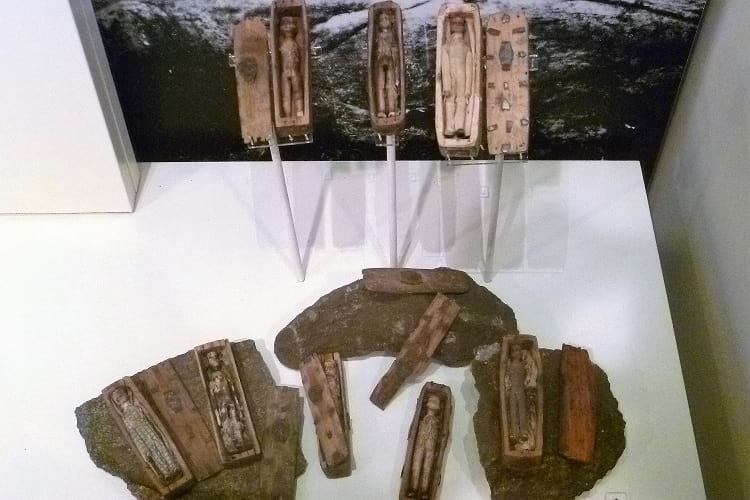
Edinburgh’s Miniature Coffins. (Kim Traynor / Wikimedia Commons)
The past was a mysteriously eerie place in so many ways, especially to look back on now from those fortunate enough to do so from the comfort of their own homes. Every day, items are found pertaining to these shadowy times and while the purpose of most can be explained they provide an intriguing reminder of times gone by and how our ancestors used to live. There are also those discoveries however with no indication of where it came from and why. They confuse even the most educated of archaeologists and historians. And therein lies the mystery.
This is a story from Edinburgh, Scotland, at the time known as Auld Reekie in Scots because of the smoke from coal fire and factory chimneys as well as the stench from a nearby Loch, were bodies among other things were dumped. On Arthur’s Seat –the biggest peak on a formation of hills around the Scottish capital – a set of miniature figures were discovered. Disturbingly, they were all included inside coffins. It is a mystery which has been ongoing for almost two centuries, deeply perplexing those to study it. Their purpose and origin are still completely unknown although as with every good mystery many theories have arose.

Arthur’s Seat in Edinburgh, Scotland. (David Monniaux / Wikimedia Commons)
Discovery of Edinburgh’s Miniature Coffins
In 1836 a group of boys were hunting rabbits on a famous hill to the east of Edinburgh. It is famous for hill-walking, climbing and in those days hunting. Yet the youngsters found a particularly more important prize, even if they did not know so themselves. They were on Arthur’s Seat, an elevated spot suspected to be named after the legendary King Arthur but the more likely etymology is from a strategic point for archers as opposed to Arthur. Inside a small cave-like opening and behind three slabs of slate were seventeen wooden models of figures inside coffins. They are expertly carved, effigies of humans, only four inches long at maximum, all dressed with different fabrics and painted black boots. It is found that the models were deposited at different times as some had already showed signs of ageing and decay. The top coffins were very new at the time of unearthing for example.
Several newspapers reported the story including the Scotsman naming this part of the article A Strange Discovery, published on July 16, 1836.
“…Lilliputian coffins… Evident that the depositions must have been made singly, and at considerable intervals—facts indicated by the rotten and decayed state of the first tier of coffins and their wooden mummies [… while] the coffin last placed, and its shrouded tenant, are as clean and fresh as if only a few days had elapsed since their entombment.”
This is important because it means there was not just one random drop or stash. Someone systematically looked out the spot at various intervals, even spanning years after the initial deposit in 1800, with the last in the 1830’s. These findings were presented by former president of the Royal Scottish Society of Arts – Allen Simpson among others.
What happened to them?
It is told that many were lost by the boys on the day of the finding. They were throwing them at each other in means of play-fighting oblivious to their age, fragility and importance. A jeweller called Robert Frazier fortunately managed to get his hands on the surviving figures, adding them to his private collection. After his retirement in 1845 he auctioned off what became known as the celebrated Lilliputian coffins found on Arthur’s Seat, 1836, and they reached four pounds (about 500 pounds now. In 1901 they passed to their final resting stop of the National Museum of Scotland – eight of which still remain today.
Possible theories
Theories have of course arisen with many of which attributing the figures to witchcraft as well as superstition. This is to do with the prevalent history of witches in those times and especially within Scotland. In terms of witches, Arthur’s Seat has historically been a site of witchcraft and other illicit practices. One such name for the ancient volcano is the Windy Gowl where more witches were burned and hanged there in the 16th Century than anywhere in Scotland. In terms of superstition, it is thought even that sailors created them as a charm to keep safe at sea. (Edinburgh sits on the banks of the North Sea) Another theory came from the Evening Post. They noted that an ancient customer from Saxony, Germany explained that it is an ancient tradition to bury a miniature coffin as a remembrance to a friend or family member who had died in a distant land.
Others surmise that the figures are to do with a duo of serial killers who murdered in Edinburgh – William Burke and William Hare. The main reason is that they killed seventeen victims, and only ten years before the cache was located. A popular trade in the 19th Century was that of cadavers. This was for medical students who usually only had a limited supply of recently executed convicts. Hare rented a boarding house and came up with the idea when one of his guests died whilst still owing some money. They used his body as collateral, turning to a life of crime and selling the corpse to a doctor called Robert Knox. After amassing a small fortune they were discovered and convicted. Hare actually testified against Burke who was hanged dissected and his skin made into a book cover. It is said that Burke would have had the intricate ability as he was a shoemaker.
This was later strengthened as a solution when in 2014 an anonymous box was delivered to the National History Museum. It was a replica of the models with a note stating ‘XVIII?’ which had quotes from a Robert Louis Stevenson story called The Body Snatchers (1884), a shot piece based on the Burke and Hare murders. It was addressed as a ‘gift’ to the museum ‘for caring for our nation’s treasures.’ However, this has also been doubted as a theory because the figures are all dressed in men’s clothes whereas the victims were mostly woman. Also, the eyes are open on the models.
The figures are not known the world over but they have become a small, mysterious symbol of Scotland’s capital which very much suits the style of the models. Famous crime writer Ian Rankin even wrote about them, giving them a mention in his Inspector Rebus novel The Falls. While we do not know their true origin perhaps as technology improves more will be revealed.
Enjoyed this article? Also, check out “Tana Toraja in Indonesia: The Celebratory Funeral Ceremonies and the Tree of Baby Graves“.
Fact Analysis:
STSTW Media strives to deliver accurate information through careful research. However, things can go wrong. If you find the above article inaccurate or biased, please let us know at [email protected].
RELATED
The post Edinburgh’s Miniature Coffins – The Mysterious Lilliputian Coffins, Discovered in Scotland appeared first on .
]]>The post Astana: An Ultra Modern Capital City Right in the Middle of Vast Empty Grasslands appeared first on .
]]>
Baiterek Tower, Astana, Kazakhstan. (Torekhan Sarmanov / Flickr)
Kazakhstan is literally translated as the ‘Land of the Wanderers’. This perfectly illustrates the nomadic history of a central Asian territory which has been inhabited by humans for over a million years, with modern Homo Sapiens starting to evolve around 40,000 years ago from today. In this time a great number of nomadic tribes such as the Scythians, Mongols and Persians have vied for power on the seemingly endless, golden steppes. Now, with the centralization of power, industrialization and the convenience of city life, these wandering ways of the past are being replaced by city-dwelling.
Many capitals of the world are based on links to bygone eras whereas the Kazakh capital is unique in the sense that it is not the most historical setting but rather the most strategic for modern expansionism. If successful perhaps this will become the new standard for choosing a principal city. Little is known around the world of the city called Astana – the capital for little over twenty years. But this is changing very quickly.
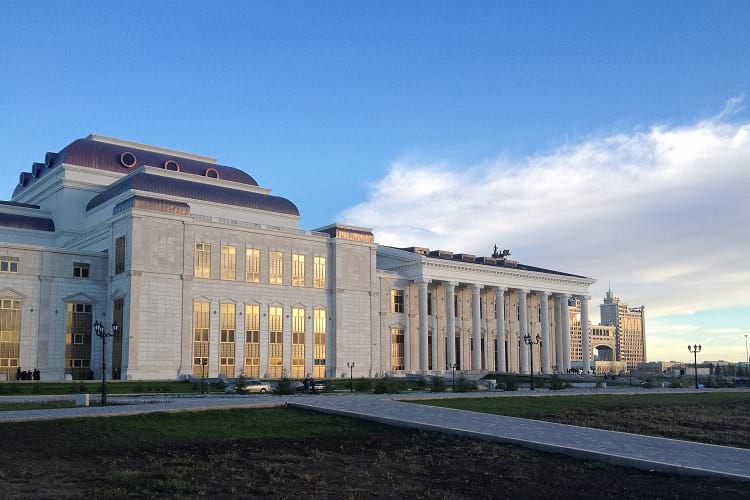
Opera house, Astana. (inga / Flickr)
Astana, Kazakhstan
Astana was announced to the world as the new Kazakh capital in 1998 and is now one of the most economically modern cities in not just Central Asia but on the planet. It is a planned city, very distinctive, in the case that it changed shape even after becoming capital, a feat spearheaded by Japanese architect Kisho Kurokawa. This began in 1998 when the Kazakh government organised a design competition, calling for urban planners from all corners of the globe to send their ideas of a new image for Kazakhstan. Kurokawa won with a truly inspirational and economical view of modernism as well as metabolism, along with integrating the old city.

Astana downtown. (Ben Dalton / Flickr)
History of Kazakhstan
Nomadism started to dwindle in 1830 and what is now called Astana started to take form when a Siberian branch of Cossacks – the legendary soldiers – built a defensive formation. This was when Kazakhstan, like many other central Asian nations, moved under the sphere of influence of Imperial Russia. Before this, it was initially a settlement of Akmoly (suspected to mean White Grave in Kazakh) a small agricultural town which later became Akmolinsk. During the Soviet era, Astana would have a further rise of standing, helped (or hindered depending on one’s viewpoint) due to its location, relatively close to the Russian border.
During the World Wars, many factories had to be abandoned in the west of Soviet Russia and were relocated to Kazakhstan for protection. Eventually, it would become Tselinograd to further illustrate the governance of Russia and progress of the Virgin Lands Campaign – a method of imperialising new lands for agriculture. This came from the Russian ruler of the time Nikita Khrushchev with Tselinograd implemented as the administrative seat of said operation. This is where many Soviet-style buildings were developed and imprinted themselves on the land – the famous Mnogo-Etazhkis (many-floors) high-rise residential blocks which still remain today. After the dissolution of the USSR, cities like Astana began to regain their Kazakh status. The president made an announced that the former Tselinograd would become the new capital – taking over from Almaty in the south – as early as 1994 in a move that would shock many.
A journalist, visiting in 2008 for UK publication Telegraph Travel, James Mackintosh, experienced that the former-Soviet satellite city retains several Russian qualities, or rather, ghosts of the past from another viewpoint. This includes a German diaspora whose ancestors were exiled to Central Asia during Stalin’s rule.

Palace of Peace and Reconciliation in Astana. (Ninaras / Wikipedia Commons)
A modern capital
Kazakhstan became independent from the USSR in 1991 and has retained the same president ever since. This is Nursultan Nazarbayev – the leader of the Kazakh Communist Party even before the split – a man who once received 97.7% of the vote. The nation has become richer and richer in recent years fueled by vast discoveries of oil and gas. Although a huge realm – the largest landlocked country in the world – its population is only around 16 million. So with money to burn, the government demanded that many extravagant features were to be created, to propel Kazakhstan into the world of tomorrow.It was deemed a strange move to make Astana the chief city because it lies in the middle of nowhere.Many favour the style and tradition of the old capital Almaty but a threat of earthquakes meant that Astana would be the site for new developments. Another factor is the large Russian community living there as well as being relatively closer to the Chinese superpower to the east. A more psychological reason is explained or perhaps alibied by a local architect. According to Serik Rustambekov, the intention of these projects matches the Kazakhpsyche.

Hazrat Sultan Mosque in Astana. It is also the largest mosque in Central Asia. (Alex J. Butler / Flickr)

The entrance of Hazrat Sultan Mosque. (Ninara / Flickr)

Interior of Hazrat Sultan Mosque. (U.S. Department of State / Flickr)
“You need to understand the Kazakh background to get a better picture of our worldview. We’re a nomadic civilization that developed over thousands of years in the vast expanse of Eurasia. Free space is more impressive to the Kazakh mindset than the type of congestion found in many European centers.”
A major symbol of the prosperity and pomp comes in the form of a shopping center. But it is no normal mall. Khan Shatyr claims to be the largest in the world at 127,000 square meters. An artificial beach with a constant temperature of 35 degrees is located within, on the top floor of a 150m high marquee. It requires a heat-absorbent material and must require a ridiculous amount of energy consumption, with exotic sand imported from the Maldives. This is just one example of many. Its main attractions all have the quality of state of the art design and architecture like the National Museum which houses the ‘Hall of Gold’ with artifacts from ancient history. Baiterek tower – an observation tower 97 meters high– mimics a Kazakh folktale about a mythical bird and tree. Again, they exemplify the mix of new and old cultures.

Khan Shatyr Entertainment Center. (Albert Bergonzo / Wikimedia Commons)

The indoor beach in Khan Shatyr Entertainment Center. (upyernoz / Flickr)
James Mackintosh talks again, regarding how he found the remarkable city on the cusp of change and gives an artistic view of everyday life.
An economic powerhouse
It is obvious to see the sheer amount of development thrust into Kazakhstan. The government knew that relying on oil was not an option for the future (over 60% of the economy in 2016 came from oil).
Sites like Bloomberg and Forbes show the multitude of investments and the effect it is having,
“Today, 9,000 foreign companies are reported to be operating in Kazakhstan… has invested $30 billion over the last 10 years in its transport and logistics infrastructure, according to government figures, and plans to spend an additional $8.4 billion to revive the ancient Silk Road route. The 2,700 km Kazakh portion of the new 7,000 km Western Europe— Western China Highway has been built, and expanding northern and southern rail routes have already dramatically increased shipping volume and capacity.”
Moreover, this is apparent in the socioeconomic aspect if such figures can be trusted.
“In terms of on the ground impacts, Kazakhstan’s poverty rate has fallen from 47% in 2001 to just 3% in 2013.”

Concert hall in Astana. (Ninaras / Wikimedia Commons)
The future
With these figures it is clear the Astana is moving in the right direction, although how long can it last. The transition from natural resources as the main economic driving force was certainly something that needed to be done but a venture into tourism seems an extremely ambitious proposal. Needless to say, the realm of Kazakhstan has an endless supply of natural beauty so if Astana can grow into a necessary hub for tourists then it could be a very viable system. Time will tell.
Enjoyed this article? Also, check out “Replica Constructions of World-Famous Cities and Towns in China: Tianducheng, Thames Town, and Hallstatt“.
Fact Analysis:
STSTW Media strives to deliver accurate information through careful research. However, things can go wrong. If you find the above article inaccurate or biased, please let us know at [email protected].
RELATED
The post Astana: An Ultra Modern Capital City Right in the Middle of Vast Empty Grasslands appeared first on .
]]>The post Thomas Midgley Jr. – The Scientist Who Almost Destroyed the Planet without Knowing appeared first on .
]]>
Dr. Thomas Midgley Jr. (Library of Congress)
When we think of people who have done great harm to the world we inevitably think of tyrannical dictators who led merciless regimes and gave the orders of mass genocide. But what about the inventors of the world, scientists who contributed to devastating developments that killed, kills, and will kill, for generations to come. In this sense – like dictators – they are ultimately killing from beyond the grave with the death tolls from other causes etc. pale in comparison.
Of course, this is excusable if the inventor did not know the evils their patents could cause but in some cases they did. Arguably, one such inventor is named Thomas Midgley Jr. While many consider him a great scientist, others believe he is one of the worst for the chaos his creations brought about. Midgley is most known for four main developments: Tetraethyl lead for automobile fuel improvements, the extraction of Bromine from water, adapting fluorine to refrigerators and advancements in rubber-making.
The early life of Thomas Midgley Jr.
Brought up in a nice part of the world called Beaver Falls, Pennsylvania, Thomas studied machinery under the tutelage of his father who was an inventor and – as common for the time – general handyman. Inventions ran in the family, not just with his father but his mother was the daughter of James Emerson who most famously invented the inserted-tooth saw.
It is claimed that Midgley’s ancestor was an important employee of James Watt also (the Scotsman who improved the steam engine). His talent as an inventor shone through early while playing one of his hobbies – baseball. Although only a teenager he implemented the balls to have more curve by using the slippery bark of an Elm tree. This practice became commonplace throughout association baseball in later years.
Modern gasoline
The prodigy would graduate in 1911 with a degree in mechanical engineering from the prestigious Cornell University. Inventions were not just part of his family but part of his state’s blueprint as he worked at the National Cash Register Company where Charles F. Kettering designed the first electric register. Kettering saw more than enough aptitude in Thomas Midgley Jr.– an unyielding determinism and confidence – to keep him on at the Dayton Engineering Laboratories Company. It would become a branch of an automobile company called General Motors.
Kettering’s confidence and the natural talent of Thomas Midgley Jr. soon came to the fore when he started working on a solution to stop engine-knocking. This is a sort of improper combustion when the engine sparks. Instead of the spark combusting, a pocket of combined air and fuel will ignite. It can damage the engine and produce nasty sounds. This can be combatted by high octane fuels for example and there was actually already a solution in place before Midgley – adding ethanol to gasoline. However, because this is natural, companies could not make money from it.
His research was postponed during World War I when his country called upon him to develop an aerial torpedo as well as airplane fuel. It took another six years to finalise his solution, systematically testing different elements and compounds. He found success with a substance Ethyl lead but it was not the only thing needed, with Bromine imperative to the solution, in terms of eliminating lead-oxide formed deposits. Bromide needed to be found in large amount and when they found extraction from seawater was possible, that was a game-changer. Ethylene Bromide became the compound causing the lead to expel through the exhaust. This leaded alternative – the type we all know today – had various benefits but also pitfalls. It became a standard in almost every gasoline in the world.
The dangers of gasoline
The discovery was not met with widespread satisfaction. Reports spread across the United States of problems with the mixture, including workers dying in various GM factories.
“Controversy erupted in October 1924, when workers in a Standard refinery in Bayway, New Jersey, went violently insane after making leaded gasoline. Seven men died and 33 were hospitalized there; meanwhile, ten more were killed at a DuPont facility, and at least two died and 40 were hospitalized in Dayton, Ohio…”
This was not a new notion but as is the case with human nature, occupational hazards are easily forgotten if it means making money and potentially advancing the human race. For even Midgley was no different. Despite coming down with lead poisoning – he argued that it would not cause damage to public health in small amounts.
“In addition to the private warnings, an official letter from the U.S. Public Health Service asked whether leaded gasoline might not be a “serious menace to public health.” Midgley responded that the problem “has been given very serious consideration . . . although no actual experimental data has been taken.”
Author and PhD Bill Kovarik speaks in great length about the dangers of lead.
“…Lead poisoning is one of the most frequently observed causes of occupational disease. From Roman antiquity through the industrial revolution, the cumulative effects of lead had become well known through painful experience. Roman engineer Vitruvius noted that lead fumes “rob the limbs of the virtues of the blood.”…. Bernardo Ramazzini, one of the first physicians to study occupational health, said around 1700 that: “The skin [of lead workers] is apt to bear the same color of the metal. . . . Demons and ghosts are often found to disturb the miners.”…. Charles Dickens wrote about the terrifying effects of lead poisoning on London workers who could find no other employment…”
More deaths followed in the 1920’s,
“Seven workers died between September 1923 and the fall of 1924 in GM’s Dayton, Ohio and DuPont’s southern New Jersey factories, but no one outside the Ethyl partnership understood the significance of these apparently disconnected industrial accidents… Then, as Standard Oil started up a new and even more hazardous TEL refining operation in northern New Jersey five workers died in one week from lead poisoning so severe that it was not initially recognized by occupational health experts…”
As most people know now but few knew then, Lead is extremely poisonous, especially for children. Less transparency, communication and media coverage back then can be the only explanation for more not being done to ban it. It is only relatively recently that leaded solutions have been banned worldwide.
Destroying the ozone layer
Dangerous chemical production didn’t stop there for the American. General Motors asked Thomas Midgley Jr. to create a coolant for refrigerators. One which was non-flammable, non-toxic and odor-free. Author Bill Bryson writes:
“Refrigerators in the 1920s were often appallingly risky because they used dangerous gases that sometimes leaked. One leak from a refrigerator at a hospital in Cleveland, Ohio, in 1929 killed more than a hundred people. Midley set out to create a gas that was stable, nonflammable, noncorrosive and safe to breathe.”
Midgley thought he was developing a beneficial solution but again it was more dangerous than the predecessor. He settled on a mix of Chlorine, Flourine and Methane – a type of Chlorofluorocarbon (CFC) – which is extremely harmful to the environment and cannot be broken down. For Freon is a CFC and when released, they are impossible to break down by any natural process. In the atmosphere, once cosmic rays hit these molecules they destroy the O-Zone layer. As the O-Zone contains the Oxygen we need to breath – this is a potentially life threatening practice to increase. Without it, UV light will react harmfully with our soil, killing the bacteria we need to survive.
Alas, it is probable that Midgley had no idea of this. Afterall, at an American Chemical Society meeting in 1930, he inhaled some of the gas, then blew out a candle flame to demonstrate its properties.
With his increasing success, Thomas Midgley Jr. became vice president of the Ethyl Gasoline Corp. in 1923 as well as the vice president of the Ethyl-Dow Chemical Company. He petitioned that both lead and bromine were safe enough to use, however, that he would strive to make safer solutions also He received many accolades for his work, including four medals from the American Chemical Society and being instilled into the National Academy of Sciences. Again, he gave service to his nation in World War II, honoured as the head of the National Defense Research Committee concentrating on rubber production, greatly developing vulcanization which hardens the material. Thomas Midgley Jr. also gave outstanding service to chemistry through the American Chemical Society, in which he was active as a member of the Board of Directors for twenty-five years.
Later life
The dangerous discoveries would eventually catch up with the inventor when in 1940 lead poisoning contributed to him being diagnosed with Polio. Losing his legs, the patient was forced to invent a pulley device to help him in and out of bed. Alas, it would eventually strangle him on one fateful eve.
Thomas Midgley Jr. was possibly too blinded by success, or by thinking he was helping the world too much to notice the devastation he was causing. There is a fine line between how much harm should be done to benefit mankind. How many lives are worth the sacrifice for something that will save many more?
In Midgley’s case however, it seems his inventions did more harm than good. One silver lining may be that he finally made the world realize how destructive those chemicals are. Just in time for us to make a difference.
Fact Analysis:
STSTW Media strives to deliver accurate information through careful research. However, things can go wrong. If you find the above article inaccurate or biased, please let us know at [email protected].
RELATED
The post Thomas Midgley Jr. – The Scientist Who Almost Destroyed the Planet without Knowing appeared first on .
]]>The post Sex in Space – Is It Possible? and Why It is Important appeared first on .
]]>
Astronaut Jan Davis and Mark Lee, the only married couple to have travelled together in outer space. (The U.S. National Archives)
Sex of course, needs no introduction. A fundamental building block of life and evolution as well as a popular past-time would be extreme understatements. It is inherent in the human genus and more and more everyday plays a large role in all aspects in the fabric of life – advertising, movies, and nightlife etc. For this reason, we assume that people are having sex everywhere: houses, hotels, colleges, beaches, farms, roller coasters, boats and hot-air balloons. One would expect in spaceships and stations also, but it turns out that it’s not so easy to have Outer Space intercourse.
According to NASA,
“Former and current astronauts don’t like to talk about space-shuttle sex, and NASA says that if it’s ever happened, the agency doesn’t know anything about it. (NASA has never conducted official experiments on animal reproduction in space, says a spokesman.)”
This was back in 2007 but explains the lack of practice or even consideration before that year. It is more and more becoming a necessary topic to discuss as plans to colonise other planets and space has entered the goals of the human race. NASA officially began preparatory missions in 2009 but presumably had feelers out way before then along with other organisations and personnel.
Many would agree, that NASA is simply reserved about making information like this public. For example scientific writer Pierre Kohler,
“The issue of sex in space is a serious one… The experiments carried out so far relate to missions planned for married couples on the future International Space Station, the successor to Mir. Scientists need to know how far sexual relations are possible without gravity.”
The problem with Sex in Space
The primary problem with intercourse in space arises from weightlessness and factors from Newton’s Third Law which means an easy process on Earth is much more difficult in space. For every reaction, there is an equal and opposite reaction but not when something is connected.
This is universal law so it remains the same anywhere in the universe. It means that if the couple remain attached they will not be able to exert force upon one another and unless there is another object to counter, their velocity cannot change. Along with this, anti-gravity prohibits any real movement, however slight. All our evolution has all taken place under Earth’s atmosphere and conditions, in space means a completely new environment for our bodies to process. Gravity has a hand in a number of our functions from the basic principles of cells and organs so we cannot just use a device which creates gravity. Beyond that, pregnancy and birth could cause problems in other environments so difficulty with conception initially may not be a bad thing – like a warning from nature. Scientists have already tried it with rats and while they were able to breed, the litter were unable to survive long.
Lack of gravity can cause a lot of problems if a person is expending too much energy, extreme perspiration and nausea can occur. Muscles and bones can become extremely brittle and risk injury with the slightest mishap or accident. Circulation changes also, a pulse rate which can swell your heart and slow down circulation.
Things we take for granted in 1G – our gravitational atmosphere. Human behaviour is greatly affected also, with astronauts reporting extreme changes in mood which could cause complications in highly charged emotional situations.
Attempts
There has been nothing official from NASA and their counterparts but here are some examples of individual parties looking to complete the task. Multimillionaire astronaut Dennis Tito owns a foundation who announced a two-person crew would flyby Mars and back to Earth. The Inspiration Mars Foundation was set for a 501 day trip but it has yet to be completed.
Porn site Pornhub even plans to make a pornographic film in space – which would be the first. A crowdfunding campaign which relies on donations is called Sexploration. Richard Branson’s Virgin Galactic was said to reject a $1 million offer to shoot a film, and while the company was not named it could possibly be the streaming website.

Testing 2suit in a reduced-gravity aircraft during a parabolic flight. (Steve Boxall / Wikimedia Commons)
Solutions
There have been creations to solve the problem including an invention called 2suit. A type of apparel designed by a famous astronaut and novelist Vanna Bonta which generated much publicity and discussion. A documentary described how a couple tested the suit in a zero-gravity airport yet even kissing proved a challenge and more time was reportedly needed.
The future
With more and more talk about colonising other planets, sex in space is an important topic as it is the fundamental operation needed to do so. And reaching hospitable, goldilocks planets could take generations which is why it is not just sex, but sex in the confines of a space-saving spacecraft that has to be negotiated. It is an exciting experiment for the future in terms of the logistics. That is without taking into consideration whether it is something mankind should or should not do.
From a science fiction standpoint, it is a subject which has been covered many times over. From many male perspectives, there is one scenario which could be appealing. Apollo 11 astronaut Michael Collins wrote a tongue-in-cheek possibility in his autobiography. Time magazine posted it,
“Imagine a spacecraft of the future, with a crew of a thousand ladies, off for Alpha Centauri, with 2,000 breasts bobbing beautifully and quivering delightfully in response to every weightless movement … and I am the commander of the craft, and it is Saturday morning and time for inspection, naturally.”
[It should be noted that author Arthur.C Clarke informed the editor of Time that he was first to write this in his novel Rendezvous with Rama (1983)]
The human race has achieved so much that sex in space will without a doubt become a mainstay, it is just a question of when.
Recommended Read:
An Astronaut’s Guide to Life on Earth | By Chris Hadfield
Fact Analysis:
STSTW Media strives to deliver accurate information through careful research. However, things can go wrong. If you find the above article inaccurate or biased, please let us know at [email protected].
RELATED
The post Sex in Space – Is It Possible? and Why It is Important appeared first on .
]]>The post Hakan Sukur – The Superstar Striker Exiled by Erdogan appeared first on .
]]>
Hakan Sukur. (Vulkahn / Wikimedia Commons)
In the world of football, no-one in Turkey could handle the man who became known as the ‘Bull of the Bosporus’, a powerful, fast and instinctive footballer who broke records in both the domestic and international game. His influence skyrocketed and before long he had negotiated big-money moves abroad and started rubbing necks with the Turkish elite. He attempted to wield his status in the political world but when the bullish frontman went against the dominant politician of his country a power-struggled ensued and a player who was once hailed the hero of his nation transformed into a disgraced figure. This is the story of Hakan Sukur– a player who realised that the move from sport to politics is not for the faint-hearted.
For the most part, professional footballers lead amazing lives: earning substantial amounts of money, travelling around the world and experiencing the high-class lifestyle of different countries – all from playing their favourite sport. This is even more so the case for those who are considered star players, as they are no longer footballers but heroes among their communities. In turn, they experience extraordinary lives but not always in a positive manner due to the intense pressure it carries. With the weight of the nation thrust upon their shoulders some find it hard to stand tall.
Early career
One such case was a child prodigy born in Adapazari, within the northern Maramas region of Turkey. However, he expresses that his roots are Albanian, with his mother and father both emigrating from the former Yugoslavia. In a country extremely impassioned with football but left wanting on the world stage his rise was met with enhanced reverence. At 21 years old he joined one of the biggest teams in Turkey and well-known worldwide – Istanbul based Galatasaray SK – immediately becoming a fan’s favourite for his strike rate. He was gifted the name ‘Kral’ denoting King as he broke the scoring records of both Galatasaray and the Turkish national team. His other moniker being ‘Bull of the Bosporus’, illustrated his playing style. Turkey and Hakan went to the 2002 World Cup in Japan & South Korea as underdogs but with more than a hint of optimism. They finished 3rd which was branded a massive success. Despite Hakan Sukur being a periphery figure he was able to score the fastest goal in world cup history – after 10.8 seconds – in the third place playoff. It is a stat which illustrated his turbulent career; leaving his mark in the history books and further endearing himself to the Turks.
Life abroad
The reason the previous stat is illustrative of the Turk’s career is that he could only ever dominate on Turkish soil. Every time he went abroad he struggled immensely but always found a way to remain in the hearts of the Gala and Turkish faithful. The problems started in this aspect for Hakan Sukur when big money moves came calling for the marksman and with it only natural to want to play in one of the best leagues in the world (the Italian Seria A) his head was turned. Although many say that the powers that be – the football federation and politicians – forced him to leave to promote Turkish football. He ventured to Torino FC in a move that seemed to fit. (Even their nickname is Il Toro – The Bull). Alas, as the story goes, he became homesick in Turin and so everything he craved from Turkey was accommodated to cure this – even, a wife.
His wedding day

Tansu Çiller. (Ministry of the Presidency / Government of Spain)
This dalliance is severely clouded in terms of the actual facts but it is said when Hakan used to annually summer holiday with his family he met a girl called Esra Elbirlik. In Turin, Hakan stated he missed spending time with her and offered his hand in marriage which was rejected by the girl’s parents as she was only 19 years old and still at university. They would not refuse a second time. This is where a strange aspect of Hakan’s life began to reveal. His talent in the game brought him very close with a powerful individual, the then prime minister of Turkey, Tansu Çiller. She helped Hakan’s cause and persuaded the family to accept, all in order to keep her golden child and ambassador of the country – Sukur – content abroad. Another of the footballer’s new friends was named Recep Erdoğan, the now President of Turkey. Below is a picture of the wedding in which Erdoğan – who at the time was Mayor of Istanbul – and his right hand man, an influential Imam (similar to a cleric) Fethullah Gülen sit. The three powerful people supposedly made sure the wedding went ahead.

Recep Tayyip Erdoğan. (US Department of State)
Their now celebrity wedding was televised in a splendorous ceremony, performed by Erdoğan and Gülen, the latter who would act as Sukur’s best man. Yet, back in Italy, the strained relationship lasted only four months and Esra returned home. She was branded a thief by Sukur who accused her of stealing his jewellery. The last we heard of the girl was in 1999. She died in the Izmit Earthquake which took the lives of 17,000 people in and around Istanbul, aged only 24. Her parent’s lives were also claimed.
Later career
After only 1 goal, Hakan Sukur returned to Turkey within the year. Who knows what must have been going through his head but this failure abroad would be a common trend. After dominating again in the Turkish Süper Lig he was again tempted by another Italian Club – Milanese giants Inter Milan. Again, he would flop, struggling to oust rival strikers Christian Vieri and the Brazilian Ronaldo. He would try England as his last foray to foreign lands being signed by former Galatasaray manager Graeme Souness but scored just two times following a leg break. Every time he came back to Istanbul he continued where he left off scoring for fun, eventually winning 14 titles with Gala including their maiden European success – the 1999 UEFA Cup. With the Turkish national team, he retired with 51 goals in 112 games.
Life in politics

Fethullah Gülen. (VOA / Wikimedia Commons)
After his retirement he turned to politics, working for the AK Party (Justice and Development Party) – the one which Erdoğan still represents. To understand what happened we must understand the conflict between Erdoğan and Gülen – which is far from easy. At the time of Sukur’s employment, the Cleric Gülen was also a member of the AK Party, with hopes of turning Turkey back into a more Islamist state. Erdoğan and Gülen had a close and potent partnership. While the former worked his way up the political ladder, Gülen had amassed a wealth of power after privatisation, notably with many media companies. A schism came to a head in 2016 when a coup d’état was staged. Among it came a corruption scandal in which the AK Party themselves were accused of corruption – the President’s family also. Gülen – who was and remains based in the US – was deemed the figure behind it – a terrorist organisation called FETO. He was accused of trying to oust out his former ally Erdoğan. Gülen fervently denies this but many of his followers were arrested and his thought-schools shut down across the country. Hakan Sukur did not agree with this accusation and when asked to renounce Gülen, he refused. He was also quoted as calling himself Albanian and not Turkish which lost him support in an increasingly nationalist movement. He resigned from the AKP to start work as an independent MP.
Where is Hakan Sukur now?
Because of his actions, a warrant was put out for Hakan Sukur’s arrest. He escaped but his father Selmet did not get so lucky and was imprisoned. There are reports he has since died inside. Sukur was able to emigrate to the USA and has bizarrely opened a bakery in Palo Alto, California. Judging by the pictures of his lifestyle he has been more than able to retain some of his assets, staying in a 3 million dollar home with his current wife and 3 kids. There are also plans to make his bakery into a chain. It is fortunate for him, as a return to Turkey is simply not possible in this climate.
Final Note
There are many stories of people falling from grace in the history of the world. Sometimes it is deserved and sometimes not. This story certainly ranks high in terms of a fallen star but it is impossible to comment on whether it is justified. In a political sense, no person should be punished for their views the way Hakan was. In a human sense his relationship with Esra looks to be extremely badly-judged but only they will know the truth of what transpired. If we go by the many mantras of forgiveness, with a new family and new business to oversee we can only hope Hakan Sukur finds solace in the rest of his life, helped with a wonderful career to look back on.
Writer’s Note
The relationship between Hakan and Esra is extremely clouded with not many sources. Perhaps there are some Turkish readers who can tell us more, please let us know in the comments if so. Also, regarding Erdogan and the Gulen movement, it is a very delicate and complicated situation so we apologise if we have anything incorrect or biased.
Enjoyed this article? Also, check out “The Deadly Premonition of Sugar Ray Robinson that came True, 1947“.
Fact Analysis:
STSTW Media strives to deliver accurate information through careful research. However, things can go wrong. If you find the above article inaccurate or biased, please let us know at [email protected].
RELATED
The post Hakan Sukur – The Superstar Striker Exiled by Erdogan appeared first on .
]]>The post 1999: Jeanne Menjoulet’s Journey to the Dunes of Dasht-e Kavir appeared first on .
]]>
Dasht-e Kavir. (Jeanne Menjoulet / Flickr)
Landscape has changed considerably since modern humans (Homo Sapiens) first entered the world in what scientists believe was around 300,000 years ago. For instance, the Sahara desert became habitable (not just along the Nile Valley) most recently c.10,500 years ago when a burst of monsoons created a wealth of water.
Archaeological evidence in a now submerged area called Jebel Sahaba goes some way to illustrate this. Climate has also changed drastically in the Middle East, an area which these days is dominated by dry, arid regions.
In the past much of it was part of the Fertile Crescent AKA one of the infamous cradles of civilization. There have supposedly been many wet periods since then allowing civilization to flourish and pass through it onto new horizons. Many believe it was conditions like this which allowed early humans to first leave the continent of Africa around 60,000 years ago.
Dasht-e Kavir or Salty Plains
A testimony to these changing times lies 200 miles east of the capital city of Tehran, Iran. A great desert with a surface area of roughly 30,000 square miles, almost 2/3 the size of France. Its name is Dasht-e Kavir, part of a protected zone called the Kavir National Park. It is one of two vast deserts in this area, the other being Dasht-e Lut to the south.
The name ‘Dasht-e Kavir’ means ‘Low or Salty Plains’ in Classical Persian to illustrate how long it has dominated the landscape. It also highlights that there are many great salt lakes in Dasht-e Kavir, simply put, lakes which have a higher concentration of salt and dissolved minerals. The two largest are known as Kavir Buzurg and Namak Lake.
These salt-rich lakes have been created via rising temperatures meaning layers of salt remained, as much as 6-7 kilometers thick and 40 meters high. The salt has been there for millions of years and despite being covered at times by mixtures such as mud, the low-density of the salt means it will rise over most terrain. Much of the desert contains salt plates in a seemingly mad-made pattern but it is totally natural.

Salt lake in Dasht-e Kavir. (Jeanne Menjoulet / Flickr)
Wildlife and biodiversity
Wildlife and humans survive in the various terrains of the desert. Some plants at the high points and migratory birds searching for sustenance. Animals such as gazelle roam the earth as well as sheep, camels and goats. Becoming more and more endangered are beautiful creatures such as the Persian Leopard and Asiatic Cheetah.
In the night, wild cats, wolves, lizards and snakes favor the cooler temperatures. Few villages remain but those which do take their main sources of living from camel and sheep breeding. Settlements have to be located near springs and oases, water wells having been created underground for thousands of years are a necessity of life.
There is evidence from another archaeological site called Tepe Sialk which has inscriptions detailing a Queen’s journey on the lake, sailing to visit the ruler of a town within. It has evidence of inhabitation as far back as the 6th Century BCE, showing remains of mud huts, flint tools and skeletons. Ruins of a Ziggurat have been uncovered as well. The area is now almost completely uninhabited however, apart from a few isolated communities.
Rigg-e Jenn
Legends tell of a historic section in the center known as the Devil Dunes – Rigg-e Jenn – which are said to be haunted. (Jenn being an evil spirit in Iranian culture.) This stems from the fact that many people have gone missing there due to its size and unpredictability– areas of sinkholes and quicksand included. Villagers speak of the wind howling eerily through the night.
Iran in 1999: Photographer shares her experience
While the big cities and towns have of course been modernized, the villages within the desert are the complete opposite. Both are extremely difficult places to have a concept of through pictures only and for that reason, at STSTW Media we got in contact with an adventurer and photographer called Jeanne Menjoulet who travelled to Iran in 1999.
Jeanne states about photography,“We can’t stop this elusive thing, time. I think that’s why I like photographs. Because it captures and freezes pictures of this fleeting time.”
We were so captivated by her documenting of Dasht-e Kavir as well as other places in Iran that we asked for an interview which she thankfully agreed to. We will share her pictures of modern cities such as the capital Tehran as well as the desert communities. Here are the questions we posed to her and more of her pictures.
STSTW Media: Tell us about yourself and about your passion for photography
Jeanne: “I am an amateur photographer. As for my professional activity, it deals with images too (I make videos about research into social history), But I prefer to devote my hobbies to capturing still images. The photographs fascinate me by their ability to make a moment everlasting. They also make it possible to observe life differently and to return to it … especially 20 years later.”

Near Isfahan. (Jeanne Menjoulet / Flickr)
STSTW Media: Tell us about your experience (i.e the culture and hospitality of the region)
Jeanne: “I visited quite a lot of countries in different parts of the world (Europe, Africa, Asia, North and central America…), but I must say that Iran (in 1999) is the country where I felt people were the most welcoming. I mean, many of the people in Iran were curious and interested in an exchange with Westerners (we were repeatedly invited to tea in very different places, by people we didn’t know, we just met in the street) and I also felt this interest and hospitality in the discussions with the Iranians who spoke French. They were both curious about our culture and proud to show the Iranian culture and way of life. Unlike some foreign countries, this welcoming attitude was not motivated by money.”

Tea and cucumbers invitation, Iranian aperitif. (Jeanne Menjoulet / Flickr)
STSTW Media: Did you fear going to Iran in 1999? Would you fear going there now? (In regards to Islamophobia in Europe)
Jeanne: “I didn’t fear going to Iran in1999 (although I had a small aspect of adventure, before the departure) I wouldn’t fear at all going there now. Many people in France (well, all the people I know) are quite impervious to Islamophobic speech. For many of us – I think – it is the war in Syria that is dreadful for people, and Iran is associated with this war.”

Isfahan at night – tea-house and hookah. (Jeanne Menjoulet / Flickr)
STSTW Media: How was communication? Did many people speak French or English?
Jeanne: “The communication with Iranian people was easier of course with people who spoke French or English. In the big cities I visited (Isfahan, Tehran…), many people spoke a bit of English at least. But the communication was also possible without language (with smiles, signs…). Even if it is always better to speak. But I remember a moment in an Iranian house (in a small village in the desert) which was very nice even we couldn’t understand our host and his family. I remember also two young women offering me a rose in a street of Isfahan, we couldn’t understand each other, but their smile was so friendly, I regret not having my camera in hand at that moment, for a “souvenir photo!” Generally, I took a lot of pictures of people in the streets or shops. And they smiled at me (perhaps because I smiled at them too), even If we couldn’t understand each other.”

Curious children. (Jeanne Menjoulet / Flickr)
STSTW Media: Did you keep in touch with any Iranians you met?
Jeanne: “I didn’t keep in touch with Iranian people I met; I went there just before the spreading of the World Wide Web… One or two years later, I think I might have kept in touch by emails for instance, it is much easier than postal letters.”
STSTW Media: Which is your favourite photograph and why?
Jeanne: “It was in a small town (I can’t remember which one) near Isfahan. It was very funny, we took the cameras out of our bags exactly at the same time, and took the picture of each other at the same time. This reverses the country’s tourist/inhabitant relationship. Interesting!”

Iranian girl taking a picture of a foreign traveller. (Jeanne Menjoulet / Flickr)
STSTW Media: What is your most memorable moment from the trip?
Jeanne: “My most memorable moment from the trip was visiting Machad during Muharram [First and holiest month of the Islamic Calendar] celebrations. It was incredible to see all the people in the streets, all in black. The processions were quite impressive, but there was a nice mood all around, a festive atmosphere, with smiles, once again”

Machad during Muharram. (Jeanne Menjoulet / Flickr)

Women in processions during Muharram. (Jeanne Menjoulet / Flickr)
Some of Jeanne’s photography outside of the cities, and into the desert of Dasht-e Kavir.

Villagers in the desert. (Jeanne Menjoulet / Flickr)

Women near a fountain. (Jeanne Menjoulet / Flickr)

Children near old houses. (Jeanne Menjoulet / Flickr)

Dyehouse near the village. (Jeanne Menjoulet / Flickr)
Thanks to Jeanne!
The troubles in many parts of the Middle East are well-documented and there is no doubt that climate change has contributed to that. The communities that remain in regions like Dasht-e Kavir are an inspirational testament to human nature. As photographer Jeanne Menjoulet says herself,
“An amazing insight into a world that has been completely transformed yet where life goes on. And a possible premonition into the future of many other regions.”
Our lands won’t stay green forever.
More Photos: Iran in 1999 by Jeanne Menjoulet
Optional Visit:
Dasht-e Kavir | Desert in Iran
Fact Analysis:
STSTW Media strives to deliver accurate information through careful research. However, things can go wrong. If you find the above article inaccurate or biased, please let us know at [email protected].
RELATED
The post 1999: Jeanne Menjoulet’s Journey to the Dunes of Dasht-e Kavir appeared first on .
]]>The post Enriqueta Martí: The Vampiress of El Raval appeared first on .
]]>
Enriqueta Marti. (Wikimedia Commons)
Serial Killing is an absolutely horrifying subject. To the point that horrifying is too meek a word to describe it, although other synonyms have the same effect. Needless to say, the following article has some adult material. It is an important subject none-the-less, important in the hope that understanding it may lead to abolishing it. Alas, as long as humans survive then there will surely be more. It is important and also thought-provoking because the more we read, the more correlations we discover.
Take the fact that three out of the four most prolific serial killers ever recorded were born in Colombia. Their murders ranging from 90-300. Does this say something about the socioeconomic demographics of the country? It would appear to be a massive co-incidence if not. And then take a seemingly safe country like Spain who does not have a large history of serial killers, with the most prolific convicted of sixteen. *Would the obvious historical factors come into play here or is it something far beneath the surface?
Let us take a look at one of Spain’s serial killers – the Vampiress of El Raval – to see if that helps us discover more…
There is a metropolitan area in Barcelona called El Raval which even today has an enchanting yet eerie quality about its narrow, odorful streets. Raval is famous for its never-ending nightlife which unfortunately brings about illegal prostitution as well as crime. It now houses around 50,000 people and retains a bohemian yet illicit reputation – I know because I used to live there.
Transport back one hundred years ago and these notions of eeriness and enchanting would heighten considerably. As would the element of fear which no doubt increased considerably during 1912 when a wave of Catalan children went missing. This was amid rumors of a vampire escalating through the port-side barrio.
By the early 1900’s the population of Barcelona was skyrocketing. Raval, also known as El Chino (Chinatown) became home to many immigrants as well as war veterans and deserters, seeking solace from the Spanish-American War – fought on Moroccan soil. There was a week of protests in 1909 known as the Tragic Week in which there were strikes leading to riots then eventual occupation by the National army.
Barcelona was becoming a famous port town known to many as the ‘Pearl of the Mediterranean’ meaning hotels and brothels were flourishing. El Raval became the Red Light district where prostitution was rife. Often, prostitutes were transported and sold in other developing cities such as New York and Rio de Janeiro. The streets were full of orphans and thieves, many children were sold by their parents due to economic struggles, ending up in sweatshops.
This way of life created a desperate situation in Ravalito. People would have been terrified for themselves and for their families. Fresh on the minds of the populace was Spain’s first documented serial killer- Manuel Blanco Romasanta – who killed twelve people north of the Portuguese border. He claimed to be a werewolf to which Queen Isabella II allowed him to be examined. Soon after was Juan Diaz de Garayo. He strangled five women and one girl in the northern Basque region of Spain. His nickname was Sacamantecas and he became a boogeyman figure along with ‘Hombre del Saco’ who had the myth of eating children.
Needless to say, the mindset was different back then in terms of belief of the supernatural. Other stories such as Jack the Ripper from across the sea in England would also be widely publicized. From 1982 onwards a larger number of children went missing in Barcelona. Many of which to the aforementioned brothels. The police raided one in Carrer Minerva in 1909 and this is where Enriqueta Martí i Ripollés would first become known to the authorities of Barcelona. She got arrested but was released with a lack of evidence. Some said her connections with the elite of Barcelona got her off the hook. Children continued to go missing.
History of Enriqueta Martí
Martí did not have a strange upbringing or childhood, reports would suggest. Born in Sant Feliu de Llobregat, on the outskirts of Barcelona in 1868 she moved to the city in her 20’s to become a maid and nanny but turned to prostitution thereafter. In 1895 she began a failed marriage with painter Juan Pujaló who stated that she had a strange character as well as affairs with other men.
Her most lucrative work consisted of working as a procurer for the rich and famous of Barcelona. She was prepared to get them anything and this disregard for humanity gave her a unique position. It highlighted her to people with perverted desires and such desires drive a hard price. Martí was prepared to do anything including kidnapping children to sell to such people. She gained access to the high life and was able to operate in famous places like the El Liceu theatre and the now abandoned casino on the hills of Barcelona called the Casino de la Arrabassada. There were rumors that she was a practicing witch doctor also, using the remains of her captives to make potions and elixirs.
Martí did her work very stealthily and it was not until 1912 when she was caught out. A feeling in the community that the police were not doing enough to find the captured children meant there was a public effort to find a girl called Teresita Guitart Congost. She was part of a popular local family and had been missing for two weeks. A neighbor of Enriqueta Martí called Claudia Elias believed her to be involved with many suspicious activities so had been watching her movements. One day Elias saw a girl peering out the window of Martí’s apartment but she had never seen kids in there before. Martí denied the claims when asked by Elias which arose even more suspicion. It was reported to the police who then launched an investigation and found the accused at a local park. They took her willingly to the flat and there indeed was Teresita Congost as well as another girl called Angelita. This is where the crimes of Enriqueta started to come to the fore.
The Rescue of Teresita Guitart Congost
Let it be known that the following testimonies come from the police and because of the times were not recorded. For that reason, the claims cannot be verified and some have even disputed them. Martí said she found the young girl Teresita lost and hungry so decided to care for her. However, Teresita told the police that Martí cut her hair after forcing her to the flat, telling her that her new name was Felicidad and that her parents were gone.
Martí claimed the other girl Angelita was hers but her ex-husband Juan Pujaló would later disclaim this. The girls told the police that their captor would only feed them potatoes and bread. She would pinch them if they misbehaved such as going to the windows, balconies or other rooms. Those other rooms told a story even darker than kidnapping. The girls were first to explore them in their bored isolation beforehand and so guided the police inside. There they found bloody clothes and a myriad of evidence to incarcerate the supposed vampiress. Thirty small bones, many of which exposed to fire was one such proof. There were many jars with strange remains, blood, bones and hair. There were clothes covered in blood, knives and bones. Angelita also spoke of a young boy called Pepito who she witnessed being killed by a knife on the kitchen table by Martí.
Enriqueta Martí had been apprehended by the law several times before but her association with her elite clients allowed her to escape unpunished. This time alas she would be sent to the infamous Reina Amalia prison. During which she tried to commit suicide by cutting her wrists but was stopped by the guards. More of her secrets were unraveled within the jail.
She gave locations of her previous abodes bringing about more evidence: Carrer dels Tallers, Carrer Picalques and Jocs Florals –all of which she rented with fake names. They were all composed of false walls with condemning features behind: Human remains, bones, books with recipes and potions in beautiful calligraphy, coded letters and a list of famous names. People believed it to be a list of her clients who would buy children or potions. However, the authorities did not act on this for fear of crowd retribution. They said instead, it was people that Martí tried to swindle.

Photo of the two rescued children Teresita Guitart and Angelita with Enriqueta Martí in the background. (Antoni Esplugas / Mundo Gráfico)
The prisoner began to tell the truth probably knowing she had no reprieve. She first claimed she studied anatomy but then indeed confessed to use the remains of children to make potions for the elite. Tuberculosis was a big killer and many believed that drinking young blood could cure it. She told police where to find everything she had. She did not name any of her clients however and never admitted to killing anyone. More witnesses came forward once Martí was ousted. A woman from the region of Aragon said Martí kidnapped her son six years ago after befriending her in Barcelona. The woman never saw her son again.
Death and aftermath
After 15 months in jail, it was proven that the Vampiress was far from immortal as her life was ended prematurely. She was killed in the prison grounds on May 12 1913, at the beating of her cellmates. This meant all of her secrets could not be revealed. Her body was buried in the Cemetery del Sudoeste on the mountain of Montjuic albeit secretly marked.
There are many works of people which dispute the claims of the police. For example, Elsa Plaza’s El Cielo Bajo Los Pies (The Sky Underfoot) is one such work with argues the Vampire’s innocence, or at least that she was not responsible for the murders. Many who have scrutinized the story closer believed that the police used Enriqueta Martí as a scapegoat for all the crimes sweeping through El Raval which they could not solve. Recent research has demonstrated that the only thing that can be proved about Martí is her kidnapping of the young girl, Teresita Guitart.
Plaza states Martí was never formally charged nor were any actual corpses found in her flats. She argues the blood on the clothes could have been Martís as she was suffering from uterine cancer and that the bones were most likely animals. Police closed many brothels around this time including one in Carrer Botella which used children.
Martí confessed to prostituting a girl of seventeen years on Carrer Sabadell as well as performing abortions but claimed to never have killed anyone. Plaza goes as far to say the trial was staged to wrap up the murders. Some have this view that so many children were sold by families needing money, that it was not a serial killer but economic hardship behind the missing children. More recent works points to Martí being a scapegoat, a strange character immersed in the dark arts but not a killer.
“She is a female killer, which is very unusual because 99 percent of serial killers are men.”
–Says Marc Pastor, a CSI agent who worked to imprison a serial killer called Remedios Sanchez in 2006
It is extremely doubtful that Enriqueta Martí will ever be concluded as a serial killer. She was however, without a doubt involved in the horrific events involving the many young kids of El Raval.
Enjoyed this article? Also, check out “H. H. Holmes: Life of America’s First Known Deadliest Serial Killer“.
Fact Analysis:
STSTW Media strives to deliver accurate information through careful research. However, things can go wrong. If you find the above article inaccurate or biased, please let us know at [email protected]
RELATED
The post Enriqueta Martí: The Vampiress of El Raval appeared first on .
]]>The post The Five Punishments for Chinese Slaves appeared first on .
]]>
Five Punishments: A Chinese man with hands tied and forced to kneel in public. Circa 1900. (Hawley C. White / Library of Congress)
The journey of mankind has been filled with joy, discovery and wonder. Unfortunately, it has done so alongside pain, evil and shame. To begin the Chinese theme, this connection of opposing sides is symbolic to the famous Chinese philosophy of Yin and Yang, illustrating that conflicting factors are complementary, even dependant on one another. Perhaps the same can be said for crime and punishment, that they are a necessary entity of everyday life.
In much of the world today, forms of torture are frowned upon and even for criminals, alternative forms are encouraged in most countries. It is an attitude that feels right; to save a population from desensitising and returning to a barbaric system of justice. It also inhibits the famous eye for an eye principle which uses a take from me and I take from you legal philosophy.
Anything from money, land or ultimately, an eye. This idiom was first mentioned in the Book of Hammurabi from ancient Mesopotamia – a functioning civilisation which harboured torturous punishments also. Much of the world has changed so much since that time making it hard to imagine that torture was once a mainstay. Commonly practised and an accepted form of punishment in every corner of the world, even within governments. One such place was and is the great land of China.
Punishments for slaves in Old China
This is best proved by the fact that the death sentence is still passed in China today, illustrating that corporal punishment is not designated to the past, and perhaps has a place in the future. There are also the numerous reports that torture techniques are still in practice, for example in secret prisons. China is one of the cradles of civilisation, as one of the oldest continuous cultures in the world.
The first written history comes from a period known as Dynastic China when the Xia Dynasty ruled from 2070 BCE. It is in the centuries before this period when a series of horrifying penalties known as The Five Punishments were written to keep slaves under control and maintain social order. Slavery was a massive cog in the Chinese economic system during this time.
People were born, sold or captured into slavery and their main duties – within a tough life – would be farming. Some slaves would also work with the dynastic families themselves. Around the centuries before the inception of the Xia, these punishments were created although their exact origins are unknown. They seem to have originated from an indigenous people known as the Hmong (Miao) however, a group from the south of China.
The reason for this is that a famed warrior known as Chiyou is heavily involved. His specific clan was unknown but many link it to the Hmong or their allies. For instance, the Sanmiao or the Nine Li. He is regarded as a mythical king and a great warrior. The Xia dynasty adopted these punishments and made them known to their people. They were for men only as women had their own separate punishments which will be listed later.
Five Punishments in Dynastic China
- Face tattooed with permanent ink.
- Nose cut off without anaesthetic
- Removal of foot/feet or kneecap without anaesthetic
- Removal of reproductive organs without anaesthetic
- Death in various forms (including quartering (cutting the body into four pieces), decapitation, drawn out by chariots, strangulation/asphyxiation, slicing by thousands of small cuts.)
In 221 BCE, a ruler called Qin Shi Huang brought about a time known as the Imperial Era. He conquered the dynastic states and made himself Emperor of the collective land known as Qin, later to be called China. During this imperial era his reforms made the punishments less barbaric but none the less still torturous. The improvement of standards is attributed to the teachings of famous philosopher Confucius and his views on human life. The Imperial penalties were as follows,
- Bamboo lashes to the buttocks (the number of lashes depended on the nature of the crime)
- Stick lashes to the back, buttocks or legs
- Penal service (ranging from 1-3 years)
- Exile – (this would be to a remote location such as the island of Hainan to the south, the distance depended on the crime)
- Death (strangulation, slicing or decapitation)

A lawbreaker being whipped while two men restraint him. (Ralph Repo / Flickr)
It must be said that slaves could also pay their way out of these brutal punishments but the prices were extortionate meaning that very few could do so.
For females the punishments were different. There are no concrete reasons why at this point it is simply thought that because China was a patriarchal society in which woman were not held responsible for their crimes. And that they could not suffer as much as male serfs. As follows,
- Forced to grind grain
- Fingers squeezed between sticks
- Beaten with wooden sticks
- Forced suicide
- Solitary confinement (time dependant on crime) or Sequestration (losing assets).
As mentioned, although torture was inherently part of life in all corners of the world, in Chinese culture it seems incredibly more brutal, especially to be so intertwined with government and society, somewhat uniquely. Perhaps the extreme scale of the land and the amount of warring factions gave a higher rise for the need to control. China is such a different world – as are many – for outsiders to comprehend.
There are many works which try to associate the mindset, for example to why their laws arose and why many still continue. Skipping over the nature which brought about torture in the first place (as that would require a tome to even attempt to fathom why) we will look instead at the change from Dynastic to Imperial. When punishments looked to improve after people started becoming enlightened.
This possibly began when the teacher and philosopher Confucius resided and taught. Born in 551 BC his teachings spread more after his life ended and influenced many of his countrymen. The work Crime and Punishment in Ancient China and its Relevance Today explains more,
“Confucianism was designed to maintain civility in the absence of central authority by persuading leaders to create a harmonious society based on the limited use of raw power and punishment.”
Helping Confucianism was the cosmological tradition which was established after his death, around 330 BC during the Warring States Era. This was where many dynasties vied with each other to create an Empire. Like the five punishments, this tradition is based on the five major planets and the elements they represent: Venus (metal), Jupiter (wood), Mercury (water), Mars (fire) and Saturn (Earth). The people used this to monitor agriculture, climate, politics and warfare. In 170 BC a document was found relating these five entities to each other. It is called the Five Star Oracle. Confucianism, as well as the cosmological tradition helped people in this aspect by introducing more moralistic behaviour and by trying to attain a balance among nature. Punishments were not just required for social order but to balance complex natural phenomena. Deborah Cao explains more,
“The cosmologists believed that without an appropriate effort to remedy the social harm caused by a crime, the disturbance of the human order would affect the larger cosmic order of things. Through negative natural phenomena, such as… floods, disturbances of the cosmos would in terms have a negative impact on the human world.”
Although this period certainly lessened torture techniques, the death penalty continued was implemented and advocated by Shang Yang (390 BCE). He founded Chinese Legalism which promoted a strict system. Crime and Punishment in Ancient China and its Relevance Today again explains more.
“The Legalist tradition restored harsh punishment as a way to impose order upon a fragmented society in which local despots had been carrying out arbitrary judgments. But Legalism carried the seeds of its own destruction and required Confucianism to balance it in creating a durable system of governance and justice.”
It looks as though each system – Confucianism and Legalism – worked alongside each other, again like an interconnected Yin and Yang. This was perhaps one of the first documented times that legality and severe punishment went hand-in-hand with socialism. With it, more thought was put into social problems.
Cangue Punishment
Punishment of course continued in other forms. Here is an example of a torture used even until the 20th century, a technique called a Cangue board used in many parts of Asia. It was implemented in other parts of the world also such as England where it was known as a Pillory. The Pillory device, however, would be fixed to the ground while the Cangue could be moved by the recipient if needed. It obviously restricted movements even to the point where people could not feed themselves, resulting in starvation in many cases unless they had friends and family to help them, otherwise strangers. The prisoner would be in the Cangue for as long as the punishment merited, it was mostly the sentence for thieves.

A man being punished by cangue. (John Thomson / Wellcome Images)
These methods continued until China became a Republic in 1912. Then it became westernised and more socialism brought about changes in punishment techniques, making them less brutal. Although as shown with the death penalty, the older traditions remain in China, whereas in other countries the death penalty has been outlawed completely. China, according to Amnesty International accounts for the majority of capital punishments on Earth.
Like many countries, China developed a culture of punishment and torture. However, unlink many countries such as in Western Europe they have kept aspects of it such as the death penalty. There are also many reports regarding punishments similar to the Five going on in secret prisons known as ‘Black Prisons’. The famous bamboo shoot and water torture are a few of the methods practiced.
European installations like the Council of Europe make banning capital punishment a mainstay if a country wishes to join. This is to do with the miscarriage of justice which can occur. More is explained in a deep study by the Economist. It is not just a sentimental gesture, however. Another reason is for keeping political contests fair, as many reports of killing political opponents this way have been reported none more so in China.
“For many emerging democracies, abolishing the death penalty has also been a way to make a decisive break with an authoritarian past, when governments used capital punishment not just to punish criminals but to get rid of political opponents, as China currently seems to be doing in Xinjiang against the province’s Muslims.”
This will long be a contentious element between nations on whether the death penalty is just. For the reasons above it seems a valid argument to abolish it yet oppositely, for serial killers and crowded prisons it becomes more apt. But just where can the line be drawn or known between the two.

Rebels undergoing a slow painful death inside a cage. (Jeff Lea / Wikimedia Commons)
A clearer point can be with torture. It seems simpler in that there is now a consensus flowing through the world that any form of torture is wrong, whatever the crime. It still goes on, that goes without saying but soon hopefully it will be completely resigned to the past. Even reading about these torture techniques is absolutely harrowing, to think of what some people went through, some no doubt innocent. May they rest in peace and be eternally remembered so that the practice of torture is ceased, once and for all.
Enjoyed this article? Also, check out “The Head Crusher – A Renaissance Torture Device for Slow and Incrementally Agonising Punishment“.
Recommended Read:
1. Chinese Language in Law: Code Red | By Deborah Cao
2. Crime and Punishment in Ancient China | By R. H. Van Gulik
Fact Analysis:
STSTW Media strives to deliver accurate information through careful research. However, things can go wrong. If you find the above article inaccurate or biased, please let us know at [email protected].
RELATED
The post The Five Punishments for Chinese Slaves appeared first on .
]]>The post Hanns Scharff: The Extraordinary Interrogation Technique of a Nazi Interrogator appeared first on .
]]>
Hanns Scharff. (German Federal Archive)
When thinking of master interrogators, cruel individuals come to mind. Individuals who are able to inflict a great deal of physical or emotional pain on another without feeling empathy. A completely inhuman occupation but in the realms of society, it has always been an essential commodity, especially during times of war.
The same thought applies when thinking about the NAZIs, an idea of evil individuals. While this is untrue for the majority who were simply following a regime, others – many of those at the head of the party – took pride in their policies and practices. So when the two are combined – a NAZI interrogator – the phrase has a very dark connotation.
This particular interrogator worked his way up the ranks and by World War II oversaw prisoner camps known as Dulag Lufts. When enemies of the state were captured they were brought to the attention of the specialist known as Hanns Scharff. Fluent in English he quoted himself as “…the spider sitting on its web…”
From salesperson to interrogator
Scharff was born in 1907, in the East Prussian Empire. He grew up in the town of Leipzig where he studied art and learned the family’s textile business. On reaching adulthood he was sent to South Africa which made him fluent in English. He excelled in the sales division of a company, handling clients who considered him to be a gentleman to do business with.
Hanns married an English lady called Margaret Stokes who happened to be the daughter of a legendary RAF (Royal Air Force) Captain named Claud Stokes. This information would be a coincidence to some extent later in the story. The newly-wed Hanns and Margaret went on holiday to Germany one summer but it would turn into a longer stay than first hoped.
World War II broke out and still a German citizen, Scharff was sent to the Wehrmacht division for military training, destined for the Russian front. He was persistent to stay in Germany however and used his fluency in English to be promoted, becoming a Lance Corporal. The German ended up in Oberursel near Frankfurt, at an Intelligence and Evaluation Center operated by the notorious Luftwaffe Air Force. Their facility was where captured Allied pilots (excluding Soviets) were interrogated. Scharff became an Interrogation Officer.
The new officer was quick to enforce his own methods as he was far from impressed by current techniques. In the Dulag Luft, the captives would mostly come from downed British airplanes whose pilots would have been terrified about being captured by the Nazi regime. Rumours already circulated about the secret police called the Gestapo who were said to administer horrifying torture techniques.
Despite the guidelines of the Geneva Convention, illegal torture persisted. When some US Army pilots were captured, Scharff got his first opportunity. The work started before the meeting as he obtained every piece of information possible about them. He declined to wear a uniform; casual clothes were all he needed to extrapolate information.
I was like the spider sitting on its web, with all the elements I could use at hand, except the brutality.” -Hanns Scharff
Scharff’s interrogating technique
The prisoners would not find a spider but a gentleman. And this is why Hanns Scharff is so special. He was both a Nazi and an interrogator but chose not to do what was expected of him. The history of interrogation has always involved torture but he was brave enough to condemn it. No doubt at first the prisoners and his colleagues alike would have presumed it to be a trick but Scharff was highly successful in using psychology, and never force.
The fact he spoke perfect English meant he gained their trust. He created the illusion that he knew more than he knew, making the pilots feel that any details they gave were already common knowledge. Some even volunteered it due to being treated so well: They were taken on excursions to forests and the zoo with Scharff as their guide. They received medical care and a generous supply of food. Their good experience and treatment is reflected in the camp’s guestbook where the prisoners described the hospitality of the place.
The only devious aspect – a great weapon for the interrogator – was letting the prisoners know that he would give them to the infamous Gestapo if they did not cooperate or try to escape. But in honesty, he never did. Because for the one prisoner who said nothing – famous pilot ‘Gabby’ Gabreski – Hanns did not punish him. Even though Gabby never helped him they stayed friends and met again after the war was over.
Hanns knew that while these captives were his enemy by name, they were humans who did not start the war. He would be remembered and revered for never inflicting pain on another soul despite being expected to.
Influence on FBI and becoming a US citizen
Long after World War II finished, Scharff eventually settled in various countries – but never his – enemy, the US. The Pentagon was aware and persuaded him to work for them. Newspapers and magazines began to publish his methods. He reported for the US air force and would be an influence for many including former FBI agent Ali Soufan who was involved in investigating 9/11 and at Guantanamo Bay.
In retirement, Hanns would become a US citizen and followed his first love – art; designing mosaics at famous monuments such as Cinderella’s Castle at Disneyland. Hanns is an amazing example of standing up for what is right which is extremely heroic considering what took place in Nazi Germany.
He believed that people are people no matter where they are from and he treated the allies with the same respect he did the axis. Even when wars are taking place there are still shining lights like Hanns Scharff who are not just intelligent but brave enough to put it into practice.
Enjoyed this article? Also, check out “Sir Adrian Carton de Wiart: The One-Eyed Invincible Soldier“.
Recommended Read:
The Interrogator: The Story of Hanns Joachim Scharff, Master Interrogator of the Luftwaffe | By Raymond F. Toliver
Fact Analysis:
STSTW Media strives to deliver accurate information through careful research. However, things can go wrong. If you find the above article inaccurate or biased, please let us know at [email protected].
RELATED
The post Hanns Scharff: The Extraordinary Interrogation Technique of a Nazi Interrogator appeared first on .
]]>The post Helen Duncan: The Last Witch of Scotland appeared first on .
]]>
Both the above photos show ectoplasm poking out of Helen’s nostrils. (Harry Price / National Laboratory Of Psychical Research)
Witches have a popular place in history throughout all corners of the world. It was a convenient way to explain peculiar events and in some cases, to blame and punish individuals. This was especially true when events were unable to be explained as easily as today. Or at least, as easily as we think. The UK was no different, where many people were tried as witches for wrong-doings which brought about the Witchcraft Act of 1735.
The last person to be punished by this act was as recent as 1942 when a Scottish woman called Helen Duncan was arrested. Her crime was summoning a dead sailor from a sunken warship.
Background of Helen Duncan
Victoria Helen MacFarlane was born in Callander, Scotland in 1897. There was nothing extraordinary about her family and surroundings however it was reported that at school she began to exhibit outlandish behaviour. She became a nurse and married a war veteran called Henry Duncan. It was during this time where her supernatural abilities would flourish and people believed her to be a psychic. She gained the nickname of Hellish Nell.
Helen Duncan would organise séances in which she acted as a medium – a middleman between the deceased and those wishing to speak to them. White, ghostly material would appear from her mouth which would amaze and confound her audience. This continued with photographs showing the substance known as ectoplasm and other ghostly apparitions such as figures and faces emerging from the darkness.
Duncan began to get more famous but also began to be more scrutinized. Director Harry Price of the National Laboratory of Psychical Research examined her. He deemed her ‘ectoplasms’ to be made of cheese and eggs which she would regurgitate up. Price was less than impressed by what he felt was a show woman, exploiting people for money.
“Could anything be more infantile than a group of grown-up men wasting time, money, and energy on the antics of a fat female crook.”

Portrait of Helen Duncan. (Harry Price / Wikimedia Commons)
Running out of luck
Things went downhill for Duncan when she moved to Portsmouth. Initially, it brought relative wealth as she gained access to a wider audience. Then rumours escalated regarding a ship sinking off the coast of Egypt during World War II. Apparently, 861 men died on the HMS Barham but the news was not officially released except to the families of the victims.
Duncan claimed a spirit from the ship called Sid came to visit her which alerted authorities to her so-called visions. Two senior members of the navy challenged her decisions, ultimately calling her a fraud – she was later arrested. Duncan was adjudged to have infracted on many laws including public mischief. Eventually, she was tried under the Witchcraft Act and put in prison for nine months. She agreed to never hold séances again alas died shortly after.
Her imprisonment was met with condemnation from some. Many thought the arrest was aberrant, that the paranoia of wartime contributed greatly, thinking she would give away military secrets. Prime Minister Winston Churchill thought it a ridiculous sentence also. The Act was swiftly repelled in 1951, with spirituality becoming more an accepted practice within society.
A bust was made of Helen Duncan and awarded to her town of Callander but after protests from those with strong religious views, those who did not accept spiritualism, it was removed and given to a museum for safekeeping.
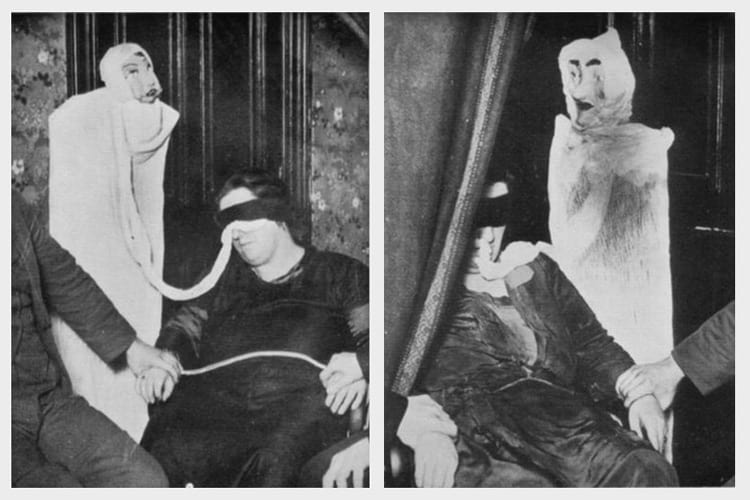
Fake ectoplasm appearing from Helen Duncan’s noes, made with the help of hangers and cheesecloth. (Harvey Metcalfe / Harry Price. Leaves from a Psychist’s Case-Book)
Duncan’s family and supporters maintain a website and online petition where they continue to campaign for her pardon. They say she offered people a service and that the Witchcraft Act was an outdated legislation – even then – which should never have been used at the time.
The Scottish Parliament has already once rejected a pardon. It sounds like Duncan was a charlatan however only she will know for sure if she truly believed herself to be psychic. Her use of fake ectoplasms would seem to signal no and that her exploits were rightfully punished.
Enjoyed this article? Also, check out “Church of the Dead: Home to the Peculiar Mummies of Provincial Italy“.
Recommended Read:
1. The Strange Case of Hellish Nell: The Story of Helen Duncan and the Witch Trial of World War ll | By Nina Shandler
2. Regurgitation and the Duncan Mediumship (Bulletin of the National Laboratory of Psychical Research) – 1931 | Harry Price
Recommended Listen:
The Last Witch Trial by Melissa Murray | BBC Radio 4
Fact Analysis:
STSTW Media strives to deliver accurate information through careful research. However, things can go wrong. If you find the above article inaccurate or biased, please let us know at [email protected].
RELATED
The post Helen Duncan: The Last Witch of Scotland appeared first on .
]]>The post Sky Burial: The Ritual of Feeding the Dead to the Vultures appeared first on .
]]>
Sky Burial: Vultures feeding on the deceased. (Babelstone / Wikimedia)
How would you like to be disposed of when you die? For many people in Asia, they will be left atop a mountain, to become food for vultures. This is a form of excarnation – common in many ancient societies – where the flesh and organs of the deceased are left for the birds and other carrion seeking animals. It is practiced in various Chinese provinces such as Inner Mongolia, the beautiful region of Sichuan and autonomous regions like Tibet and also, in some parts of India.
It comes from a long-serving tradition of Buddhism and in particular Vajrayana Buddhism which believes it to be a form of spiritual transmigration, the soul exiting the body. In other words, there is no need to preserve the body in any way because the soul has already left. This is only the case if undertook within a sacred Charnel ground.
Sky burials may sound barbaric to western ears but the fact is that it is a practical way of doing things. Releasing the body back to nature is a courtesy held in high regard in many of these cultures. The vultures that claim the flesh are known as Sky Dancers (‘Dakinis’) to many. They are seen as spirits, even forms of angels to many.

Vulture approaching during sky burial. (Chensiyuan / Wikimedia)
Evidence of age-old practice
The history of Sky Burials is estimated to date as far back as 11,000 years ago. However, the evidence is still not concrete on that. Archaeological findings from Göbekli Tepe in Turkey in the form of pillars seem to show the ritual. More concise findings take it before the inception of Buddhism which is between 6-4th Century BCE.
More recently, the first written mention of it comes from the 12th century – Book of the Dead – which includes procedures from a lama, a burial master charged with preparing the bodies and making the rituals. Towards modern times, however, Sky Burials are dropping in number. Many regions had the practice outlawed such as in communist times when the Chinese and Mongolian governments closed many temples. Communism is inherently atheist and considered it to be outdated. From 1960 to 1980 it was banned during the Chinese cultural revolution. This coincided with urban expansion causing the decline in vulture population also.
Sky Burial: The ritual
Although it sounds a harrowing end, the victims are treated with the utmost respect beforehand. As is the generous mantra of Buddhism the bodies are disposed of in such a grandiose manner in order to help as many others as possible. As mentioned the burials are practical: It is near impossible to dig holes in many of these arid regions. Also, it is not affordable to attain flammable materials to burn the dead.
The Burial Masters act as the undertaker and will keep the cadaver at the homestead of the deceased, covered in white cloth for 3-5 days before taken to the site of burials. They will burn items like Juniper incense to attract the vultures and some limbs may be divided for a cleaner kill if necessary. When only the bones are left they will be broken down by mallets and ground with Tsampa, a staple food for Tibetans, made of barley flour. Those remnants will become crow feed after the biggest birds depart. Otherwise, the bones will be buried.
In some cases, wild dogs will scavenge what the Dakinis leave. The birds play a big part in this ritual owning to the fact that if a lot of body remains untouched then the person has shamed in life or that the correct ritual conditions were not met.
Every Sky Burial is encouraged to be carried out in a jovial manner. Unlike many western cultures, it is not seen to be a sad occasion when someone dies. Based on the Buddhist doctrine of reincarnation – when the soul leaves the body at the point of death – the acceptance of our passing is to be met with an open mind and without fear.
A famous site which specializes in these practices is a Buddhist monastery called Drigung Thil in Tibet, 150 KM from the city of Lhasa. It became a touristic center with many visitors coming to experience a Sky Burial first hand. The monks later banned tourists as it is seen as bad karma for strangers to witness a burial.

Drigung monastery, overlooking the valley and sky burial site. (Antoine Taveneaux / Wikimedia)
It must be mentioned that Sky Burials are not the only way to dispose of the dead with cremation and water burials also carried out in these regions. Sky Burials, however, are certainly the most dramatic and fascinating.
Enjoyed this article? Also, check out “Tower of Silence: Where Zoroastrians Leave their Dead to be Excarnated by Scavenging Birds”.
Recommended Read:
Tibet, Tibet: A Personal History of a Lost Land | By Patrick French
Optional Visit:
Drigung Monastery | Maizhokunggar, China
Fact Analysis:
STSTW Media strives to deliver accurate information through careful research. However, things can go wrong. If you find the above article inaccurate or biased, please let us know at [email protected].
RELATED
The post Sky Burial: The Ritual of Feeding the Dead to the Vultures appeared first on .
]]>The post Dr. Robert E. Cornish’s Controversial Experiments to Revive a Dog’s Decapitated Head appeared first on .
]]>
Dr. Robert Cornish with one of the Lazarus pups. (Source: www.madscientistblog.ca)
Tales of Mad Scientists have been in existence for centuries now. And while many are criticized for being wacky, inhumane and downright psychopathic many can also be celebrated for making breakthroughs within various scientific fields. This is none more so than within the field of medicine where procedures today have origins from millennia ago; in medieval times and before them in prehistory. One such tale with a more modern spin comes from the 1930s in Berkley, California where an American called Robert Cornish attempted to bring the dead back to life.
Background of Dr Robert Cornish
Cornish was a medical phenomenon, graduating at 18 from the University of California and gaining a Doctorate at 22. He was a handsome chap but his eccentricity was soon apparent as one of his invention concept was a pair of spectacles to allow the reading of newspapers underwater. This may illustrate his intelligence; however as to gain a patent in those times was considered very noteworthy and could propel a person to fame. Cornish worked at the Department of Experimental Biology at a University when he began to get notoriety for something of a darker nature than underwater specs.
Revivification experiments
Dog-lovers read no further. Cornish began an experiment to cure the undead but not permitted to use human beings he had to operate on dogs. The doctor organized a public demonstration which Time magazine witnessed. He named his patients – five fox terriers – Lazarus after the mythical figure brought back to life by Jesus.
Robert Cornish tried many different techniques before gaining moderate success with the following. He would suffocate the animals first with either Nitrogen or ether. He would wait no more than five minutes after the heart had stopped to try and resuscitate. To do this he found a way to keep the blood circulating by using a piece of wood called a teeterboard, a type of see-saw to rock the patient up and down to maintain the circulation of blood.
Before re-animation, he would inject the creature with a concoction of saline, oxygen, adrenaline, blood as well as anti-coagulants and coagulants. Oxygen would be blown into the mouth via a rubber tube. Bear in mind this was in the 1950s when CPR and techniques of the sort were in their infancy meaning his methods were extremely right-field.
Outcome, criticism and dismissal
The first three dogs were revived but showed little signs of life after. The best result was Lazarus II who was in a coma for eight hours before passing again. The fourth dog – Lazarus IV – came back to life albeit blind and brain-damaged, Cornish reported that she recovered to near full strength in a matter of months. Lazarus V was the same but returned to normality in shorter time. These are the words of Doctor Cornish only however and were not confirmed by Time or anyone else it appears. Despite these factors, Cornish hailed his experiments a success.
The mad-cap doctor was heavily criticized and eventually fired from the UCLA Laboratory when protestations about the canine killings reached their ears. He was forced to do his experiments in the confines of his own abode and with pigs rather than dogs.
Attempts to secure fund and human subjects
Requiring funding Robert Cornish tried to clear his name by convincing people that his work was vital. This was through a movie titled ‘Life Returns’. Cornish played himself as does one of the Lazarus dogs. It uses a familiar aspect to pull at the heartstrings of the audience, with the doctor attempting to resurrect his son’s dead dog. It was the only way his son would love him again after all. The film was far from a success and ergo did nothing to improve the reputation of the doctor.
His next plan was to find a human patient. He searched the jails and found a willing convict called Thomas McMonigle, an inmate of San Quentin prison, convicted of killing a fourteen-year-old girl. The government declined the request on compassionate grounds. There is another rumour however which seems to be justified by newspaper reports from the time. This relates to the courts fearing a ‘double jeopardy’ clause. Death by the gas chamber which would have released the convict from his conviction and therefore he would have been a free man.
The experiments of Cornish continued and certainly will continue but at least now with more humane conditions we can hope. For it is a persistent quest of mankind to be eternal and although a scary thought it is one which will be pursued until completion. This is looking ever more likely and sooner rather than later with such incredible advances in medical science.
While Doctor Robert Cornish committed some very cruel acts can it be said that experiments like this are necessary in order to advance? To benefit the world in the long term? Is it worth the life of an animal, or a human to potentially increase the lifespan of another?
Enjoyed this article? Also, check out “Jose Delgado, the Pioneer of Electric Brain Stimulation Tamed a Raging Bull with Radio Control“.
Not Recommended Watch:
Life Returns (1935)
Fact Analysis:
STSTW Media strives to deliver accurate information through careful research. However, things can go wrong. If you find the above article inaccurate or biased, please let us know at [email protected].
RELATED
The post Dr. Robert E. Cornish’s Controversial Experiments to Revive a Dog’s Decapitated Head appeared first on .
]]>The post The Near Endangered Honduran White Bat of Central America appeared first on .
]]>
The Honduran White Bat. (Geoff Gallice / Wikimedia Commons)
Found within many countries of Central America, the Honduran White Bat – like many animals in the world today – is at the fear of extinction albeit at the safer end of the IUCN spectrum. The creatures are considered ‘Near Threatened’ on the International Union for Conservation of Nature scale. This means their struggle has not yet been taken seriously in terms of a worldwide acknowledgement. That is on the basis that even ‘Critically Endangered’ animals do not get sufficient attention with many species already extinct.
There are many reasons why this particular bat is special but one, in particular, is potentially beneficial to the human race. If that is a justified reason then these creatures should certainly be saved. And that is just one attribute which has been discovered. There may be more found once the elusive mammals are studied further.
Species profile
First we will have a look at the animals which many view with horror owning to the fact that many of their brethren are bloodsuckers. The famous myth of the Vampire contributes to this. However, these Hondurans are frugivorous, surviving almost exclusively on the fruit called ‘Figs‘. The largest to have been found are only 4.7 cm tall, extremely small and extremely light – at most, 5.6 grams.
They have almost all-white fur which is actually very uncommon; only five species of bats have this make-up. The main difference is the yellow parts on their face. In particular their ears, nose and lips. This colouring is caused by a chemical called carotenoids. Discovered in 1892, they are the first and only member of the Genus called Ectophylla which if you are interested in Etymology comes from the Greek for Leaf and Out – referring to its leafed nose.
Another name for this species is the Caribbean White Tent-Making Bat which illustrates its lifestyle. They make a habitat for themselves by cutting the vein of a leaf to make it fall into a tent shape. Nocturnal, they will roost here during the day and at night they will leave to look for food using the famous sonar system otherwise known as Echolocation (a similar system to dolphins and whales).
This tent system is extremely beneficial, keeping them protected from predators – an extremely intricate example of evolution. They remain in small colonies, clinging to the roof of the leaf until it dies and disintegrates. Although they will have a green hue within the leaf because the leaf is not completely closed they will sometimes be spotted by predators. However, if their white furs are spotted, many predators will assume them to be a wasp’s nest and stay clear. These predators include monkeys, owls, snakes and raptors.
As many as twelve bats can stay in the same tent for as long as 45 days which includes giving birth and guarding the young until they are fit to fly (which takes no more than 5 weeks). This is a small amount of their lifespan as although an exact number is unknown, members of the same genus can live up to seven years. And other species up to seventeen. Scientists believe these tent-makers to be somewhere in between these two numbers.

Honduran White Bat roosting under the leaf of Heliconia latispatha. (Leyo / Wikimedia Commons)
Why is the Honduran White Bat important?
As mentioned, the most important fact about these mammals relates to human health. So far they are the only animals discovered to be able to generate a visible colour change. The yellow parts; ears, nose and lips come from a chemical called carotenoids. The Honduran White Bat can perform a mechanism which uses this chemical to change skin pigmentation. The conversion of it is said to protect their retinas and conserve eyesight.
As contrary to popular belief bats have fully functioning eyes, they are just more active at night. The phrase ‘Blind as a Bat’ being a popular misnomer. Lutein is the name of said carotenoid which is found in the fruit eaten by the bats. It has been found that the animals are able to covert that Lutein into an esterified version which has many beneficial properties. With human eyesight, another well-documented problem, finding out how the bats convert this Lutein could solve many problems among humans and other animals.
A problem here is that the bats are threatened due to human expansion. Deforestation of the rainforests in particular, with farmlands taking over much of the land. As their diet is so reliant on fig trees this makes it difficult for them to adapt. Without mentioning whether losing a species like this is unjust or not, as it the case with many plants and animals they have desirable traits which could benefit mankind. Alas, these are dwindling as their ecosystems change and every day more and more secrets are lost forever.
Enjoyed this article? Also, check out “Hoatzin Reptile Bird: A Dinosaur-Like Bird with the Digestive System of a Cow“.
Recommended Visit:
Tortuguero National Park | Costa Rica
Fact Analysis:
STSTW Media strives to deliver accurate information through careful research. However, things can go wrong. If you find the above article inaccurate or biased, please let us know at [email protected].
RELATED
The post The Near Endangered Honduran White Bat of Central America appeared first on .
]]>The post Armoured Vehicle-Launched Bridge: A Bridge Over Troubled Water and a Real Life Transformers appeared first on .
]]>
M60A1 Armored Vehicle deploying its bridge over an unstable terrain. (Kevin Quihuis Jr. / USMC)
War has always been a lucrative business and now so more than ever. Weapons and vehicles designed for combat are among the mass manufactured items which are sold to the highest bidder. Knowing the spoils of war, these top bidders will pay an extortionate amount which is why vehicles like the AVLB (Armoured Vehicle-Launched Bridge) have been constructed and sought after.
When one thinks of a vehicle of war, ones boasting rockets and guns will automatically come to mind but the fact is that war requires brain as well as brawn, even more so during modern warfare. The AVLB vehicle follows this trend in supporting combat vehicles rather than entering combat itself. If ever an obstacle appears for example in the form of a canyon, river or trench it can create a literal bridge to the other side. It has the main body of a tank along with tank tracks underneath however the top section which is usually the weapons turret has been converted.
History of Armoured Vehicle-Launched Bridge
AVLBs are not a modern mechanism; their histories are rooted to almost a century ago during World War One when modern tank warfare was first implemented. It was common for battlegrounds to be in forest and farm regions, many of which would turn to trench fighting as the battlefield would turn to mud amidst constant bombardments and treacherous weather conditions.
An example is the Battle of the Somme in northern France during 1915, the first battle where modern tanks were used en masse. Tanks were designed to navigate harsh terrain in which would usually be a problem for some vehicles but still at times they would get held up, often via defensive tactics from the enemy. These early tanks would have implements called Fascines to help them overcome such territory – a series of wooden rods which could be rolled ahead to improve navigation. It was around this time that tanks began to carry bridges however with the technology still in its infancy the Fascines remained the preferred and trusted method.
By World War Two industrial advances meant even more tank production and upgrades were possible. The need for a bridge to secure crossings was also heightened with the war stretching across Europe and even into Asia and the deserts of Africa. One such tank became a frontrunner of bridge laying technology – the Cruiser Tank Mark V – commonly known as the Covenanter (after a religious sect) was employed into active service but had been at the training center since 1919.
The Covenanter series became a popular choice for the British Army despite early design flaws such as overheating. The first Covenanter Bridgelayer could roll to thirty feet and support 30 tons by 1944. Other creations including using the American Sherman tank body and the British Churchill chassis.
Popular models
On the side of the Axis, a Germany AVLB had the chassis of the famous Panzer series. It was named Bruckenlegen IV but was not deemed very effective by high command after it entered the war in 1940. This was during the tactics of Blitzkrieg, a tactic of rushing through your opponent’s territory which made success in battle ever tougher for heavy armour vehicles.

Bruckenleger IV German AVLB. (Courtesy: www.worldwarphotos.info)
Into more modern warfare the activity of the US army is well documented in the Gulf region. A popular AVLB is the M60 AVLB based on the M60 Patton Tank chassis. First deployed in 1987 and now designed in Alabama at the Anniston Army Depot, there are now around 400 of them in various parts of the globe used in both the Gulf and Iraq war. It has a bridge capacity of 60 feet deployed in a scissor formation. The bridge can be assembled in a matter of minutes and is even able to cross the bridge itself before reattaching. It is 13,000 KG and made mostly of aluminium.
The M104 Wolverine is now replacing the M60. Its bridge can reach 5 meters more and sets itself horizontally meaning it is better suited for covert operations. It can also support vehicles as heavy as 70 tons.

M60 AVLB deploying its bridge in scissor formation. (Tech. Sgt. Boyd Belcher / USFG)

The M104 Wolverine in an undeployed position. (20th Engineers Bn / USFG)
While maybe not the first item a war general would have on his shopping list, the importance of the Bridge laying device has certainly been shown. Many countries now have these vehicles in service showing their importance to battle and to various types of war campaigns. Famous examples include the SPRAT in France, the MT55, a Slovakian built vehicle manufacturing for armies within the Warsaw Pact like the Russian Federation. Also, the amphibious SYHK or ‘Samur’ which is Turkish for weasel.
Enjoyed this article? Also, check out “Mine Flail: Triggering Mines to Ensure Safety“.
Recommended Read:
Tank: The Definitive Visual History of Armored Vehicles | By DK
Recommended Visit:
The Tank Museum | England
Fact Analysis:
STSTW Media strives to deliver accurate information through careful research. However, things can go wrong. If you find the above article inaccurate or biased, please let us know at [email protected].
RELATED
The post Armoured Vehicle-Launched Bridge: A Bridge Over Troubled Water and a Real Life Transformers appeared first on .
]]>The post Laika the Canine Cosmonaut – From the Streets to the Stars appeared first on .
]]>
Laika training for her expedition. (NASA)
We all know the names Buzz Aldrin and Yuri Gagarin for being – conspiracies aside – some of the first people into outer space. Gagarin from Russia is considered the first man to orbit Earth in 1961 and in 1969 the Americans: Aldrin and co-pilot Neil Armstrong set foot on the moon. They paved the way for what is now a golden age for space travel with ideas hatching for passenger flights and plans to colonize other planets. But who paved the way for them?
Less is known about their counterparts, animal astronauts who have also voyaged – albeit forced – into the unknown, many in the name of the Space Race between the aforementioned countries. The most famous of these was a little Russian dog called Laika. In a time when conditions in space were unknown, Laika was chosen as a Guinea Pig before any human had made the jump. She was picked from the streets of Moscow to join the Russian space mission Sputnik II in 1961.
Why Laika?
According to the crew, Laika was around three years old, a mongrel female and unlike her name suggests [Barker] remained very quiet. Found in the Russian capital, her exact breed is unknown but almost certainly a cross between a terrier and some type of husky. Stray dogs were commonly used in previous preparatory missions because they can handle severely cold conditions and are ultimately less demanding.
The program picked a small female in terms of space-saving (for a spacecraft about the size of a washing machine, even leg-lifting was a factor). The good-natured mutt was quickly loved, birthing several Russian nicknames including Kudravka meaning Curly, Damka – Little Lady and Limonchik for Little Lemon. Muttnik would be her catchy handle in the English speaking world.
Read more: The story of the first primate in space that paved the way for manned spacecrafts.
The spacecraft Sputnik II would launch from the Baikonur Cosmodrome in modern-day Kazakhstan to test various cosmic conditions as well as the effects of space travel on an animal. The first Sputnik mission proved a success in orbiting the Earth and the second vowed to go further with a living creature in tow. Ultimately, Laika was a precursor to Yuri Gagarin, whose mission was already in the pipeline. Previous missions had also included dogs but they only reached suborbital conditions, this was to be a major step up. Veteran pups of those missions including a hound called Albina were to be backups. (Rumours say the crew got too attached)

Model of Sputnik 2 in which Laika travelled to space. (Laika ac / Flickr)
Preparation for launch
As launch day approached the darkness of the voyage soon began to sink in and there were protests around the world regarding the lack of humanity in proceedings. Such a mission today would cause an uproar, especially with the training which was brutal and by modern terms completely inhumane.
However, it was a different time back then, especially behind the Iron Curtain, with fewer objections aided by Cold War secrecy, Space Race obsession and a lack of Red Tape. Presumably, there would have been more protestation if people knew the truth. The truth that returning to Earth was never planned for Laika (a secret kept until 2002).
The crew have spoken more about this in recent times. They claim that the Soviet Union leader at the time, Nikita Khrushchev urged them to speed up the mission to coincide with the 40th anniversary of the Bolshevik revolution. It made several plans impossible to complete but Khrushchev was not a man to deny. In what was a cruel mission it is clear to see that the crew came to love the dog, whilst having to remain professional. They made a plan to euthanize her with a poisoned last meal if she suffered too much. They also made her a window. One scientist and trainer, Dr.Yazdovsky wrote that he took Laika home to play with his children on the night before launch.
“Laika was quiet and charming… I wanted to do something nice for her. She had so little time left to live.” he said.
Laika in space
The next morning was a Red Letter Day as the crew lamented and said their goodbyes. Sputnik II launched. Everything on board was monitored including Laika. At the start of the expedition, her heart understandably raced as the craft left Earth’s atmosphere but soon after, she started to calm. Her heart slowed and she continued to relax once reaching weightlessness. For the first time ever, a living being was orbiting Earth. She had made history. Within her harness, floating in Zero Gravity, Laika would have seen the blue and green of Planet Earth the way no-one had seen it before.
Perhaps she knew it was trees and water. Of course, the dog would be oblivious to the incredulity of events, and there is no doubt it was a traumatic experience but at least Laika felt some relief shown by her breathing. She even had some food before disaster finally struck. Her little heart started to race again and as temperatures rose, her panic took over. Eventually, there was no pulse detected and she was at peace.
The technicalities of her death are varied, it is simply claimed that overheating due to certain machine failures occurred approximately five hours into the flight. Laika’s death would have been a relief, also to many of the scientists once problems arose. The capsule became her coffin and after five months and over 2,000 orbits, they disintegrated upon reentry to Earth in 1958.
Later developments
Her death did not go unnoticed. Future space missions carrying animals were immediately made to be recovered after Laika’s death weighed heavy on the national conscience. As time went on more reforms took place and the callousness of the mission has forced many people to look back with regret none more so than the crew. Oleg Gazenko explains,
“Work with animals is a source of suffering to all of us. We treat them like babies who cannot speak. The more time passes, the more I’m sorry about it. We shouldn’t have done it … We did not learn enough from this mission to justify the death of the dog.”
Making such a difference for the greater good of the world would have been lost on Laika but she contributed more than most to the development of our world. Perhaps not in terms of aeronautics or space exploration but for animal rights and awareness, the little terrier became a martyr.

Laika on a Romanian stamp from 1959. (Wikimedia Commons)
She made the world remember that whatever we can achieve, we must do so humanely. She lives on in Star City, Russia, at the Russian Cosmonaut facility. There, a statue has been erected while all around the world Laika has been immortalized on items from posters to stamps.
Read more: Sex in space – is it possible? and why it is important
Recommended Read:
Soviet Space Dogs | Olesya Turkina
Recommended Watch:
Soviet Space Dog | BBC
Recommended Visit:
Science Museum | London
Fact Analysis:
STSTW Media strives to deliver accurate information through careful research. However, things can go wrong. If you find the above article inaccurate or biased, please let us know at [email protected].
RELATED
The post Laika the Canine Cosmonaut – From the Streets to the Stars appeared first on .
]]>The post 1972 Andes Plane Crash- The Descent to Cannibalism appeared first on .
]]>
Replica of Uruguayan flight 571 used in the 1993 biographical film Alive. (Pedro Escobal / Wikimedia Commons)
Surviving a plane crash may seem like a lucky escape. But not crash-landing deep into the South American Andes, the longest mountain range on Earth. This was the story on October 13th, 1972, when a small aircraft went down between the border of Chile and Argentina. It left 27 Uruguayan survivors who found no civilization in sight, periods of up to fourteen hours of darkness and temperatures as low as -35 ºF.
An already hopeless situation, an avalanche would soon worsen matters and before long they had to resort to cannibalism. It would not be until three days before Christmas when the aircraft wreckage was finally found, but… how could it possibly contain any survivors?
The ill-fated flight
The reason for the journey was a rugby match. A small Fairchild plane was chartered from Uruguay to Chile; onboard were 45 players and supporters. Unknown was the poor safety records of the company and when the pilots believed they had already passed the Andes, disaster struck.
The passengers felt something was wrong as they could see the peaks of the mountains very close. After some strong turbulence, one of the wings clipped a peak creating an explosion. The plane plummeted dramatically and sent the cabin tobogganing down a mountain. When the survivors came to a mental discernment, they saw a gigantic landscape wrapped in a ferocious blizzard. Some commented that they felt like insects among it.
Survival after the crash
A detailed account of the experience comes from Roberto Canessa, at the time a 19-year-old medical student. He quotes himself as being dropped from a life of privilege to absolute chaos, something like a scene from a horror movie. The corpses of many of the 18 victims – families and friends included – strewn around them.
They had limited food, drink, and clothes, while they had to use the broken fuselage as cover from the elements. Another student, Fernando Parrado gives his version of events. This was after being presumed dead for three days. Doctors later said that because he was left outside the plane, the icy temperatures preserved his brain from further injury. These two would become the main protagonists within the group. (Especially after Rugby captain Marcelo Pérez passed away).
Instinctively they tried to help as many people as possible. Using tactics which included melting snow through metal sheets into bottles, rationing food and organizing hikes around the mountain. They found as many extra materials as possible to shield from the cold and used others to form a massive cross and SOS, hoping to be spotted from above. This was impossible mainly due to the aircraft exterior being white, even with a commercial flight path above them. Each passing plane teased them more than the last.
Resorting to cannibalism
Nine days after the crash, things would get even more extreme. More people began to die due to the cold and lack of food. Hunger pangs began to dominate. Eating parts of the aircraft such as the material in the seats did not sustain them. They would have to think of an inhuman thought. But after what felt so long outside of humanity, they were no-one longer be thinking like humans.
Everyone started probing the same idea once their food sources ran out but they were unable to follow through. So they turned to God. A devout religious group of Roman Catholics asked God for guidance. One of the members Javier recited a New Testament verse, relating to Holy Communion:
“He who eats of my flesh and drinks of my blood will have eternal life. Take and eat, this is my body.”
The deciding factor for many including Nando Parrado was that they would have offered themselves if the shoe was on the other foot. Nando stated that it should not be called cannibalism but rather Anthropophagy – the eating of flesh – as they were forced to do it. Four of the men used razor blades and broken glass to rip open the skin. They would survive for longer solely for that reason. Apart from one man who was too repulsed to continue.
The rescue
Six days later, when the Uruguayans thought it couldn’t get any worse a strange noise came from above. An avalanche rocked the mountain and swept through the group to create an even more desperate situation. More died and the remaining survivors were stuck in the buried cabin for three days.
On another expedition, Robert found the tail of the plane which had more clothes, drink, some sugar and a camera. Robert found his luggage which smell must have been the most bittersweet, nostalgic feeling. Perhaps it gave him more inspiration to try and see home again. Back at the aircraft, news came from the outside world. Their transistor radio gave the information that the rescue search had been called off. At this stage, they started going on deeper missions to try and find help however the air was so thin and the snow so deep that it was impossible to get far.
They were running out of flesh and time. Roberto, Nando and one other made the decision to find help. Nando’s main reason was that two of the untouched dead bodies left were of his mother and sister – who had both died on impact. As Christmas approached Nando Parrado and Roberto Canessa would be the two to venture out and never return until they found help, or die trying.
The last words of the dying co-pilot made them believe they were closer to Chile. They would only have to climb one peak before they reached green pastures. In actual fact, they were on the other side, in Argentina. So it would take ten days of intense travelling: over 15 KM, climbing peaks as much as 15,000 feet and in snowshoes made from plane seats as well as sleeping bags made from cabin insulation.
After countless hours of hardship, they started to see colours; some grass and flowing rivers. Eventually, they found a figure in the distance. An Arriero – transporters who ride mules – and told him their story. They were saved! The Arriero rode ten hours to the nearest town and organized helicopters to ascend the Andes. Because of the weather, it would take two trips to get everyone home. Rescue teams stayed with the second group.

Roberto and Parrado after being discovered in Chile. (Hector Maffuche / Wikimedia Commons)
After spending 72 days on the mountain in total, 16 survived. It became and remains one of the most famous and inspirational survival stories in human history. Those who left the mountain all led healthy lives after the torment and met every year on December 22nd to honour the dead and celebrate life.
Roberto Canessa and Nando Parrado – the ones who showed the most courage of all return to the site every year. There is a grave marked there for the victims including Nando’s mother and sister, he also named the highest peak after his father – Mount Seler. Both men return to the point where they were rescued also, keeping in touch with their saviour – the Arriero – Sergio Catalan, to reminisce about a truly heroic story.

Flight 571 crash site. (Boomerkc / Wikimedia Commons)
A story about how resolute humans can be. Why we are still alive on this planet today after thousands of years and will be for thousands of years to come. Even after hardships such as these.
Enjoyed this article? Also, check out “A Tale of Resilience: Poon Lim, the Chinese Sailor who Survived 133 Days Castaway in the Atlantic Ocean“.
Recommended Reads:
1. Miracle in the Andes: 72 Days on the Mountain My Long Trek Home | By Nando Parrado
2. I Had to Survive: How a Plane Crash in the Andes Inspired My Calling to Save Lives | By Dr. Roberto Canessa & Pablo Vierci
3. Alive: The Story of the Andes Survivors | By Piers Paul Read
Recommended Watch:
1. Alive (1993)
2. I Am Alive: Surviving the Andes Plane Crash (2010) | History Channel
Recommended Visit:
1. Andes Tragedy and Miracle (1972) Museum | Uruguay
Fact Analysis:
STSTW Media strives to deliver accurate information through careful research. However, things can go wrong. If you find the above article inaccurate or biased, please let us know at [email protected].
RELATED
The post 1972 Andes Plane Crash- The Descent to Cannibalism appeared first on .
]]>The post The Antonov An-225: The Longest and the Heaviest Aircraft Ever Built appeared first on .
]]>
Antonov An-225 Mriya first public appearance at Gostomel Airport, Ukraine. (Oleg V. Belyakov / AirTeamImages)
The Soviet Union was known for its opulent grandeur, none more so than in the field of engineering. Antonov is the name of an aeronautical organization located in Gostomel Airport, Ukraine, famous for building behemoth vehicles. Between the years of 1984-88, they created an aeroplane which still remains as the biggest to ever be manufactured. It is called the Antonov An-225 or Mriya which means dream in Ukrainian. It has of course been heavily upgraded since those years when it was built to carry space shuttles and equipment from Moscow to Kazakhstan – where the Baikonur Cosmodrome lies. That was, unbelievably, the cheapest way of doing so.
Mriya is 84m long (almost as long as a professional football pitch) which is longer than the distance the Wright Brothers reached when they flew for the first time in 1903. It has a maximum speed of 528 MPH and a take-off weight of 640 tons meaning it is twice as heavy as the statue of liberty. The fact that constructs as heavy as Mriya can fly is truly phenomenal.

Antonov An-225 is equipped with three powerful D-18T engines on either side. (Dmitry A. Mottl / Wikimedia Commons)
When Mriya is expected thousands of people come to watch her land or take-off. Other features which impress aviation enthusiasts is the nose of the plane which can detach to allow cargo to be loaded and save weight. It also has a design called a twin tail for extra stability.
If you want to rent the Mriya, it is not cheap at $30,000 an hour. For this reason, it has not been used extensively only around once or twice a year but here are a few examples of its missions. In many of these, it has broken world records for its unique cargo hold capabilities. It was contracted to deliver 216,000 meals to the US military from Stuttgart, Germany to Oman.
In 2009, the heaviest ever single item was delivered to Armenia – a gas generator at an astonishing 189 tons. While the heaviest multiple cargoes was a series of pipelines weighing 253 tons. The longest cargo came one year later with two 42.1m wind turbine blades which came from China to Denmark. Then in 2016, the plane flexed its muscles even more by transporting a 130-ton cargo – another generator – from the Czech Republic (AKA Czechia), all the way to Perth, Australia.

Cargo being loaded in Antonov An-225 Mriya. (Robert Sullivan / Flickr)
Service during catastrophe
Projects like this can be criticized by many. People would ask where the humanity is and the reason for spending this amount of money but the fact is that Mriya can help people too. Humanitarian missions have included delivering generators to Samoa in order to fix electric stations damaged by the 2009 tsunami. The Japanese government also sent machinery to the island of Haiti by means of aid after the 2010 earthquake. Later the French government assisted the Japanese people during a similar catastrophe.
Mriya has recently caught the attention of a new buyer – AIC – the Airspace Industry of China. A private aerospace and defence company they have agreed to buy the An-255 program and within the next ten years, they hope to fill the sky with 1,000 planes. AIC is more interested in the newer version of the Mriya however. In terms of heavy lift – its transportation capacity is unmatched, even able to launch satellites into space at high enough altitudes.

The main landing gear of Antonov An-225. (Kārlis Dambrāns / Flickr)
The CEO of Antonov Airlines, Mikhail Karchenko is disappointed about losing the fleet but knows it is a necessary sacrifice. He stated:
“The Chinese want to buy from us this plane and there’s no harm in it, but of course no one wants to sell the aircraft. The Mriya is not separable from Ukraine, it’s like our child, and it’s something our children, and our grandchildren can always be proud of.”

Antonov An-225 in Sweden, 2012. (Larska / Wikimedia Commons)
Enjoyed this article? Also, check out “Why NASA Loves the Super Guppy Aircraft“.
Fact Analysis:
STSTW Media strives to deliver accurate information through careful research. However, things can go wrong. If you find the above article inaccurate or biased, please let us know at [email protected].
RELATED
The post The Antonov An-225: The Longest and the Heaviest Aircraft Ever Built appeared first on .
]]>The post What is a Life Size Model of Noah’s Ark doing in Kentucky? appeared first on .
]]>
A view of Noah’s Ark in Ark Encounter, Kentucky. (Olinej / Pixabay)
Most of us know the Bible story of Noah’s Ark where a flood of epic proportions threatened to wipe-out mankind and every land animal. Noah built a large ship under the guidance of God which catered for his family as well as two animals from every species. According to the Bible, every animal alive today branches from those who sought refuge on the ark and every human being are descended from Noah’s family. While many people have since resigned this story to myth there is a still a large following of believers none more so than in America.
In what is known as America’s ‘Bible Belt’ a themed family center has been constructed illustrating the conditions of Noah’s work and voyage. It is called Ark Encounter, situated in Kentucky, a southern state of the US. The brainchild of Christian fundamentalist Ken Ham, the Ark was planned by a group called Answers in Genesis whom he founded.
They also run a Creation museum in the same state. Funding was an issue for the vastly ambitious project so they collaborated with a corporation called Ark Encounter LLC. to help raise funds. This was controversial as it required over $100 million dollars which included $62 million from the city of Williamstown as well as many private donations. Non-religious and religious people alike argued that the money could have been better spent. Construction began none the less with over 1,000 Amish builders employed using timber and ancient techniques. It became the largest timber frame structure in the US.

Outside exhibits of Creation Museum, Kentucky. (Jelson25 / Wikimedia Commons)
Launch and response
It opened on July 7th, 2016 to commemorate Genesis 7.7; the chapter of the Bible in which Noah and his wife entered the ark. As before its opening, protestations and criticisms remain. One such comes from a famous presenter and engineer Bill Nye (commonly known as Bill Nye the Science Guy due to a television program he hosted). He debated with the creator Ken Ham on an opening day with the exchange being filmed.
From a scientific standpoint, many feel it is wrong to teach children scrupulous information including that the Earth is only 6,000 years old. From a religious viewpoint, they maintain that it is wrong to teach children that we are animals, relating to the theory of evolution. There are also other criticisms out of history. These are regarding the tax breaks received by the center and rumours that their hiring policy only accepts individuals of Christian faith.
Whatever the viewpoint, the Ark gained 1 million visitors in its first fiscal year which was considered a great success.
Attractions at ark encounter
Ark Encounter is a full-scale model as described in Genesis. It is 510 x 85 x 51 feet, a truly ginormous exhibit, bigger than a football field. There are three decks mostly with models of animals, dioramas of cultural exhibits and public facilities. There is a gift shop, restaurant and a petting zoo among other attractions on site.
A main feature of the Arc is to dispel any word that deems the schematics of the story impossible. For example, we can now estimate that there is over 1 million animal species and rising. This is a modern critique as people will say how could this amount of creatures fitted inside. A spokesperson for the center states that at the time of the Bible the term species was different and that the concept of a ‘kind’ of an animal was used. Simply put, if an animal can breed with another, they are in the same kind. There would have been about 1,500 animals on board they estimate, at most 7,000 so believers ascertain there would have been ample room inside. And of course insects and fish were left to their own devices.
Promotional video of Ark Encounter. (Source: Ark Encounter / YouTube)
One disagreement between sides is dinosaurs. Scientific research has found that early humans first appeared 6 million years ago, while the dinosaurs went extinct 65 million years past. Christianity puts them both together and so models of young dinosaurs are exhibited inside Ham’s design. Techniques are explained on waste management, ventilation, and feed, all of which using ancient methods.
It is not just animals that are inside the Ark, however. There are scenes showing Noah, his wife, his sons and information about the lives they lived are depicted. Also, Noah’s grandfather, Methuselah, another famous Bible figure who lived to be 969 years is mentioned. Displays show the situation outside of the ark also, during the floods where people were punished for sinful behaviour, for instance, the worship of false gods.
The exterior of the arc is illuminated at night, another cause for controversy. The site explains, “The Ark is illuminated with rainbow colors in the evening as a testament to the true meaning of the rainbow. After the Flood, God designated the rainbow as the sign of His covenant to never again destroy the whole earth with water.”
People believe this is in reference to Gay Pride. A criticism alluded to earlier is that employers must be of a straight orientation – something the center denies. The Encounter continues to increase in popularity despite these accusations. Or perhaps under the adage of ‘all publicity is good publicity’, the bad press is helping.
Either way, the Ark will be around for many years to come. And while live and let live should always be preached, science and religion can both be taught, how far do we go in terms of teaching children far-fetched versions of history? The problem with that, however, is that for whatever side you are on, no-one can disprove the other. And that will be the same for a long time to come.
Enjoyed this article? Also, check out “Gereja Ayam: The ‘Chicken Church’ of Indonesia Was Meant to Serve As a Prayer House for All Religions“.
Recommended Visit:
Ark Encounter | USA
Fact Analysis:
STSTW Media strives to deliver accurate information through careful research. However, things can go wrong. If you find the above article inaccurate or biased, please let us know at [email protected].
RELATED
The post What is a Life Size Model of Noah’s Ark doing in Kentucky? appeared first on .
]]>The post Rasputin, Faith Healer? Or Lustful Charlatan? appeared first on .
]]>
Rasputin in the center surrounded by his admirers in St. Petersburg, 1914. (Karl Bulla / Wikimedia Commons)
It’s amazing how some parts of history are condensed into tiny, sometimes cryptic and many times wrong examples. Take for instance, Marie Antoinette. Many people will know nothing about her role in the French Revolution, they will only know the quote, “Let them eat cake.” And apparently, there is no record of her ever saying it (it is attributed to a Princess before her time). Even so, whilst untrue it still illustrates why Marie Antoinette is famous, citing the power struggle between peasants and the elite. Other examples include Van Gogh’s ear, Isaac Newton’s Apple, Napoleon’s height and Edison’s lightbulb. While all stories are untrue or exaggerated, they still show that the apple doesn’t fall far from the tree – well, except in Newton’s case where it didn’t fall at all.
Troubled childhood
Born circa 1869, near the town of Tyumen on the cusp of Siberia, Grigori Yefimovich Novykh grew up on a peasant farm. It was treacherous living, so much so that seven of his siblings did not survive through childhood. A theme begins in his early life which dominates throughout his entirety. It is that much of Grigori’s life is clouded with conjecture based on rumours and eye-witness accounts.
Another theme forged is that Grigori had a dark reputation. He was a notorious drinker, womanizer, and a thief but naturally charismatic and handsome, many saw him as a lovable rogue too. Religion and the supernatural were major beliefs back then and Grigori became involved in such mysticism. Villagers believed he could cure horses and speak to God. He married a village girl Prastkovya in 1887, they had four children, the most famous of which would be Maria.

A photo of Rasputin with his three children. (Wikimedia Commons)
Unholy preacher
At 28 he became obsessed with Religion. The belief of the land was Orthodox Christianity but Grigori delved into offshoots too. He embarked on several religious pilgrimages, even venturing as far as Greece on one occasion. His activities made him known among the Orthodox clergy and brought him many followers but also controversies.
Some of his teachings were said to be unholy and illicit. For instance, Grigori was accused of joining the Khlysty, a sect which seceded from Orthodoxy. They were said to indulge in ritualistic orgies and flagellation. It seems obvious that Grigori was involved in such practices as he requested to be renamed ‘Rasputin’ (‘Debauchee’ in Russian). It represented that he believed true salvation must be attained through sin. Despite these suspected indecencies, through various connections, he climbed the holy ladder. Grigori made it to St Petersburg, the then capital of Russia (2.500 KM from Tyumen) where the leader of Russia – Tsar (named for Caesar) Nicolas II – ruled and formed a close connection with the wanderer.
Mystical healer
Preaching Christianity would be a backstory as Rasputin’s rise was mainly due to curing the Tsarevich, the Tsar’s only son and future ruler. The boy Alexei suffered from haemophilia – meaning he was susceptible to abnormal bleeding. Rasputin drove away doctors and consistently improved the boy’s condition meaning his mother, the Tsarina, cried him a miracle healer. The Siberians influence grew, he was given a flat in the center of St. Petersburg and roles within the government.
Rasputin: The unkillable monk
Again, controversy followed Rasputin. Accounts say he was far from coy when taking in prostitutes or even female members of the aristocracy to his flat. He was denounced for devil worshipping, of using the Tsar as a political weapon and of having an affair with the Tsarina. It is said that others including the British accused both him and the German-born Tsarina of being German spies.
This is where Rasputin became infamous as the monk who couldn’t be killed. At this time in Russia, there were many devout Christians as well as political parties vying for power and someone took umbrage. He was first stabbed by a vagrant in the stomach but survived. That assassin’s motives are still unknown.

A photograph of Rasputin from 1916, the year he died. (Wikimedia Commons)
This attempt would be a prelude for when members of the nobility led by a rumoured cross-dresser named Felix Yuposov attempted an assassination. They believed Rasputin had too much power as the Tsar was out of Russia during the break of World War I.
Yuposuv invited him to dinner. He poisoned his cakes and wine, shot him three times including once in the head and finally rolled him in a carpet, throwing him out of the balcony into the sub-zero River Volga. Finally, the Siberian was deceased. His adopted family the Romanovs did not have time to mourn. A political coup meant that they fled east only to be butchered in the basement of a winter palace.

Dead Rasputin with a bullet in his head. (Wikimedia Commons)
His life and motives are impossible to fully comprehend but some light has been shed on his practices. Firstly, the world was a very different place then, where religion and the supernatural were considered truth. And even those who did not believe were forced to follow it for fear of castigation. Rasputin was an extremely charismatic man, mixed with extreme confidence and bravery which of course can get one very far. There are clips online which show famous hypnotists such as Derren Brown showing its power, many believe Rasputin was adept.
As for the healing, historians now have the idea that Grigori’s insistence for doctors to leave Alexei, did actually help. By denying him pain-killing medicines like Aspirin which is said to thin the blood. Then there are more outlandish claims. In the theme of sex sells, Rasputin’s weapon was believed to be below his belt. A thirteen-inch penis which is said to be on display at the Russian Museum of Erotica after being sold among various second parties. The madness didn’t stop even when Grigori died.
Aftermath
His daughter Maria fled Russia after her father’s death and became a lion tamer in the US. If sources are to be believed she named her dogs after the killer Yupusov. But that’s another story, as is that of the Romanov family who also proved extremely tough to kill. To learn more about Rasputin, there are many books available including accounts from his daughter Maria, and killer Felix Yuposov. There is a film starring Alan Rickman, an actor worthy of the role.
Also, the tale of Harbard in The History Channel’s Vikings is a mirror image of the Russian; a wanderer who heals Ivar the Boneless and then seduces his mother, the Princess Aslaug. Stories of holy wanderers are notorious in every religious circles and Rasputin was not the first and certainly won’t be the last.
But perhaps, he was the oddest.
Enjoyed this article? Also, check out “Ivan the Terrible: The First Tsar of Russia and His Reign of Terror“.
Recommended Reads:
1. Nicholas and Alexandra: The Classic Account of the Fall of the Romanov Dynasty | By Robert K. Massie
2. Grigori Rasputin: A life From Beginning to End | By Hourly History
Recommended Watch:
1. Agony (1981)
2. The Real Rasputin (Imperial Russia Documentary) | Timeline
Recommended Visit:
1. Moika Palace | Russia
Fact Analysis:
STSTW Media strives to deliver accurate information through careful research. However, things can go wrong. If you find the above article inaccurate or biased, please let us know at [email protected].
RELATED
The post Rasputin, Faith Healer? Or Lustful Charlatan? appeared first on .
]]>The post Kangbashi, Ordos – Ghost City? Economic Ingenuity? Or Both? appeared first on .
]]>
Empty streets and buildings in Kangbashi District. (© Carla Hajjar / Used With Permission)
China is another world. That is the view of many outsiders when they think about the People’s Republic of China due to the sheer vastness of it. With so much land, masses of inhabitants and many different cultures, intricacies within are often unheard of. As a nation of over 1.379 billion people and 9,596,961 Km² getting your head around the numbers alone is a task enough.
One such intricacy is the emerging abundance of ‘Ghost Towns’; urban areas which resemble a post-apocalyptic movie or post-war zone. And while there are abandoned places on every continent, the sheer scale and increasing amount of these Chinese versions are drawing attention. While they seem to show something sinister or an economic failing, looking into the subject deeper gives another understanding. That they are not ghosts of the past but rather apparitions for the future.
Building a modern sector
In a region known as Inner Mongolia, covered by deserts there is a region called the Ordos with sprawling urban districts. It is home to many extravagant government projects encouraged by a large discovery of coal mines. One such project is called Kangbashi which was set to become the largest district, originally able to accommodate one million people. It was constructed to become the administrative center of Ordos, taking over from neighbouring district Dongsheng. Being closer to water reservoirs is the main reason why.

A quiet street of Kangbashi. (© Carla Hajjar / Used With Permission)
Minus the people, Kangbashi looks relatively ordinary in terms of a modern Chinese city. As it is a young urbanization the government has had to create a sense of history as well as artistry. Monuments have been erected to honour the Mongolian ruler Genghis Khan, a controversial figure who was said to unify the Chinese people.
There are also many statues such as horses relating to nomadic Mongolian traditions. Around them are parks, museums, and shopping malls. The curious case ends here, however. While it is exciting to portray the Chinese city as a mysterious haunt like Pripyat – the town near Chernobyl – Kangbashi is no more than government planning. And judging by China’s success in recent years, presumably clever planning at that.
Just as the old saying goes, “Rome wasn’t built in a day”, Xing Su, an official of Ordos answers the situation. And to look at another, the commonly wrongly quoted “Build it and they [he] will come.” from American baseball movie Field of Dreams seems more pertinent. Kangbashi was created only six years ago. Meaning the abandoned aspect at the moment is simply the transition between construction and inhabitation. Only 100,000 people live there currently (if figures are to be believed) but the government is not worried. Simply put, Kangbashi is not an accident, nor a failure. The Ordos is already a prefecture-level city and this new district is a common economic strategy. As it is cheaper to build a new rather than to refurbish, it will become the new administrative center without the need to change or destroy the old one.
Inhabitation
Officials report that the population is steadily increasing and will continue to do so with 80-90% of apartments having already been sold. This is again a common place in China for future investment, real estate still booming from the wealth created from coal veins.
There is still a problem at the moment, however. Because there is little population it lacks atmosphere and activities causing people to commute from Dongsheng which is the go-to place for shopping and entertainment.
Residents comment that Kangbashi is a car city, the size deeming it not sensible to walk anywhere, making people order online and live in their apartment complexes after work. This leaves the streets empty and while Kangbashi is beautiful, clean and fresh there is not much to do.

An empty mall in Kangbashi. (© Carla Hajjar / Used With Permission)
Government efforts
In effect, the government are looking for ways to improve the city and increase the flow of inhabitants. As the only economic interest is coal, other avenues are necessary to make it a truly functioning metropolis. Car manufacturing plants are being designed and many start-up companies are encouraged too. A national sports stadium has been built which can hold 35,000 spectators as well as a Formula One track in the shape of a horse.
The 2012 Miss World competition was also recently hosted. The ghastly nature of the city is starting to become an idea for adventure tourism with photographers and journalists flocking to the city. They can experience tours that run to the Mausoleum of Genghis Khan, less than 55km away and an area called Xingshawan which has expeditions to the nearby sand dunes. Chinese citizens are also offered many benefits to relocate and become part of the community.

An empty Great Kangbashi bridge. (Popolon / Wikimedia Commons)
Kangbashi has certainly been debunked as a traditional Ghost Town but still holds many of the said qualities. Despite that, it would appear the future is bright here and instead other, older districts such as Dongsheng have the greater danger of becoming abandoned. Alas how long until Kangbashi becomes the next Dongsheng.
Enjoyed this article? Also, check out “Replica Constructions of World-Famous Cities and Towns in China: Tianducheng, Thames Town, and Hallstatt“.
Recommended Visit:
Kangbashi District | China
Fact Analysis:
STSTW Media strives to deliver accurate information through careful research. However, things can go wrong. If you find the above article inaccurate or biased, please let us know at [email protected].
RELATED
The post Kangbashi, Ordos – Ghost City? Economic Ingenuity? Or Both? appeared first on .
]]>
































